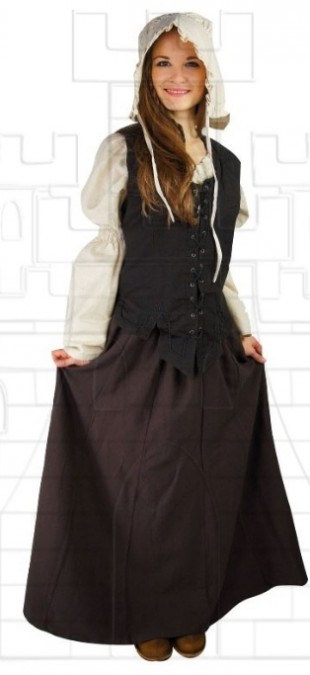Clothing and Accessories
Find the best selection of clothing and accessories to enhance your style. From classic pieces to the most modern accessories, our Clothing and Accessories category is designed to cover all your fashion needs.
Combine your outfits with elegance and comfort, always with the quality that distinguishes us. Whether for a special occasion or for everyday, here you will find everything you need to express yourself with confidence and style.
The brial is an emblematic garment that symbolizes elegance and sophistication in women's clothing during the Middle Ages. This long, fitted dress was often made from high-quality fabrics such as silk, but could also include other rich fabrics like wool or velvet, and was distinguished by its unique design. The brial was characterized by fitting at the waist, allowing the fabric to fall straight down or in a gentle circle to the feet, creating a sculpted silhouette that enhanced the female curves.
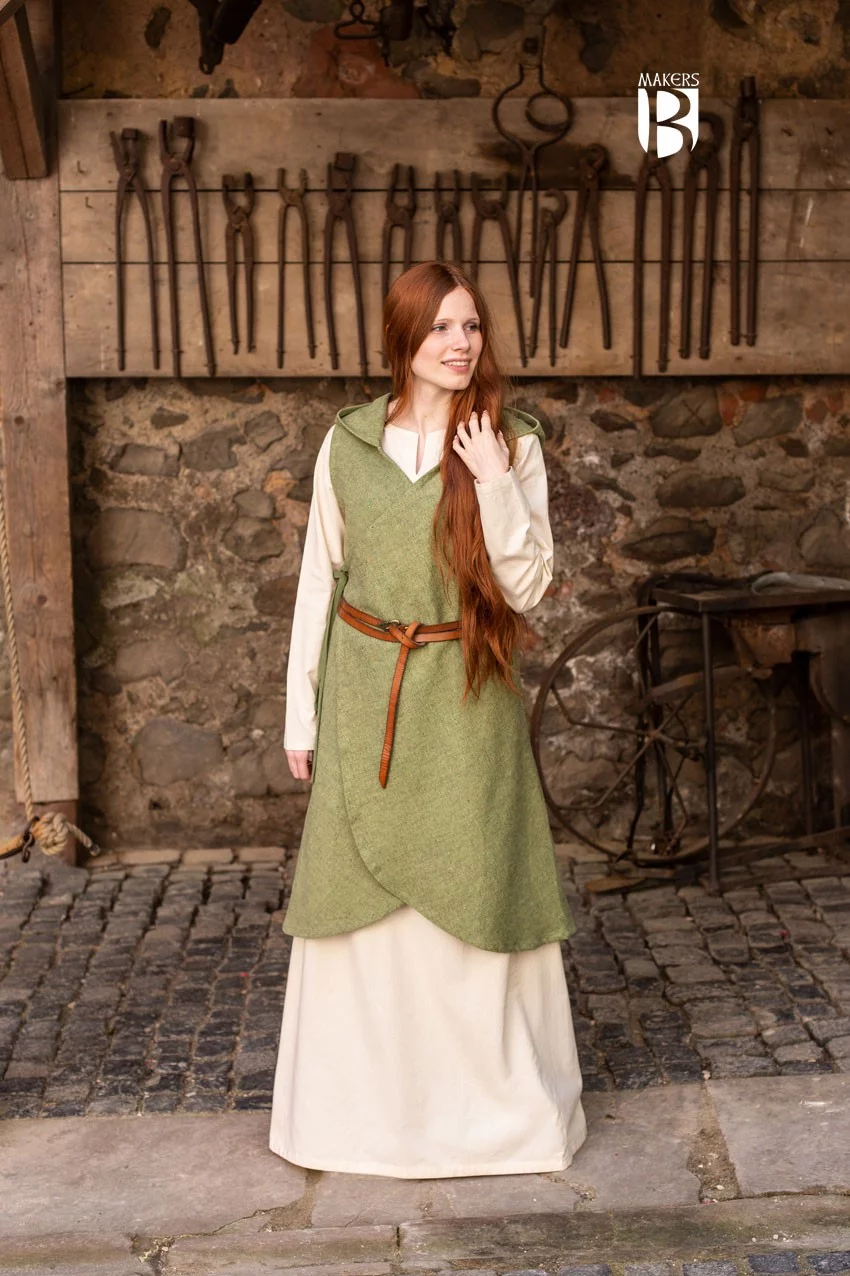
Beyond its function as clothing, the brial was a symbol of wealth and social status. These dresses were often adorned with elaborate embroideries, lace, pearls, and other luxurious details, making them an ideal choice for special occasions, such as banquets, religious ceremonies, and noble events. Furthermore, the brial was seldom worn alone; it was common for it to be accompanied by other wardrobe elements such as headdresses, mantles, or capes, and accessories like jewelry that further enhanced the wearer’s look.
During the Middle Ages, the use of the brial spread throughout Europe, being adopted by both the upper classes and the more humble. However, the variations of the brial always reflected the economic and social position of the wearer. Over time, brial designs evolved, adapting to contemporary fashions and presenting a wide range of colors, styles, and fabrics, allowing it to maintain its relevance throughout the centuries.
In this sense, the brial manifests not only as a garment but as a true reflection of the cultural and social identity of medieval women. Its sophistication and beauty endure over time, inspiring contemporary fashion, and its legacy can be seen in many current trends. Its history is intrinsically linked to the evolution of fashion and social norms of its time, making it a fascinating object of study for historians and fashion lovers alike.
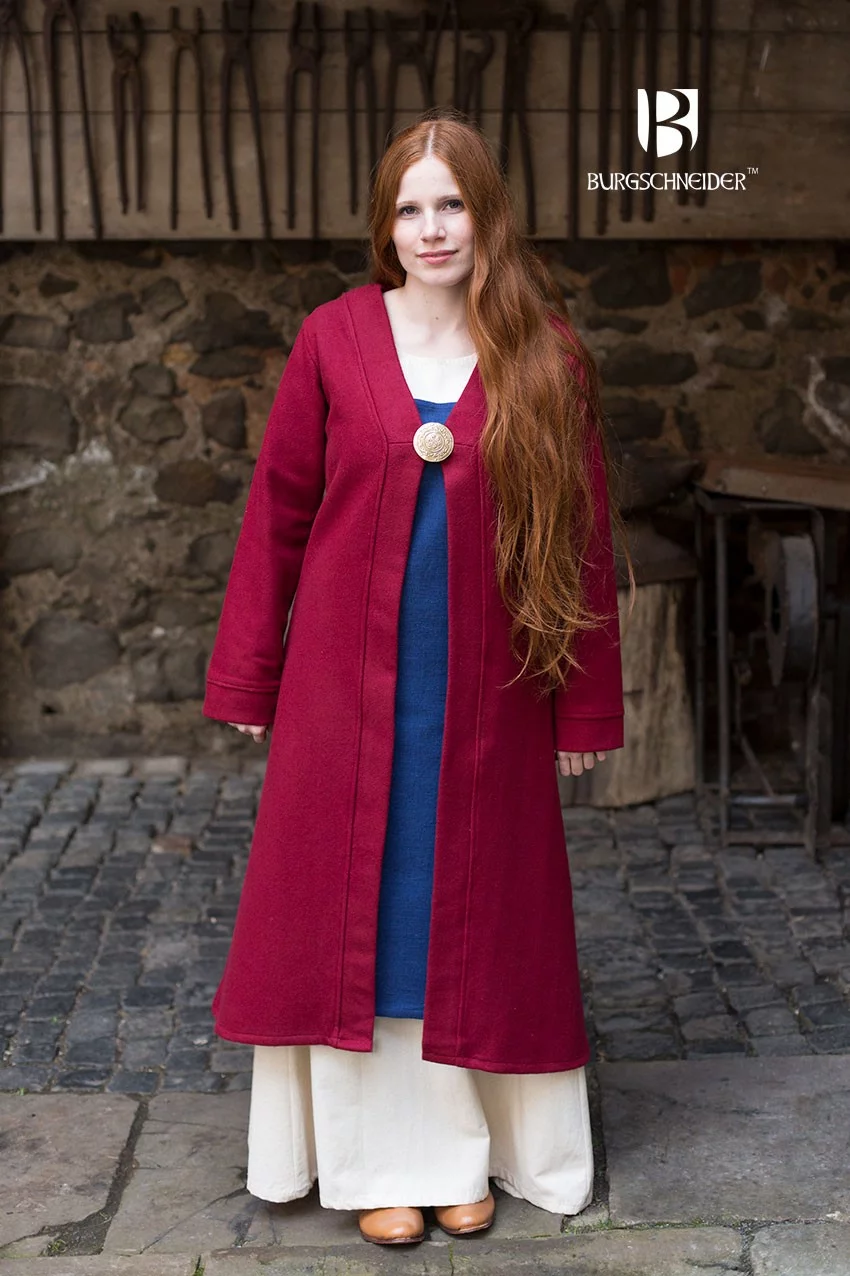
If you are interested in learning more about this fascinating garment, we invite you to explore our collection of brials. Here, you can discover a variety of styles and designs, each with its own history and charm, reflecting the rich textile tradition of the medieval era.
The almófar, also known as the verdugo or coif, is an iconic piece of medieval armor designed to provide protection to the head, neck, and shoulders on the battlefield. Its design, which included a flexible structure, allowed warriors to move with greater agility compared to more rigid armors. Among the most notable varieties are the camail and the aventail, each with particular characteristics that increased effectiveness in defense.
The camail is a specific type of almófar made of interconnected metal rings, forming a mesh that was worn over the head and extended down to the shoulders. This protection provided excellent defense against cuts and punctures, acting as an additional barrier in combat. It was a fundamental piece of equipment for many knights and soldiers of the time, not only for its defensive utility but also for its imposing appearance.
On the other hand, the aventail consists of a chainmail hood that attaches to the bottom of the helmet, extending to cover the neck and shoulders. Its design was aimed at protecting these vulnerable areas of the body from direct attacks, ensuring that the warrior was well-protected during combat. Often, aventails were crafted with great skill, which also reflected the status of the wearer.
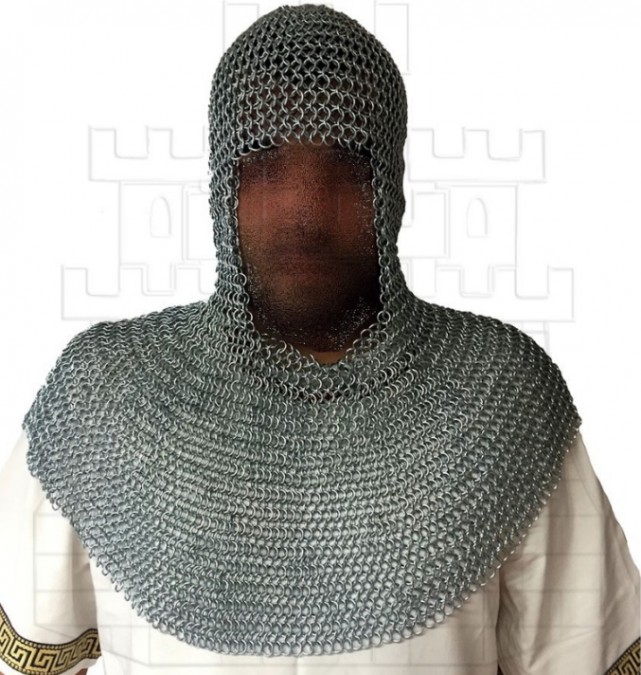
In the Middle Ages, the almófar was not only a tool of defense; it also held a symbolic component. The quality and design of the armor, including the almófar, could indicate the rank and wealth of the warrior. Moreover, almófars were subject to combat practices and the development of military strategy, making them a fascinating element in military history.
In conclusion, the almófar, in its various forms like the camail and the aventail, played a crucial role in protecting medieval warriors, safeguarding vital areas of the body in a time when battle was a constant in life. The study and understanding of these pieces offer us a deeper insight into the armor used in that era and the importance of each component in the survival of warriors on the battlefield.
The tabard is a piece of clothing with deep historical roots that has endured from the Middle Ages to the present day. Originally, it was a heraldic robe, primarily used by heralds and kings-at-arms, who played important roles in the court. Its design is characterized by being a long and loose garment, covering the body from the shoulders to the knees, making it a comfortable and functional choice.
Traditionally made with heavy fabrics like wool, the tabard can also be made of velvet or other luxurious materials. What truly distinguishes it are the adornments, which include coats of arms, insignias, and heraldic shields. These emblems are not merely decorative; they serve to identify the social position, authority, and affiliation of the person wearing it. The rich symbolism contained in each tabard reflects the history and lineage of those who wear it.
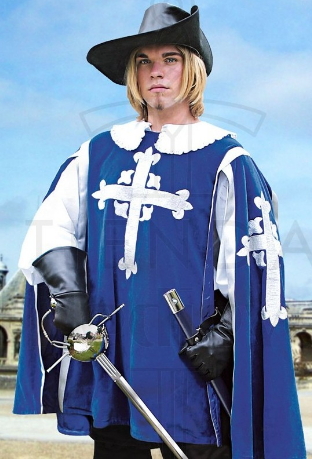
Over the centuries, the tabard has found its place in a wide variety of contexts, ranging from noble attire to its use in religious orders. In official ceremonies, the tabard continues to be a symbol of status, as well as in certain medieval sporting events, such as jousts. Its presence in historical events highlights its value not only as a garment but as a cultural emblem of past eras.
Today, the tabard remains relevant, as certain institutions, such as the mace-bearers of the Courts, use it to manifest their authority and function. Although it is not commonly seen in daily life, its legacy endures, becoming a symbol of prestige and distinction in formal contexts.
In conclusion, the tabard is not just a piece of clothing; it is a reflection of history, art, and culture, that continues to be appreciated in ceremonies and emblematic events. Its relevance today demonstrates that, despite advancements in fashion, the tabard maintains its iconic status as a symbol of authority and tradition.

The crespina is a female headdress that was used in the Middle Ages, specifically between the 13th and 15th centuries. This elegant accessory consisted of a delicate net cap, often made of silk, which fitted the head to hold and gather hair in a practical and stylish way.
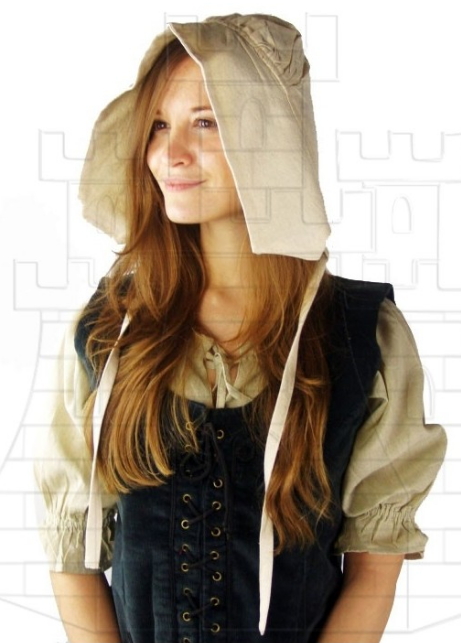
During the Middle Ages, the headdress not only served an aesthetic function but also acted as a symbol of social status. In this sense, the most luxurious crespinas were adorned with embroidery, pearls, and other ornamental details reflecting the wealth and status of the wearer. Thus, they became a mark of distinction and a crucial element of aristocratic female attire, as well as for middle-class women on special occasions.
The crespina was commonly used in combination with other garments of the time, such as caps, cloaks, or capes, in addition to jewelry that further enhanced the elegance of the outfit. Over time, this headdress underwent various stylistic modifications, becoming a key piece of medieval female wardrobe. Variations in its design included different shapes, sizes, and techniques of making, adapting to the fashion trends of each period and the needs of each woman.
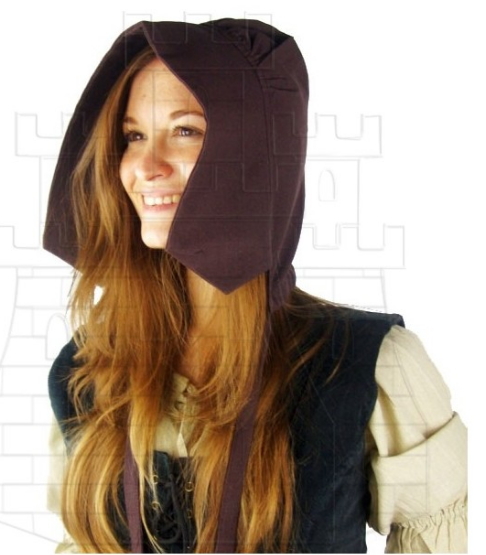
In summary, the crespina not only represents a functional headdress, but it is also a symbol of the fashion and culture of the Middle Ages. Its evolution over time reflects changes in female attire and social norms of the era, making it a fascinating and significant element within the history of clothing. Delving into the world of the crespina is to explore not just an accessory, but an important part of the cultural heritage that continues to evoke interest and admiration today.
Pantaloons are a garment with a rich history that dates back to the Middle Ages, and their design has evolved significantly over the centuries. They are a piece of fabric that covers the legs, varying in length from the waist to the knee or ankle, depending on the style and era.
In a masculine context, pantaloons became a popular outer garment during the 15th, 16th, and 17th centuries. They were made from a wide range of materials, including linen, cotton, silk, and velvet. During the Renaissance, pantaloons were characterized by their loose and flared shape, while in the Baroque period, tighter and fitted pantaloons became popular, accentuating the male figure. They were commonly paired with other garments, such as shirts, jackets, and various types of hats or hoods, contributing to an elaborate and sophisticated outfit.
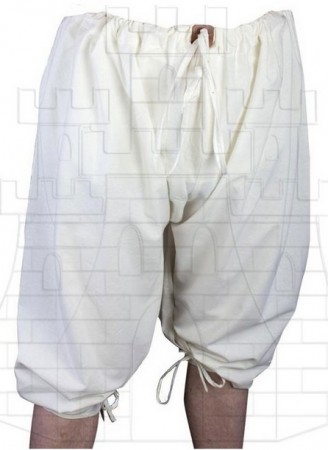
From a feminine perspective, pantaloons took the form of undergarments designed to cover the legs and pelvic area. These garments varied in style, from loose, long pantaloons to shorter, fitted versions. Women’s pantaloons were often adorned with lace, embroidery, or ribbons, adding a touch of elegance and distinction to the attire. These functional and aesthetic differences reflected the fashion expectations and active gender roles in the society of the time.
Pantaloons, therefore, not only represent a functional garment but also a cultural and social manifestation that has changed in form and meaning over time. Ultimately, pantaloons illustrate the evolution of clothing and its adaptability to various fashion trends and practical utility in everyday life.
The saya is a fascinating garment that dates back to the Middle Ages, designed to cover the body from the neck to the feet. Considered the predecessor of the modern skirt, the saya has played a fundamental role in the fashion of past eras, especially in women's attire. This clothing was made in a wide variety of fabrics, ranging from linen and cotton, ideal for everyday use, to luxurious materials like silk and velvet, which were reserved for special occasions and those of higher social status.
The saya was not worn alone, but was part of a more elaborate outfit. It was common to combine it with a belt to define the waist, a coif or hood to cover the head, and a cloak that provided warmth and elegance. These accessories not only served a practical purpose but were also a form of personal expression and a way to manifest the wealth and social status of the wearer. In fact, sayas could be adorned with intricate embroidery, fine lace, and jewels, becoming a symbol of distinction.
It is interesting to note that in some contexts, the saya was also used as a male garment. In such cases, the saya could be shorter and made of more durable materials, thus adapting to the work and daily activities of men of the time. This illustrates the adaptability of the garment and its place in the daily wear of different classes and genders.
Therefore, the saya is not simply a garment, but encapsulates a significant part of the history of medieval fashion, reflecting various social and cultural functions. Its design and construction varied by region and time, making it a fascinating element that continues to intrigue lovers of history and fashion.
The medieval hose are an iconic garment of clothing during the Middle Ages, designed to cover the legs from the waist to the feet. Originally made from materials such as wool, linen, or silk, these garments were common in both male and female wardrobes, reflecting the rich diversity of medieval fashion.
The hose had various characteristics, including their fit and length. Some were tight, conforming to the contour of the leg, while others were loose, providing greater comfort and freedom of movement. In terms of length, there were short hose that reached the knee, and longer ones that covered the entire foot, fastening to shoes or boots with laces or buckles. This versatility was essential, not only in the context of fashion but also depending on the activities being undertaken.
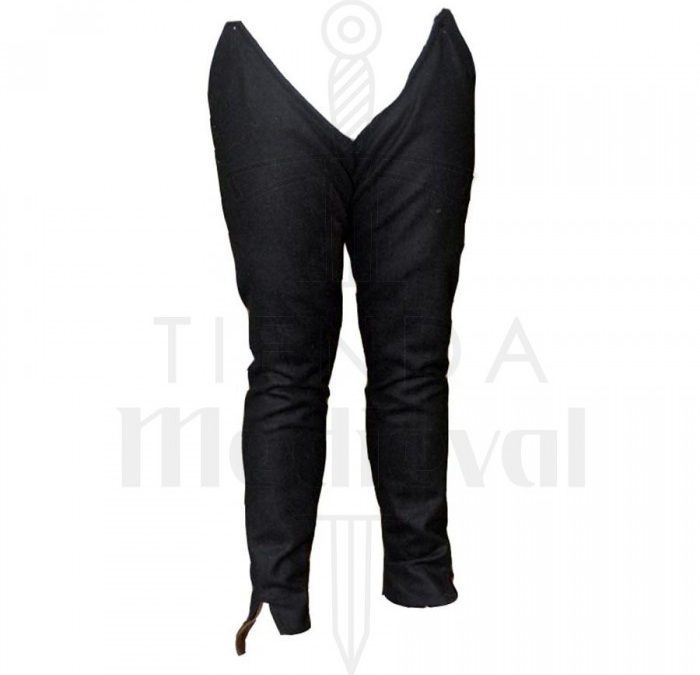
In addition to their aesthetic function, the medieval hose played a practical role in armor. Some versions of these garments were padded, providing an additional layer of protection for the legs during combat. Others were used as a base under chain mail, preventing the metal rings from irritating the skin of the wearer. In this way, the hose not only contributed to individual style but were also an indispensable tool for protection for warriors.
The medieval hose were undoubtedly a key garment in the wardrobe of the time, used in various situations, from everyday life to warfare. Their impact on fashion and body protection reflects how clothing in the Middle Ages fulfilled multiple functions, combining aesthetics and functionality.
A chainmail is a type of flexible armor made up of thousands of small interlinked metal rings, forming a kind of metal fabric. This type of armor has been used throughout history due to its unique features, ensuring a balance between protection and mobility.
Structure and Composition
The chainmail is characterized by:
- It is made of metal rings, usually iron, linked together in a pattern known as "4 in 1". This pattern means that each ring connects with four others, providing a solid and durable structure.
- It mainly covers the torso, although it can extend to the arms and thighs depending on the specific design of the armor.
- Its average weight is around 10 kg, although it can vary according to the dimensions and specific design of the chainmail.
Functionality and Protection
Chainmails offer notable effectiveness in protecting their wearers:
- They provide excellent defense against cuts and thrusting weapon attacks, although their effectiveness decreases against blunt impacts, such as blows from a mace or a bludgeoning sword.
- They are flexible, allowing for good mobility for the user, being light enough to facilitate use in prolonged combat.
- They were commonly used in combination with a gambeson, a padded garment worn under the chainmail to increase comfort and effectiveness in protection.
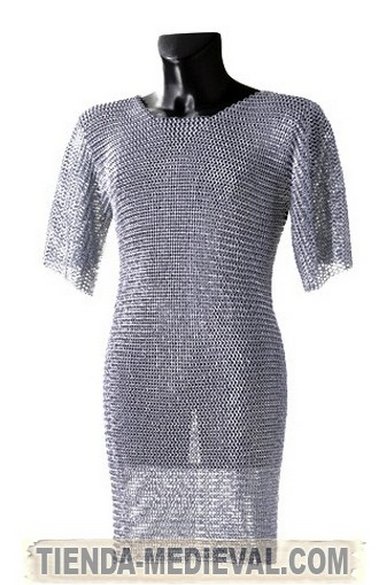
Historical Use
This type of armor has had a notable historical presence:
- The chainmail was widely used from antiquity to the Middle Ages, being especially popular between the 12th and 13th centuries in Europe.
- The Romans adopted and perfected this type of armor, naming it "lorica hamata".
- Its use began to decline in Europe from the 14th century, gradually being replaced by plate armors that offered greater protection in vulnerable areas.
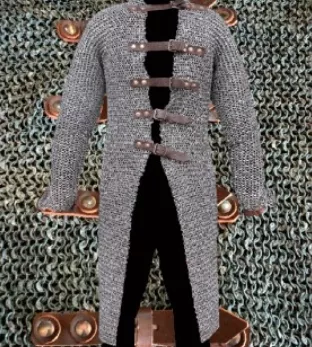
The chainmail stands out for its flexibility, versatility, and ease of repair, making it one of the most durable forms of protection in military history. Its design allowed warriors to move more freely, making it a preferred option both on the battlefield and for ceremonial displays.
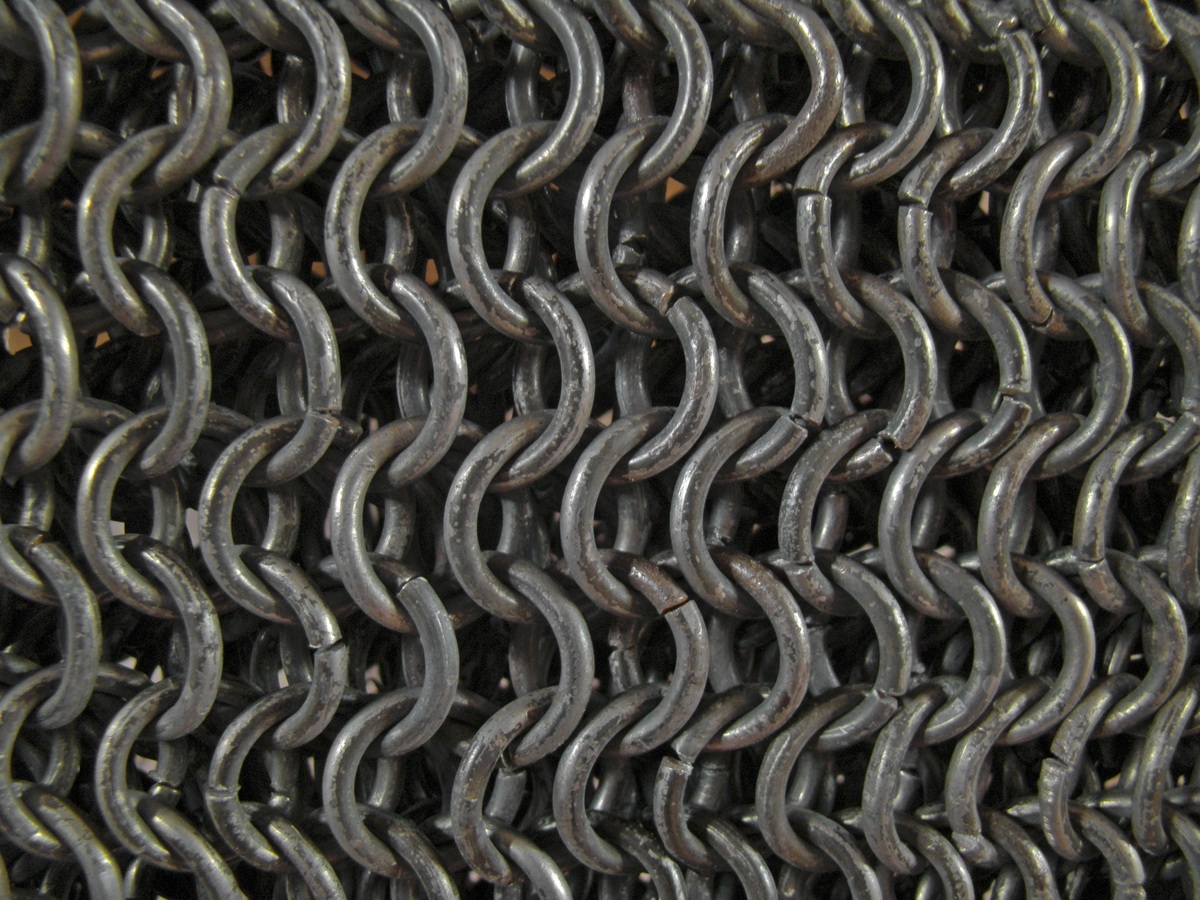
Although chainmail is effective against cuts and thrusting weapons, its flexibility offers less protection against blunt force. Therefore, when combined with a padded garment like a gambeson, protection is significantly multiplied, creating comprehensive defense in combat situations.
The parlota is a head accessory that had notable popularity in Spain during the 16th century. This headdress is distinguished by its wide, flat design, often made from materials such as woolen cloth, cotton, or velvet. The parlota was not just a fashion item; it was also a symbol of status and elegance in medieval and renaissance contexts.
Characteristics of the Parlota
Materials: Most parlotas were made from woolen cloth, which provided durability and warmth. However, there are also versions made from cotton or velvet, each offering a different texture and use to the accessory.
Design: The characteristic shape of the parlota, with its wide and flat structure, gives it a distinctive appearance that can vary slightly depending on the region and historical period. This design was not only attractive but also functional for protection against the weather.
Use: The parlota was a unisex headdress, worn by both men and women. It could be seen in various contexts, from everyday life to important social events, and was common in the attire of the upper classes, reflecting the fashion of the time.
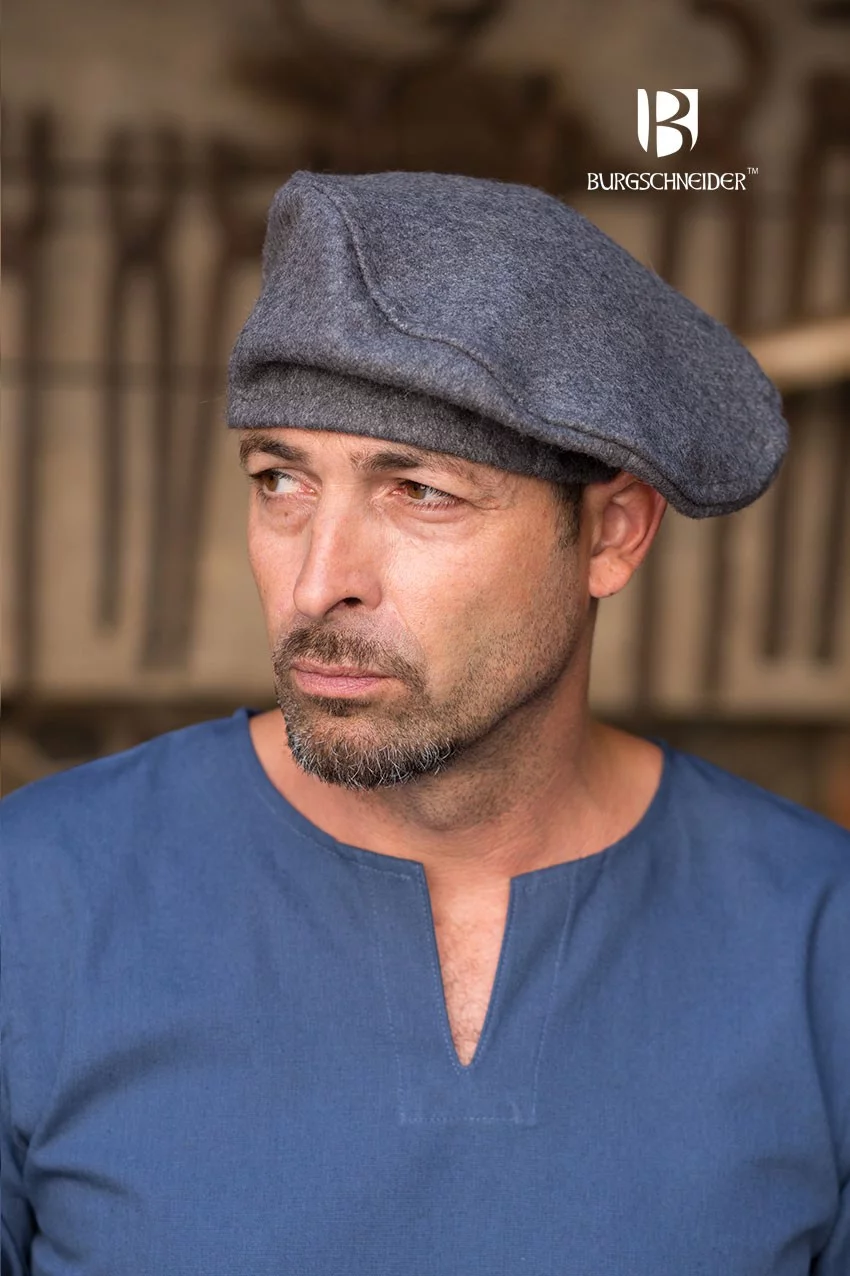
Main materials used in the manufacture of the Parlota
Woolen cloth: This material was the most common in the making of the parlota. It was often chosen in dark colors, with black being a classic that symbolized elegance and distinction.
Linen: It was used as an inner lining, providing comfort to the headdress and helping to regulate temperature during use.
Additional materials: Although less frequent, cotton parlotas were sometimes chosen for the lining, especially in dark tones. Velvet, on the other hand, added a touch of luxury, making these parlotas less accessible and, therefore, more valued in society.
Decoration and ornamentation
Parlotas were not only differentiated by their materials, but they also featured various decorative elements that enhanced their appearance and reflected the social status of the wearer. Some of the most common adornments included:
- Brooches
- Beads
- Pearls
- Small crystals
- Cameos
These ornamentations served not only an aesthetic purpose but were also a symbol of the wealth and elegance of the wearer, turning each piece into a textile work of art.

The parlota is, therefore, a fascinating example of how fashion can cross paths with history and culture, allowing current generations to appreciate the richness of historical dress and its symbolism. This headdress not only reflects the ingenuity of the tailoring techniques of its time but also connects us with a period full of creativity and personal expression in clothing.
A “gugel” is a fascinating historical accessory that has been an essential part of medieval clothing. This term refers to a type of hat or hood that was widely used during the Middle Ages, especially between the 12th and 15th centuries. We will explore in detail what a gugel is, its characteristics, uses, and its relevance in medieval society.
Characteristics of the Gugel
- Design: The gugel is essentially a hood that covers the head and extends over the shoulders, providing warmth and protection against the cold. The garment can be made from various materials, such as wool or cotton, making it warm and resistant to the elements.
- Uses: Beyond its practical function as warmth, the gugel was used in historical reenactments, fairs, and role-playing events. Its versatile design allows it to be used in various ways, even as a scarf or a decorative garment.
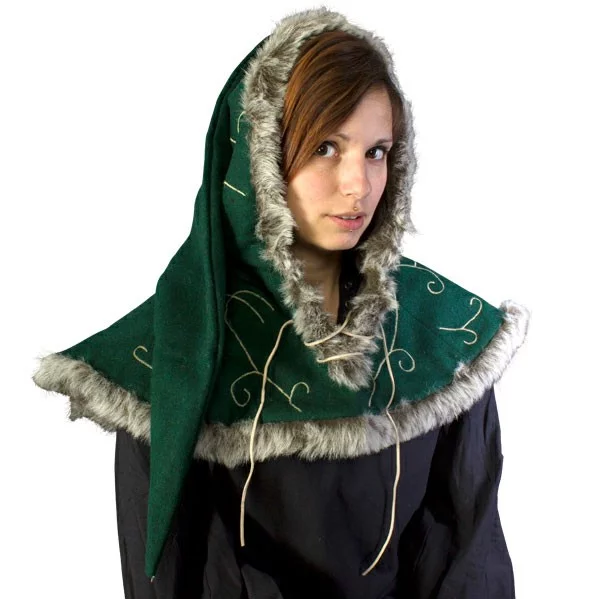
Compared to a more basic medieval hat, the gugel is a more elaborate piece that offers greater coverage and versatility, adapting to the user's needs. The ability to transform into other garments, such as scarves, is one of its great attractions.
Origin and History of the Gugel
The gugel has its roots in hoods and cloaks from earlier times. It became popular in the context of medieval clothing and is considered a practical and stylish garment. It was often worn by both men and women, becoming a prominent part of the fashion of the time.
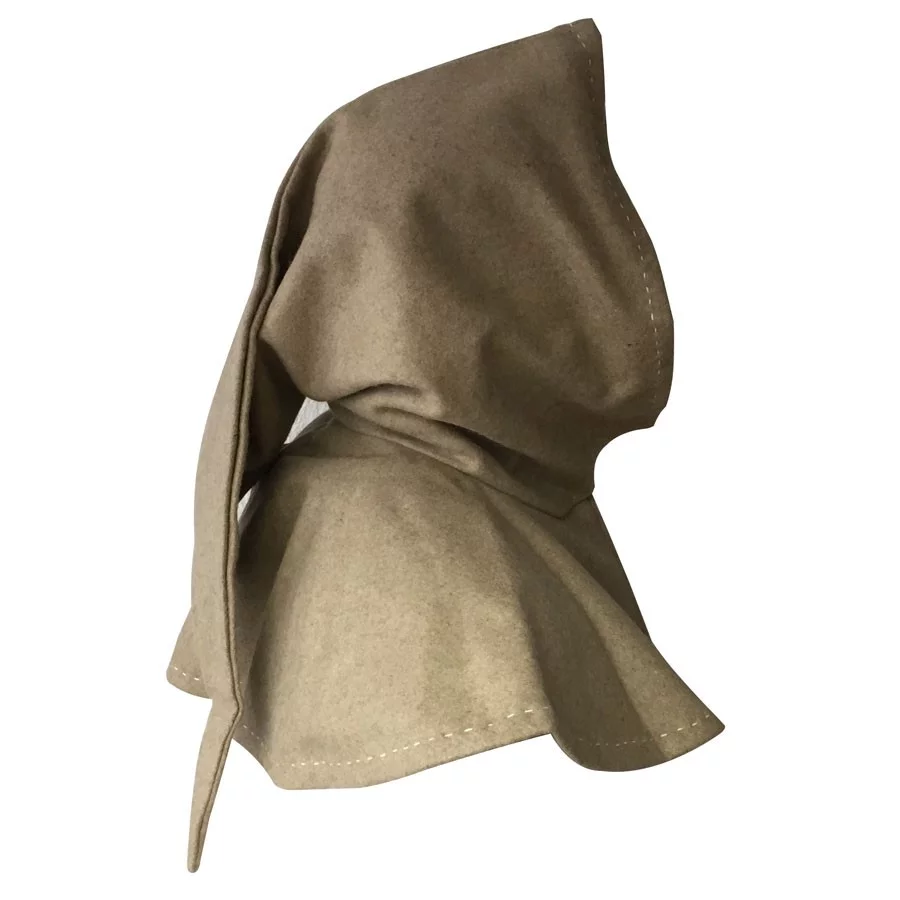
- Functions: Its primary function was to protect the head and upper body from the cold and rain. Typically made of wool fabric, it was warm and very suitable for the cool climate of the time.
- Colors and Style: The predominant colors of these gugels were earth tones, such as brown, green, and gray, giving them a rustic and authentic appearance, which was quite representative of medieval clothing.
Social Importance of the Gugel
The gugel was not only used as a garment for warmth, but it also played an important role in medieval fashion. Here are some of its social implications:
- Variations: There were different types of gugels, including simple, pointed, straight models, and those adorned with bells. Each type had unique characteristics and was used based on personal preferences and social context.
- Social Significance: The length of the tails and decorations could indicate the social status of the wearer. Decorated gugels were common on festive occasions and symbolized belonging to a specific group or social class.
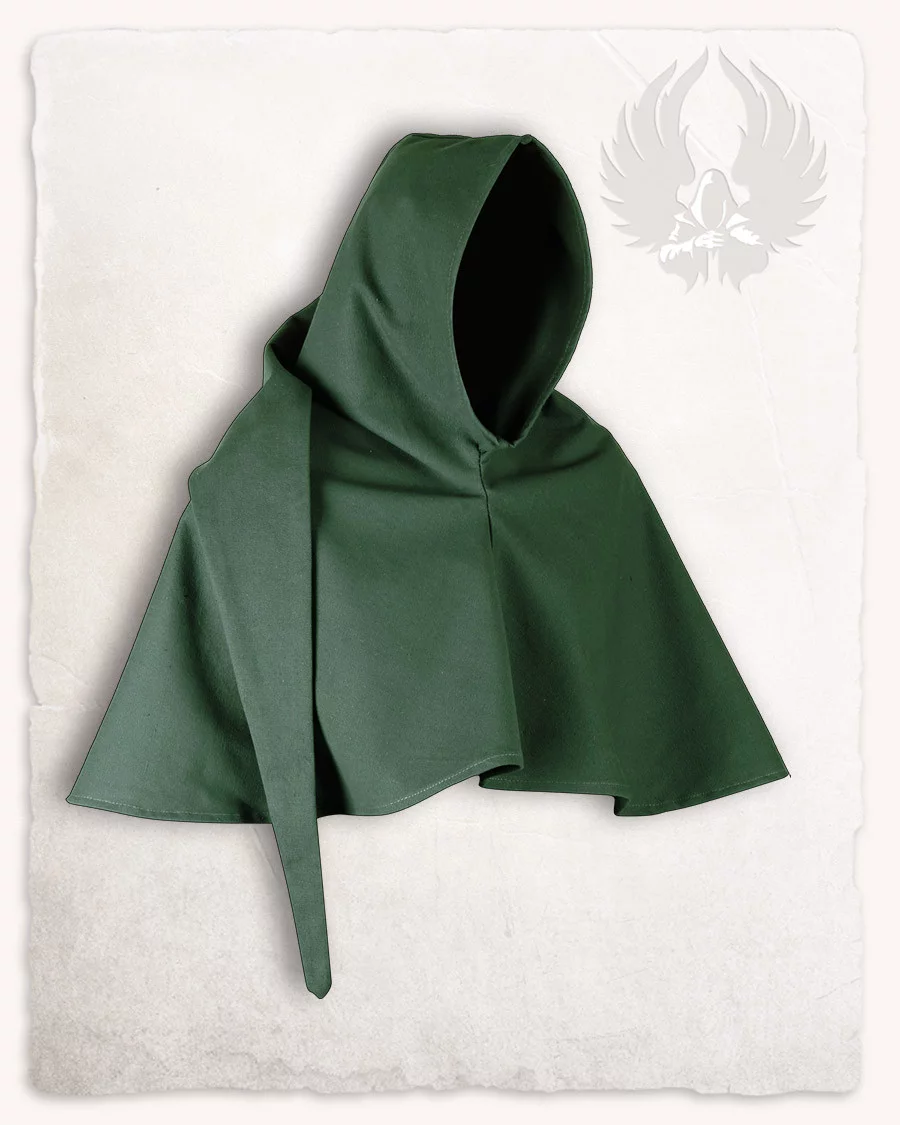
In summary, the gugel has left a significant mark on the history of medieval clothing, acting not only as a functional garment but also as a status symbol. In our store, we offer a variety of medieval gugels that have been made with high-quality materials and an authentic design, perfect for those looking to have a piece of history in their wardrobe.
The aiglets, also known as agelets, are small yet significant accessories that have their roots in historical clothing, especially in outfits from periods such as the medieval and Renaissance eras. Their main function is to secure the laces on garments like doublets and gambesons, providing both functionality and an aesthetic touch to the attire.
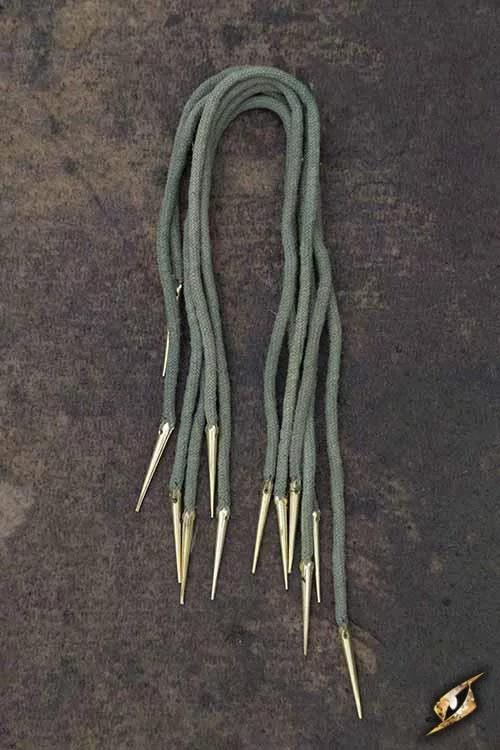
Characteristics of Aiglets
- Materials: Often, aiglets are made of metal, with brass being one of the most common materials due to its durability and authentic appearance. Solid brass aiglets are particularly popular among historical reenactment enthusiasts, as they offer superior quality that resembles the originals.
- Size: The size of aiglets can vary, although it is common to find models that measure approximately 3.8 cm. This size is ideal for use in various historical garments.
- Style: Beyond their practical utility, aiglets also add a decorative element to clothing. They are crucial for achieving an authentic look in historical reenactments, theater, or themed costumes. Their design can range from simple to elaborately ornate, allowing for personal expression within historical contexts.
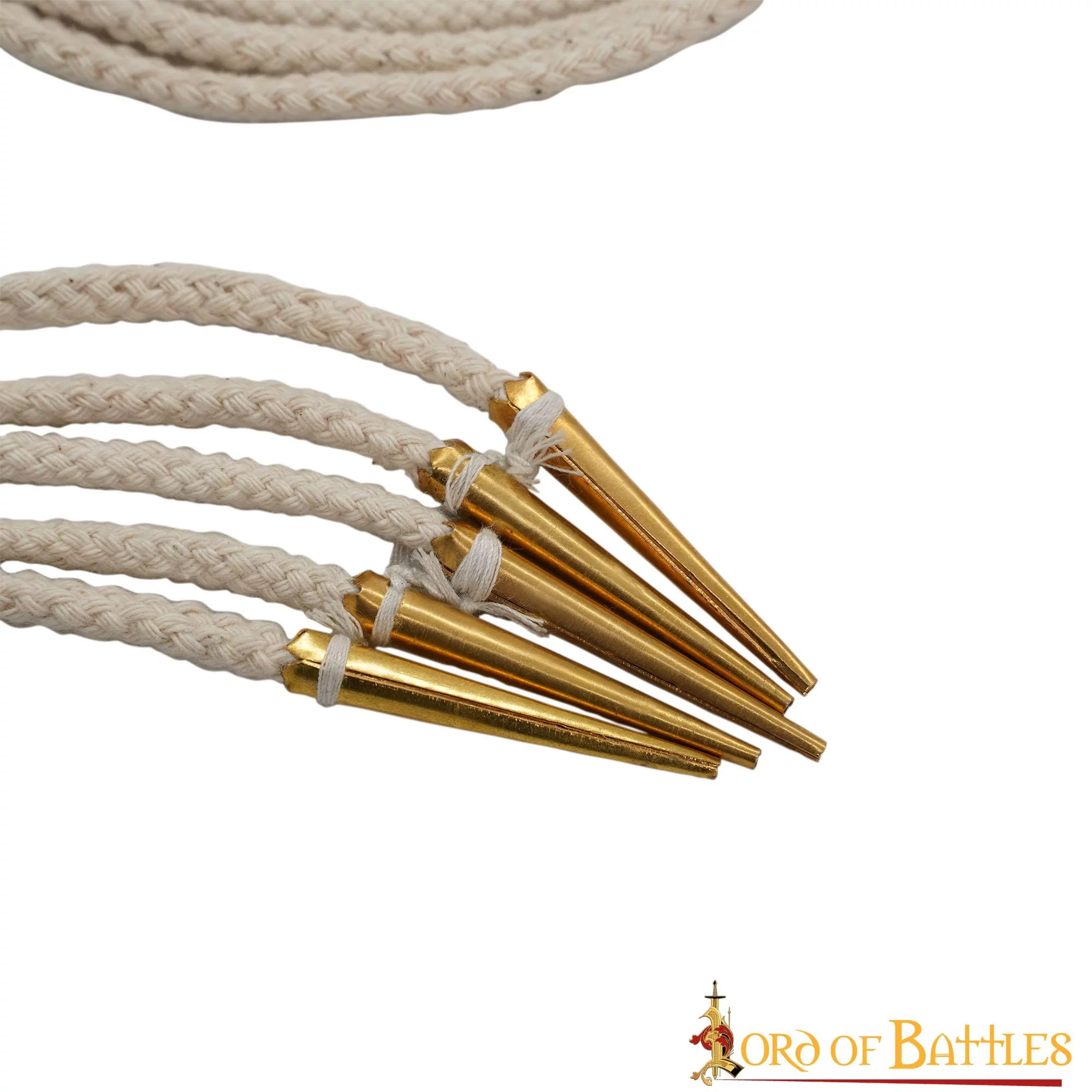
In summary, aiglets are more than just simple accessories; they are essential elements that contribute to the authenticity and aesthetics of historical clothing. Their proper use not only enhances the functionality of garments but also allows for a journey through time via the fashion of past eras.
The jubón is an emblematic garment that played a significant role in European fashion, especially in Spain, during the 15th to 17th centuries. Below, we will explore in detail its features, history, and the different types of jubones that existed during that time.
Features of the Jubón
The jubón is characterized by its fitted and rigid design, making it a unique garment. Its main characteristics include:
- Design: This garment was tight-fitting and had a structured collar, known as a "collar." It was made from high-quality fabrics such as satin, velvet, and fabrics adorned with golden threads.
- Use: Although initially worn by both men and women, by the late 16th century its use became predominantly masculine in the courtly sphere. Women began to adopt it later, adapting the jubón to enhance their figure.
- Lining: To provide greater structure, the jubón was lined with multiple layers of fabric, giving it a corset-like appearance.
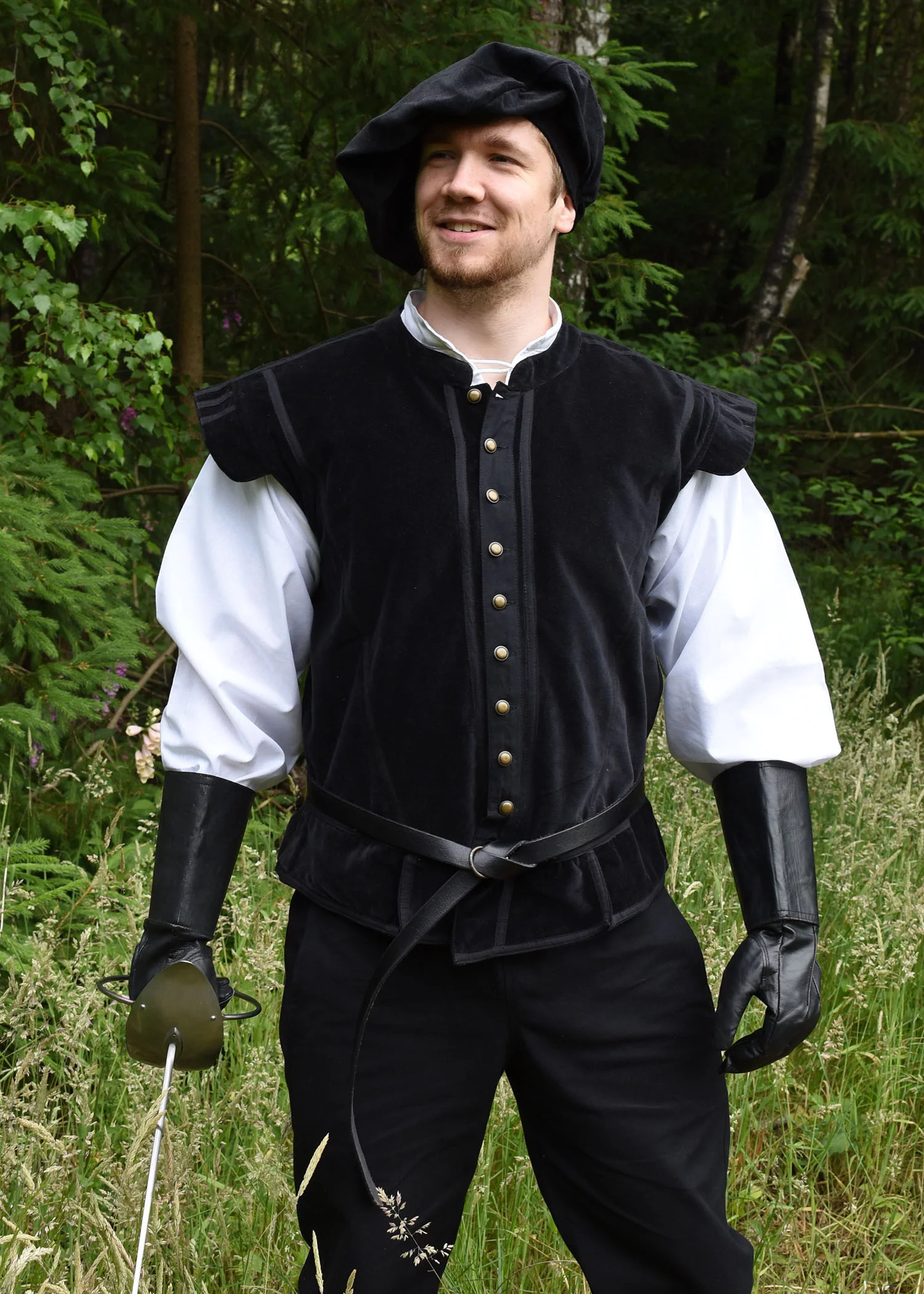
History of the Jubón
The jubón appeared in civil clothing during the 14th century, reaching its peak in the 16th century. It became an essential garment in the courts of Europe, and its creation was the responsibility of a specific guild known as juboneros. This garment was also fundamental to the male silhouette of the 15th century, adapting to various forms and styles according to the fashion of each era.
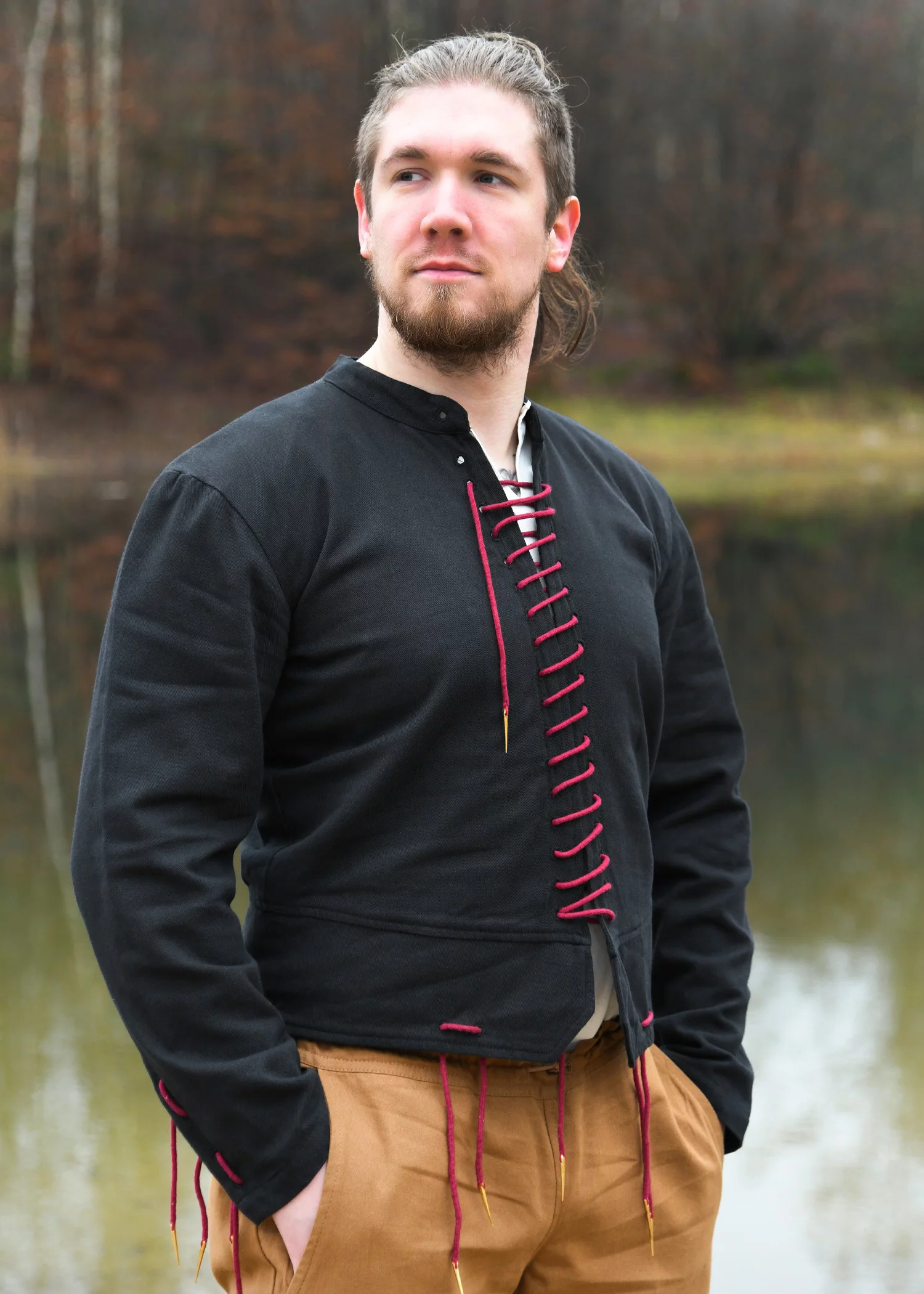
Types of Jubones
There are various types of jubones, each with specific characteristics:
- With Flaps: Fitted to the body, made with multiple fabrics over deer leather.
- Of Frame: Mesh jubón used for greater protection.
- Of Knuckles: Has a structure similar to a mesh or knots, giving it a peculiar appearance.
- Eyelet: Made of steel mesh over strong fabric, designed to protect the chest.
Differences Between Male and Female Jubones
Below are the main differences between male and female jubones:
- Male Jubones: Dating from the 14th century, they were essential in men's clothing, fitted and with a rigid collar.
- Female Jubones: Although their use became popular in the 16th century, they had particularities such as lengthening in the waist, adapting to enhance the female figure.
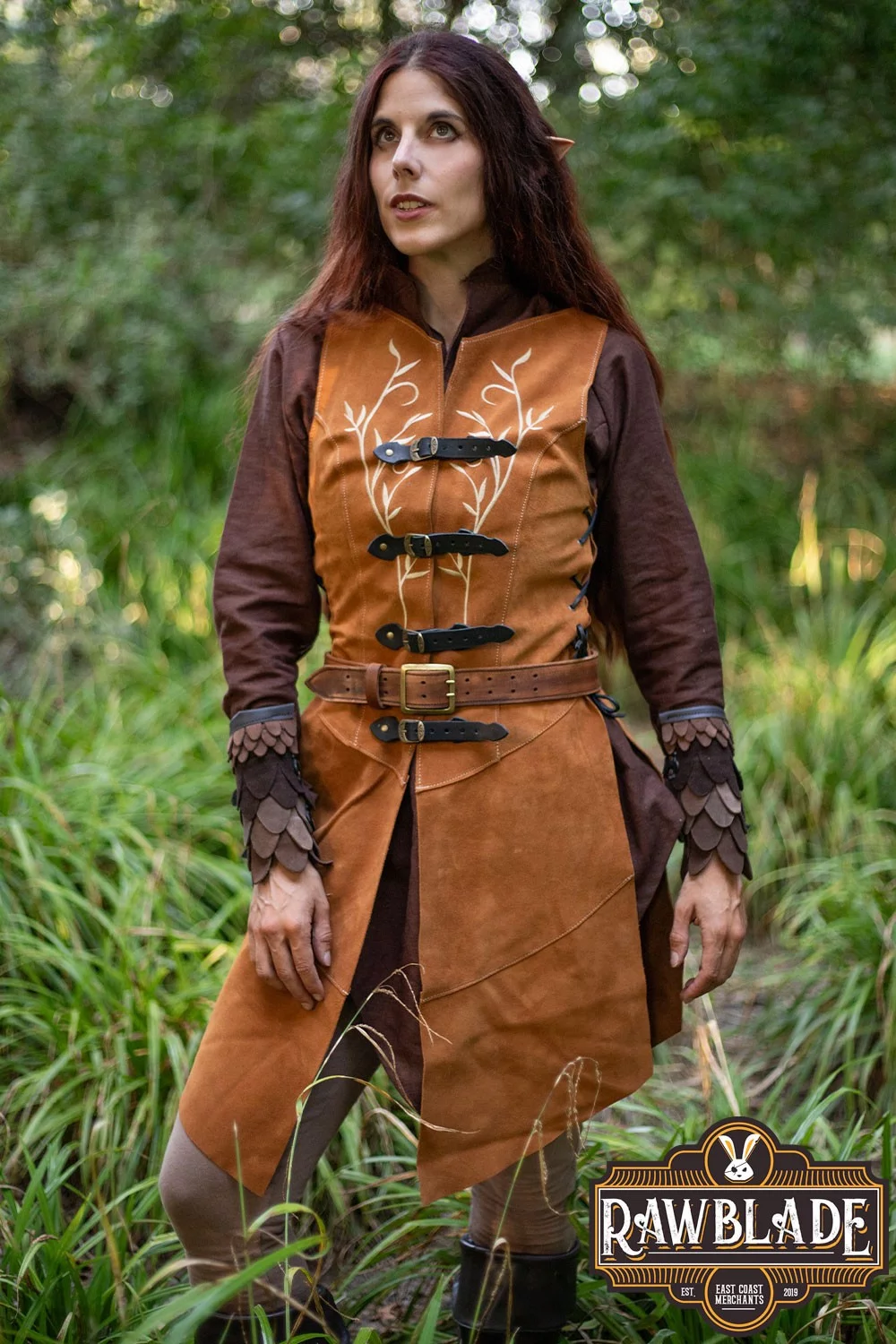
In conclusion, the jubón is a garment full of history and elegance that symbolizes the fashion of its time, characterized by its fit and the use of luxurious fabrics, adapting to gender trends over the years.
The brigantine is a type of armor that was used mainly between the 14th and 16th centuries. Its innovative design and flexible construction make it an interesting option for understanding the evolution of defensive clothing in military history.
A brigantine is characterized by being composed of:
- Small plates of steel or iron arranged in the form of scales.
- The plates are attached to a sturdy fabric base, whether canvas or leather, by means of rivets.
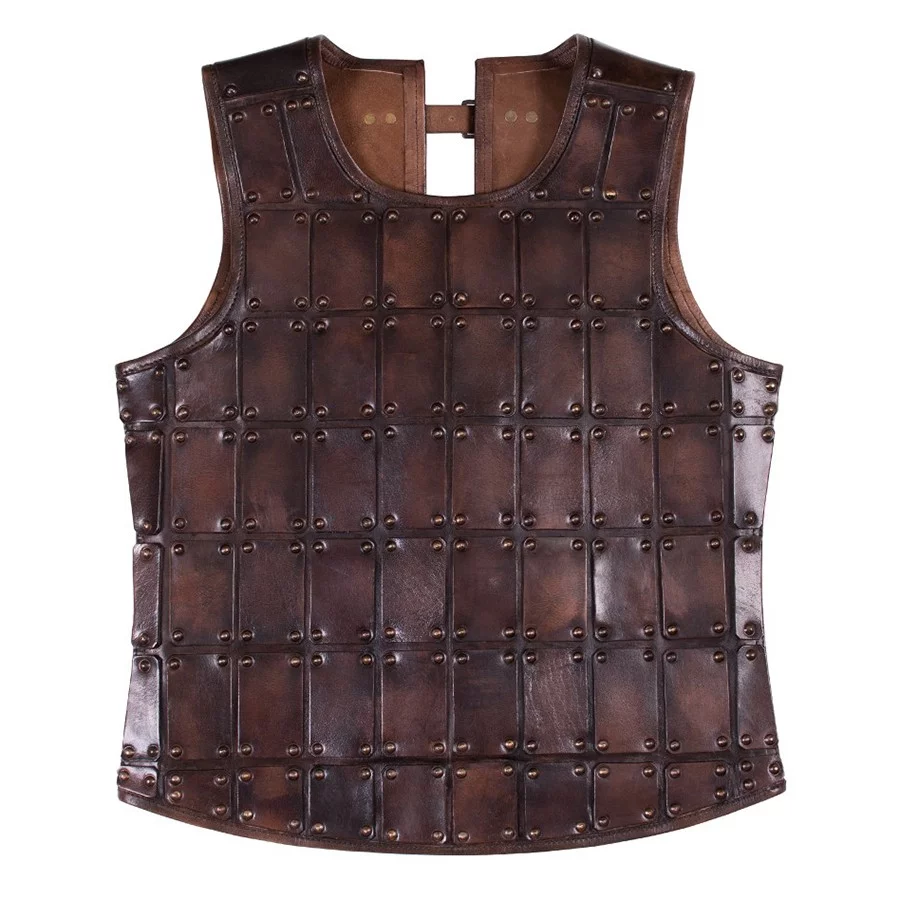
This type of armor differed according to its use:
- War brigantines were fastened around the chest, providing protection in direct combat.
- Tournament brigantines were fastened on the right side, allowing for a more ritualized combat style.
Among the main advantages of the brigantine are:
- Effective protection: Its plate design provides solid defense against cutting and blunt weapons.
- Mobility: Unlike heavier armors, the brigantine offered greater freedom of movement, facilitating dynamic maneuvers in combat.
- Affordable cost: It was a more economical alternative for those who could not afford full plate armor, making it popular among various social strata.
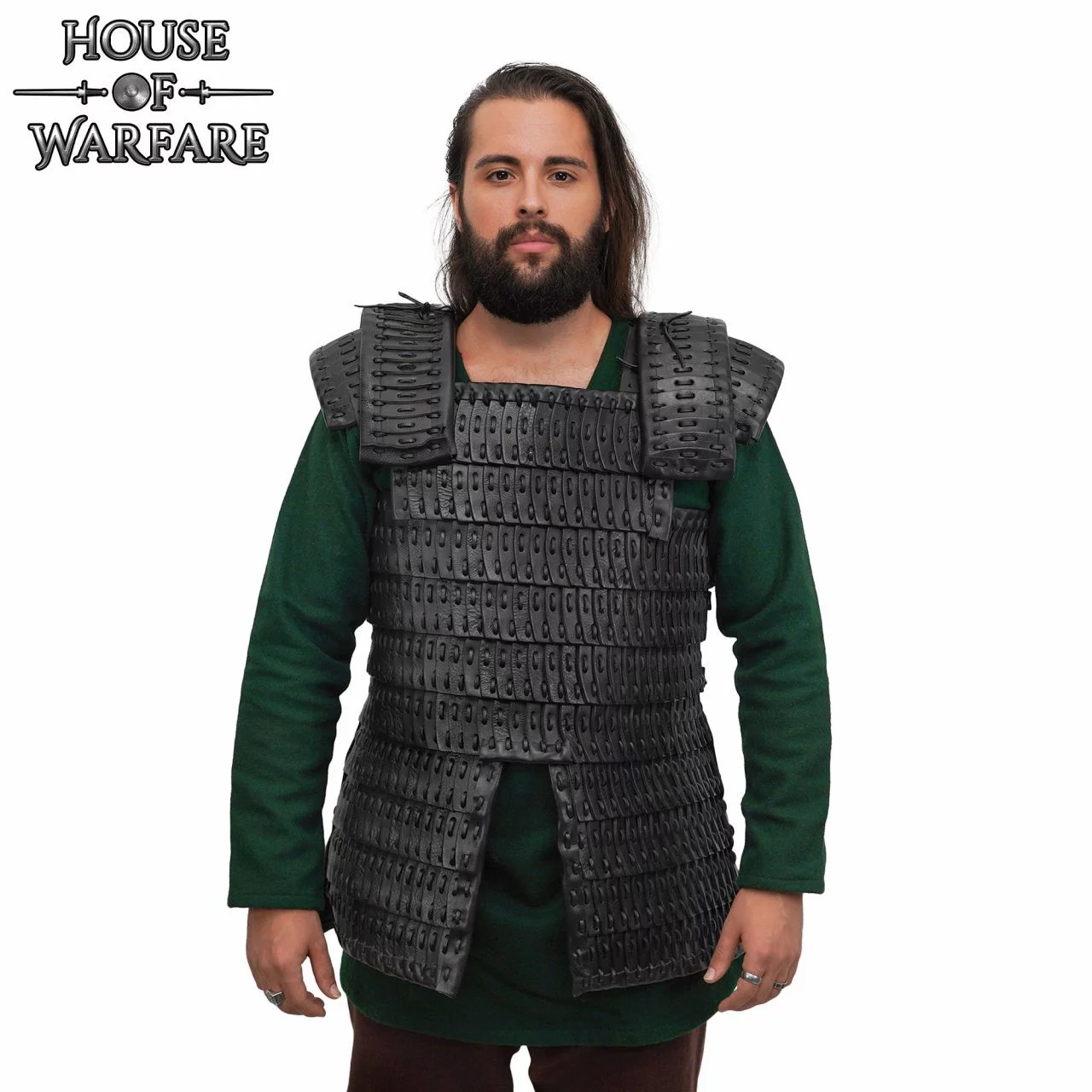
The brigantine also provided an attractive aesthetic aspect:
- The metal plates were integrated into a colored jacket, which concealed their defensive function and presented a more civilian or elegant appearance.
- It was possible to customize colors and designs, which could have heraldries or identification meanings.
It became a popular choice among soldiers of both infantry and cavalry, adapting to the specific combat styles and climatic conditions of regions such as Spain and Italy.
Therefore, the brigantine was not only an effective protective tool but also a symbol of sophistication in medieval armor design. With the right balance between resistance and mobility, it remained a preferred choice for many warriors of the time.
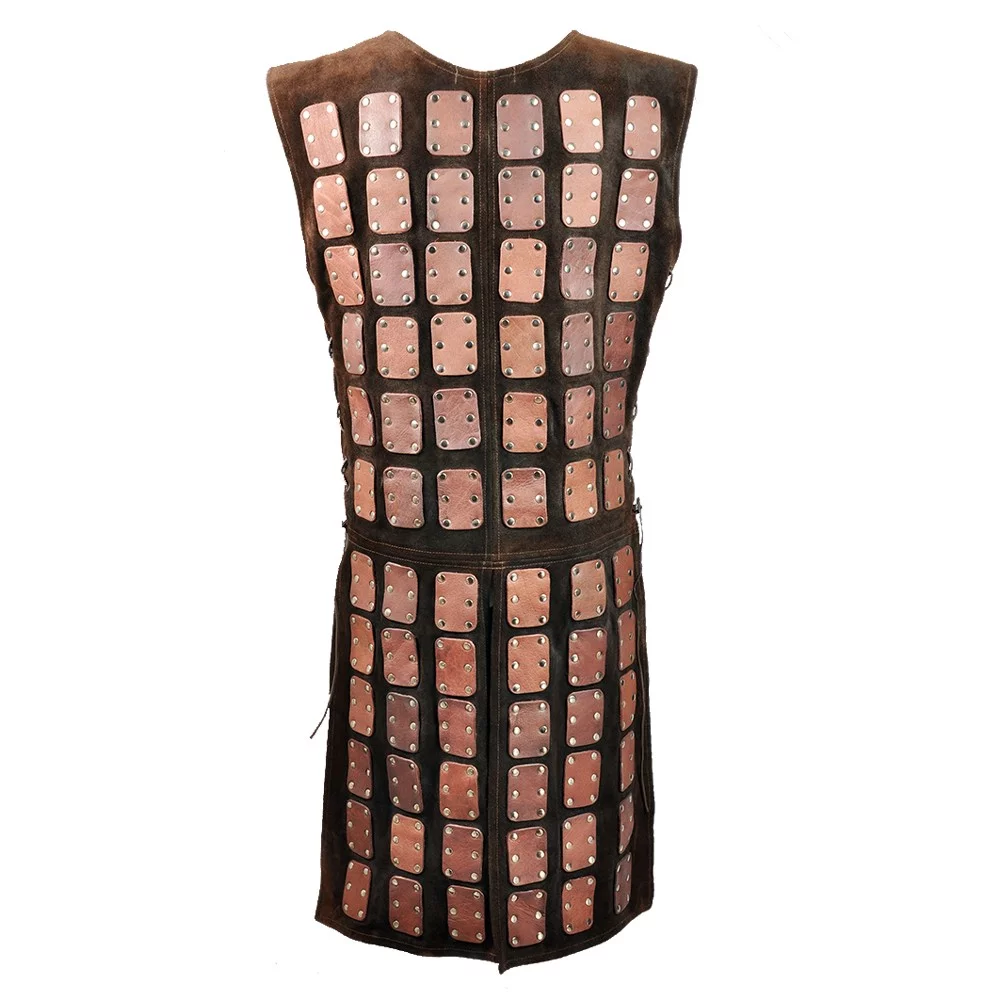
Alms bags are a type of purse that has its roots in the Middle Ages and have maintained their relevance to this day. Originally designed to help beggars and travelers carry their belongings safely, these bags are not only a symbol of past times but are also used in various reenactments and themed events today.
Origin and Function of Alms Bags
During the Middle Ages, alms bags served a crucial function for those needing to carry money and valuables. This accessory became an essential tool for:
- Beggars: They used alms bags to store alms and coins received.
- Travelers: They provided a safe place to keep coins and other valuable items during their journeys.
Essential Characteristics
Although the design of alms bags has evolved, their purpose remains the same: to provide a safe and convenient means of transporting belongings. Some common features include:
- Materials: They are usually made of leather, sturdy fabric, or suede, ensuring durability.
- Design: From simple shapes with closures to more ornate styles with cords for hanging.
- Accessories: Many alms bags feature interior compartments that facilitate the organization of small items.
Current Use of Alms Bags
Today, alms bags continue to be popular in specific contexts, such as:
- Historical Reenactments: They are a fundamental element for those seeking authenticity in medieval festivals.
- Themed Events: In medieval fairs and markets, alms bags are chosen for both their aesthetics and functionality.
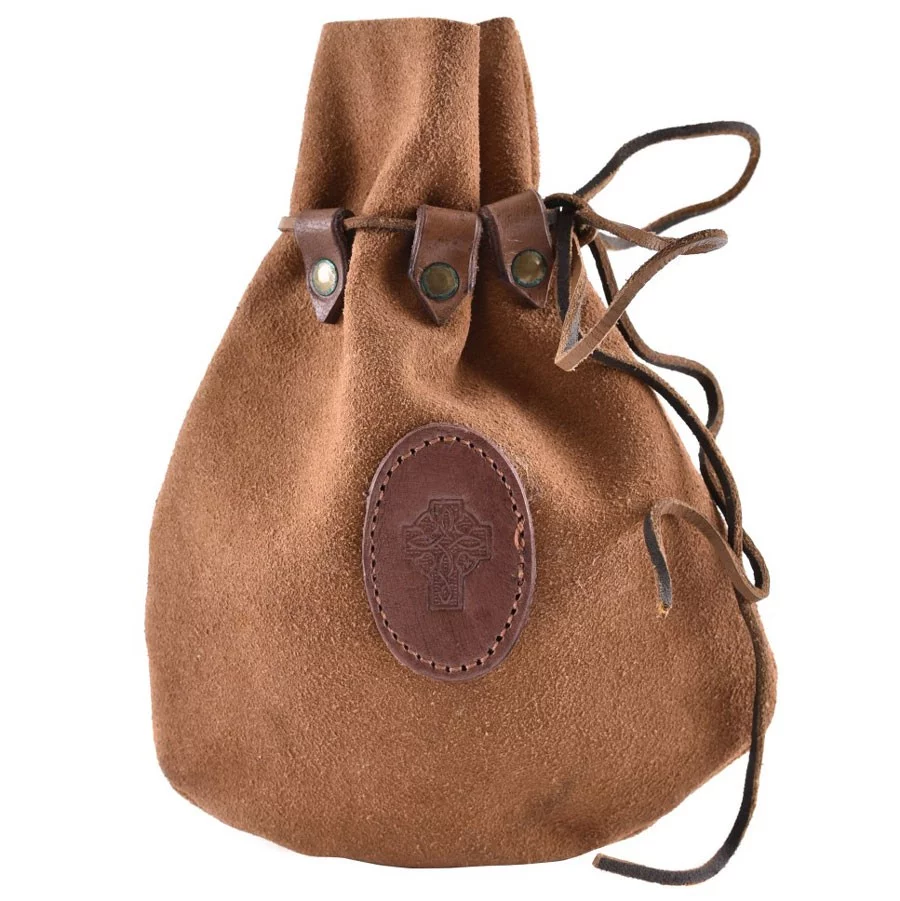
Where to Buy Alms Bags
Alms bags are available in specialized stores and online. Here are some options where you can find them:
- Online Purchases: Platforms like Medieval-Shop allow you to buy alms bags conveniently and securely.
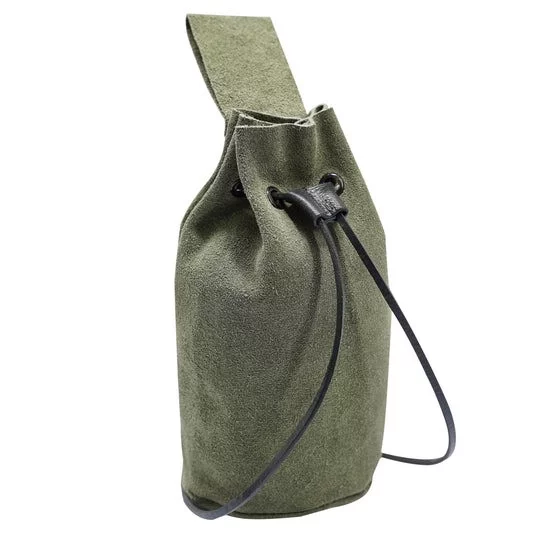
Alms bags not only evoke a rich historical heritage but also offer a practical design for modern use, merging functionality and aesthetics into one accessory.
The phalera is a fascinating historical object that has captured the attention of archaeologists and history enthusiasts alike. This term refers to a metal disc that was often crafted from precious metals such as gold, silver, and bronze, although there were also examples made of glass. Through this article, we will explore its origin, uses, and meanings throughout history.
Origin and Use in Antiquity
The Roman Civilization
The phalera is particularly emblematic of the ancient Roman civilization. In this context, it served as a military decoration placed on soldiers’ breastplates during parades and ceremonies. It was a symbol of honor and recognition for heroic acts in battle.
Roman soldiers who demonstrated bravery or exceptional skills in combat were awarded these medals. They not only represented individual recognition but also the glory and prestige of the military unit to which they belonged.
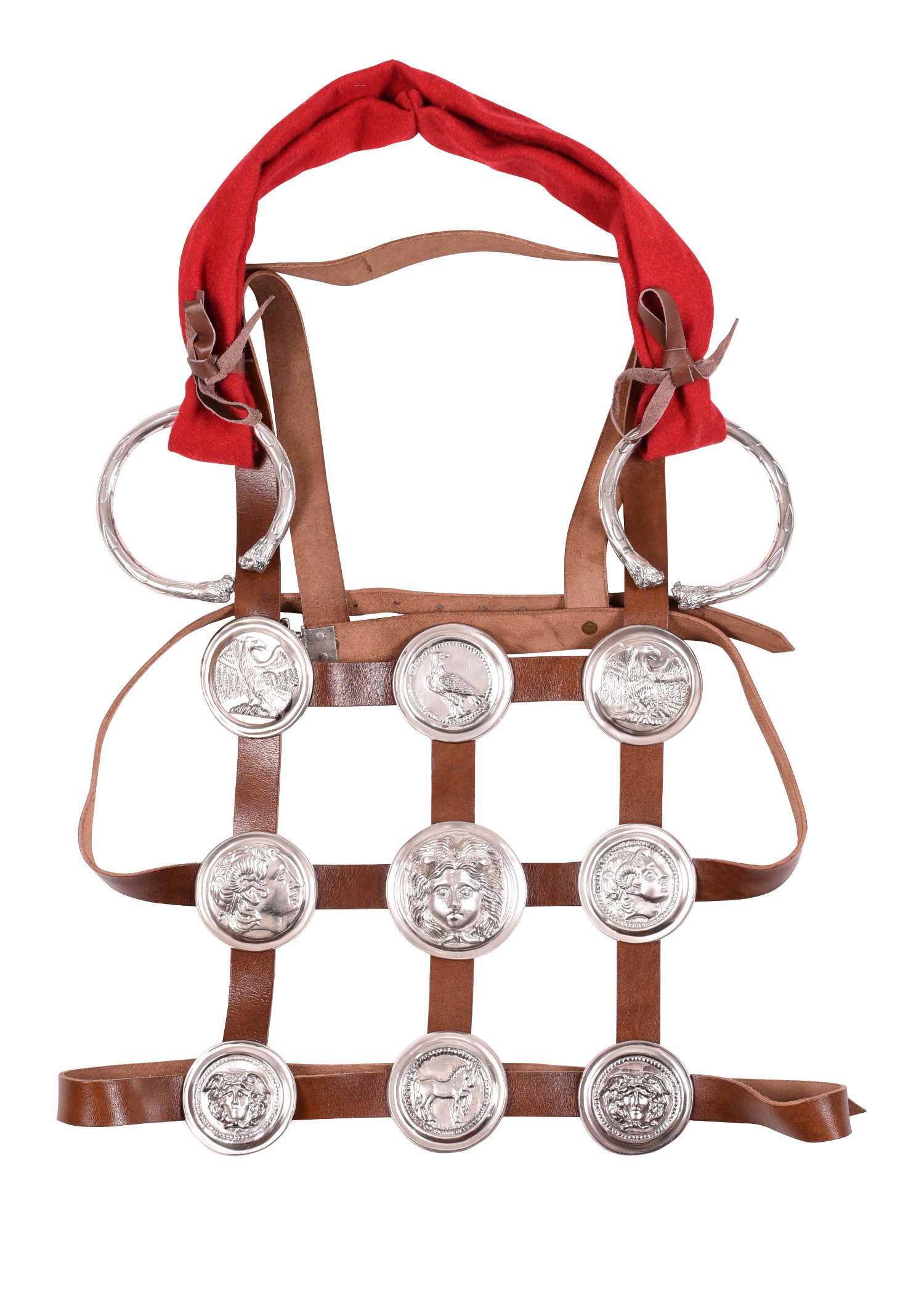
Use in Celtic Continental Culture
On the other hand, phalerae also found their place in Celtic culture. In this context, their use extended beyond the military, participating in religious ceremonies and ornamentation. They were an essential part of equestrian equipment, decorating horses and reflecting their owners’ social status.
Physical Description
Materials and Design
These decorations were made with valuable materials, primarily gold and silver, but also included interesting variations such as glass. As for their design, phalerae often featured sculptures depicting human figures, animals, or abstract symbols, making them valuable and significant pieces of art.
.jpg)
Historical Examples
Examples in History
A significant example of a Roman phalera is found at the Burg Linn Museum Center in Krefeld, Germany. This disc, featuring the image of a soldier adorned with multiple phalerae, reflects its use as a symbol of military decoration. Conversely, numerous Celtic phalerae have been discovered in excavations, demonstrating their relevance in the culture and religion of Celtic peoples.
| Characteristics | Roman | Celtic |
| Materials | Gold, silver, bronze | Metal, glass |
| Use | Military decoration | Ornamental and religious |
| Decoration | Sculptures, figures | Abstract, equestrian motifs |
The cingulum, known as the Roman military belt, is an emblematic element of the soldiers' attire in Ancient Rome. This accessory was not just a simple piece of clothing but also served significant practical and symbolic functions in the Roman military context.
Origin and Functionality
The cingulum militare has its roots in the Roman Republic and remained relevant during the Principate period. This belt not only secured the soldiers' tunic but also allowed them to carry their combat weapons, especially the gladius and pugio.
Distinctive Features
Generally, the cingulum was made of leather and adorned with various decorative elements, such as:
- Buckles: Used to adjust the belt to the waist.
- Metal plates: Added a visual touch and often indicated the wearer's rank or status.
- Studs: Used to adorn the belt and offer greater durability.
This combination of materials, including metals such as bronze and iron, made the cingulum both functional and visually appealing.
Composed Elements of the Cingulum
The cingulum consists of several essential parts:
- Baltea: The main band of the belt.
- Bulla: Rivets used to join the belt strips.
- Pensilio: Pendants that adorn the ends of the straps.
- Lamna: Discs found at the end of each strip.
- Fibula: Buckle that secures the band in place.
Military and Symbolic Use
The cingulum was part of a broader set of military equipment, including elements such as the helmet (galea), the shield (scutum), and the armor (curias). It was crucial for combat, allowing soldiers to carry weapons safely and visibly. Moreover, its presence was a symbol of military identity, proudly worn by soldiers even off the battlefield.
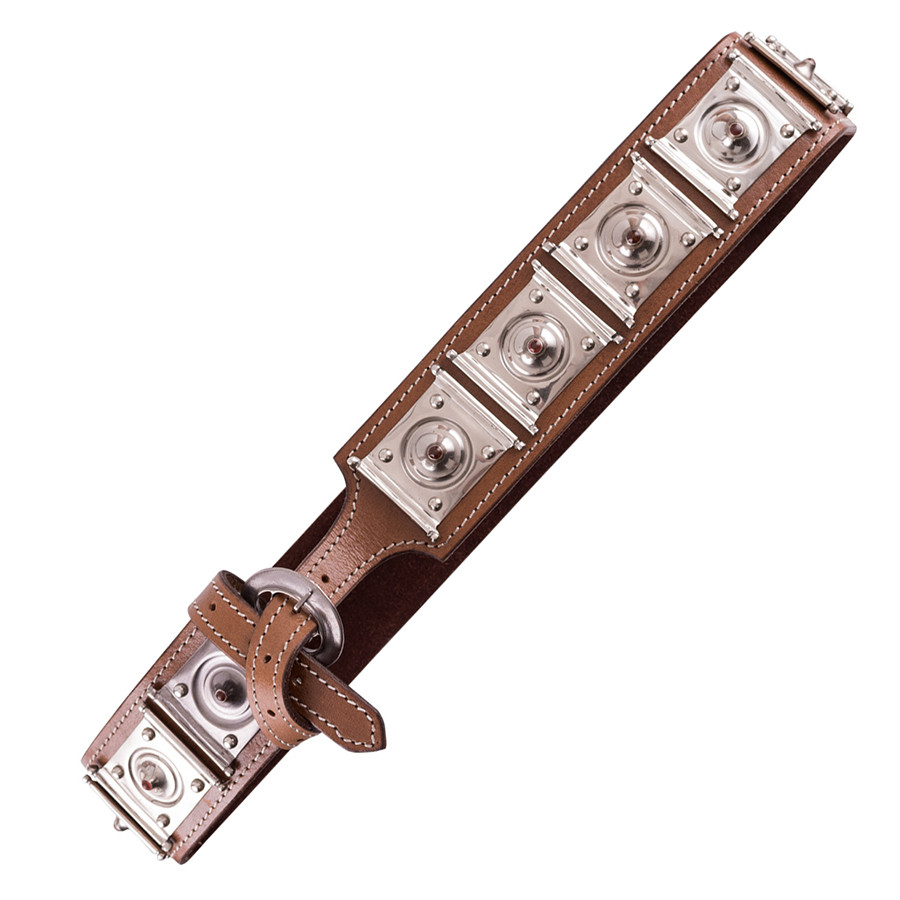
Modern Recreations
Today, the cingulum has not lost its relevance. It is widely used in historical reenactments and LARP (Live Action Role Playing) events. Many artisans manufacture replicas with natural leather and metal adornments, keeping the legacy of this fascinating military artifact alive.
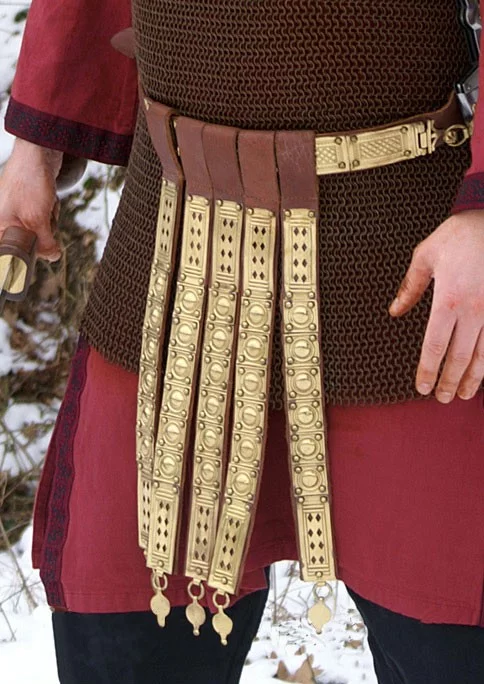
| Element | Description |
| Baltea | Main band forming the belt. |
| Bulla | Rivets that join the strips. |
| Pensilio | Decorative pendants at the ends. |
| Lamna | Discs at the end of each strip. |
| Fibula | Buckle securing the belt. |
Throughout the history of fashion, the fibula has played a fundamental role as a practical and decorative element in the clothing of various cultures, especially Roman and Celtic. This article delves into the definition, characteristics, and evolution of fibulae, illuminating their importance in the history of clothing.
What is a Fibula?
A fibula is a type of clasp or pin used to fasten garments, such as tunics and cloaks. Its purpose is to secure parts of a garment, providing both functionality and an aesthetic touch.
Origin and Characteristics
- Definition: Essentially, fibulae are mechanisms that allow the joining of fabrics, preventing them from slipping or separating.
- Uses: Historically used for multi-layered clothing, their design varied in complexity and material, reflecting the social status of the wearer.
History of the Fibula
Fibulae have origins dating back to pre-Roman times, and their use has been recorded in multiple cultures throughout European history.
Fibula in Roman Culture
In ancient Rome, the fibula was not only functional but also a symbol of status. Made with precious metals like gold, silver, and bronze, they were ornamented with techniques like filigree and enamel, making them decorative pieces that represented wealth.
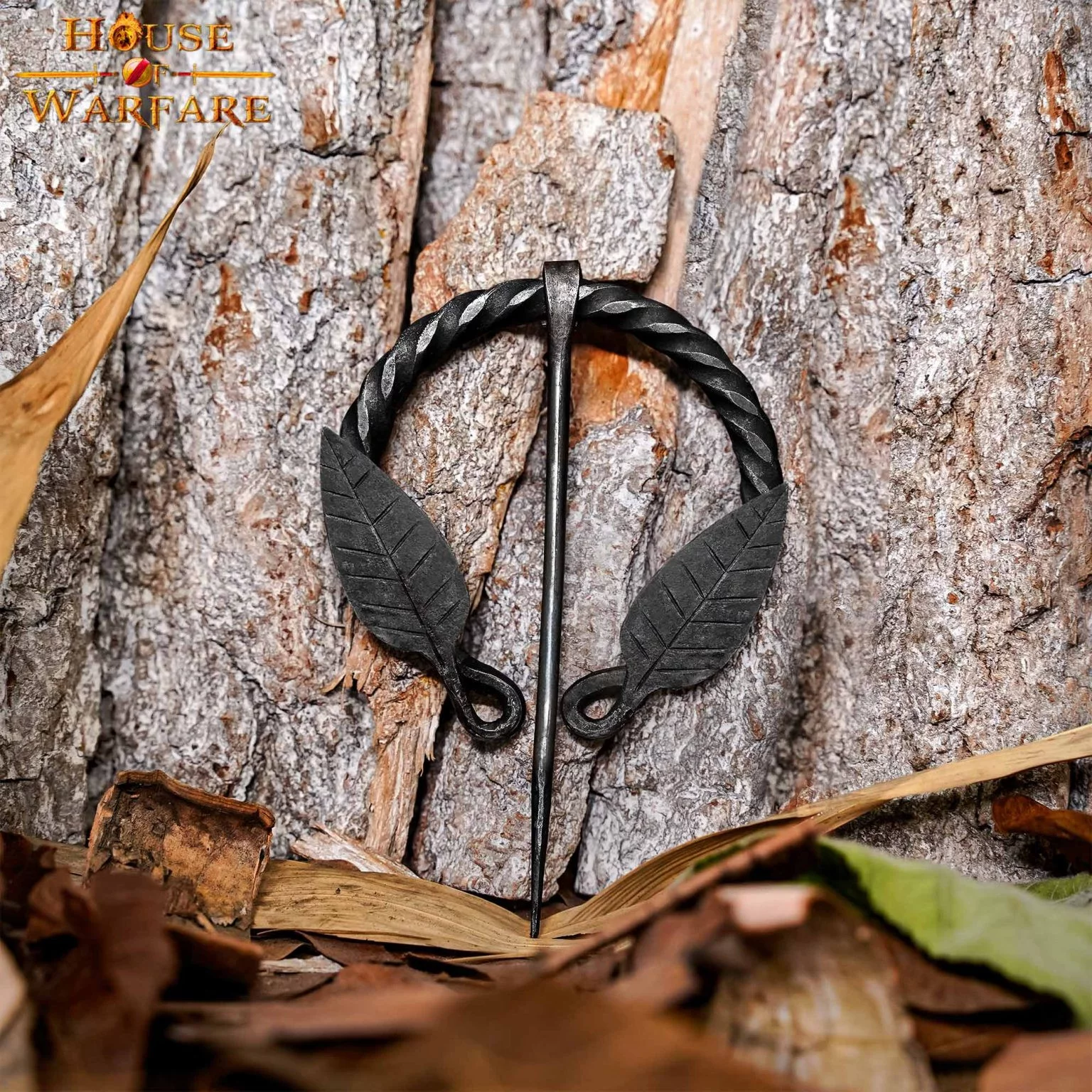
Celtic and Medieval Influences
In Celtic culture, penannular brooches were popular. These were secured through a pin that was inserted and rotated, an ingenious method that demonstrates the technical skill of the time. Over time, styles diversified during the Early Middle Ages, reflecting various artistic and cultural traditions among different ethnic groups.
Significant Examples
- Disc Fibula: This type of fibula features elaborate decoration, often used in medieval women's trousseau, adorned with gold and precious stones.
- Celtic Brooch: Known for its size and style, this brooch aptly represents the fusion of functionality and art in ancient clothing.
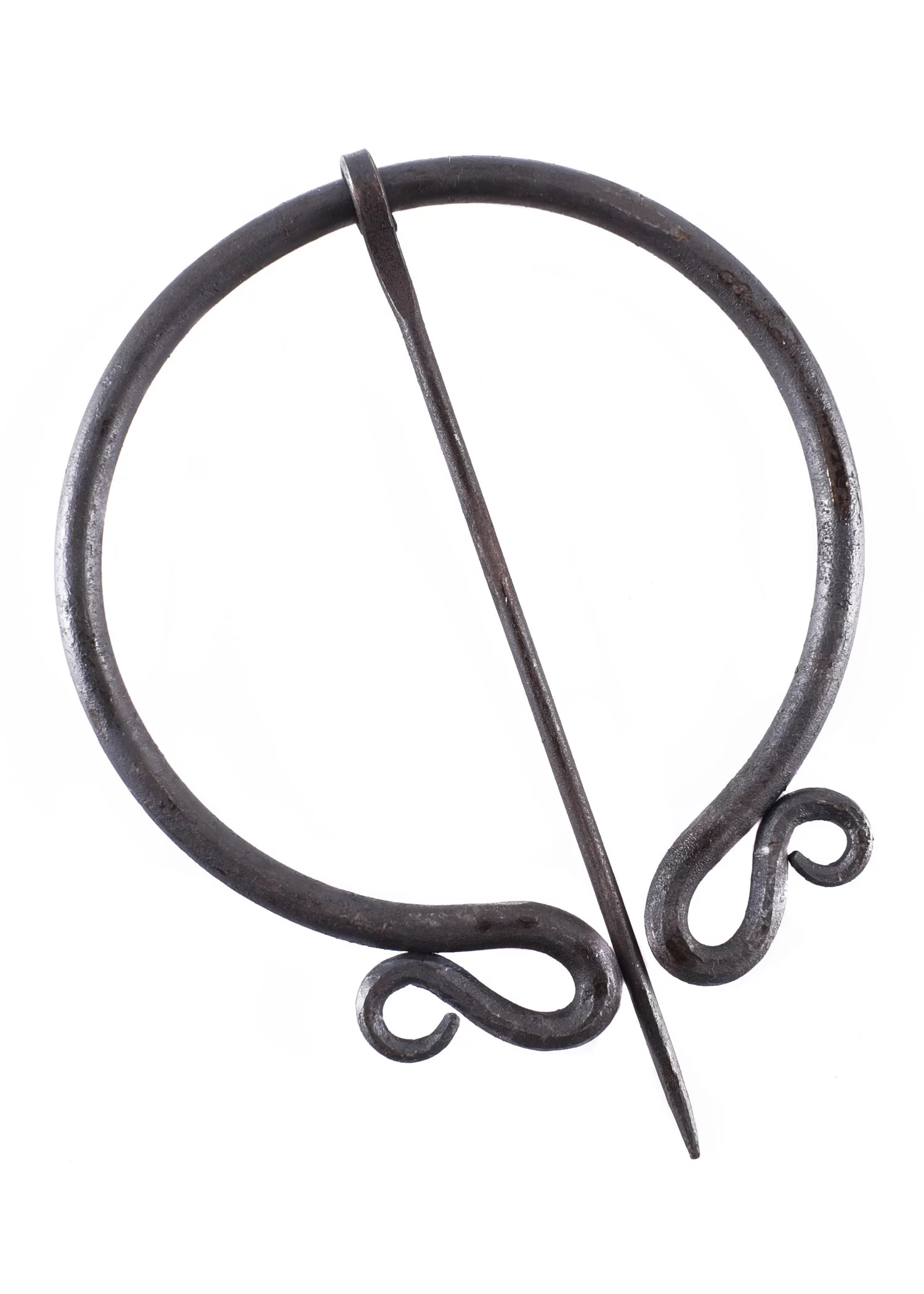
| Type of Fibula | Culture | Common Materials | Special Features |
|---|---|---|---|
| Roman Fibula | Roman | Gold, silver, bronze | Filigree and enamel decorations |
| Penannular Brooch | Celtic | Bronze, iron | Pin that swivels to secure |
| Disc Fibula | Early Middle Ages | Gold, silver, precious stones | Richly decorated and symbolic |
The Roman balteus is a military accessory that played a fundamental role in the lives of soldiers of the Roman Empire. This belt, well-known for its functionality and symbolism, was essential for the mobility and equipment of the legionary on the battlefield.
Function and Design of the Balteus
The balteus, often referred to as a belt, was primarily used to:
- Hold the sword or gladius: This type of sword was basic in hand-to-hand combat, and the balteus ensured it was easily accessible.
- Support for other accessories and weapons: Aside from the sword, it allowed the soldier to carry other necessary tools for combat.
Generally made of treated cowhide leather, the balteus featured characteristics such as beveled edges, which facilitated its use and maintenance. This durability was crucial, considering the wear they suffered during military campaigns.
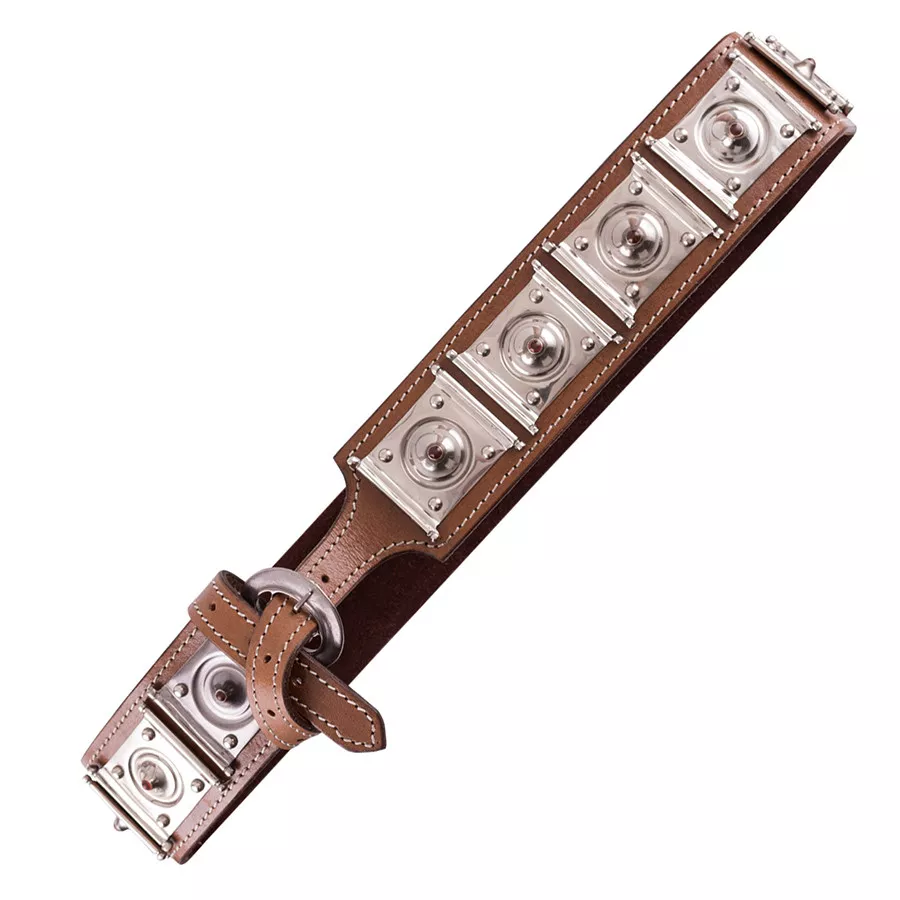
Historical and Symbolic Importance
The balteus was not only functional but also laden with meaning:
- A status symbol: Roman officers wore a decorated balteus, which distinguished them within the army. The design and adornments indicated their rank and experience.
- Reflection of military hierarchy: This element highlights the rigid structure of the Roman army, where every detail counted to maintain discipline and leadership.

Conclusions about the Roman Balteus
As we have seen, the Roman balteus is a clear example of the complexity and efficiency of the Roman army in its time. It not only represented a tool for war but also reflected the social and military order that characterized one of the most influential empires in history.
| Function | Description |
| Hold weapons | Allows carrying the sword and other weapons in an accessible manner. |
| Status element | Indicates rank through its design and adornments. |
| Durability | Made of treated leather to withstand wear. |
The Roman sagum is an emblematic garment that not only symbolizes the valor of Roman soldiers but also reflects the rich history of military clothing in Ancient Rome. Over time, the sagum has left a significant mark on the visual recognition of the ancient Roman warrior. Below, we will explore its characteristics, uses, and social and cultural importance.
Characteristics of the Roman Sagum
The sagum was essentially a rectangular cloak made from thick wool, common in cold regions. Its characteristics included:
- Material: Mainly wool, providing warmth and durability.
- Color: Usually dyed bright red, ensuring visibility on the battlefield.
- Design: Simple, with a central opening for the head and occasionally hoods for extra protection.

Military Use of the Sagum
The garment was essential for Roman soldiers for various reasons:
- Allowed unrestricted range of motion, crucial during battles.
- Provided protection against the weather, particularly in winter or rainy campaigns.
- Functionality on the battlefield, being easy to put on and take off.
Symbolic Significance
Beyond its functionality, the sagum carried strong symbolic significance:
- Contrasted with the toga, the clothing of Roman citizens in times of peace.
- The use of the sagum indicated the individual was in active preparation for war.
- Reflected commitment to defense and the martial ideals of ancient Rome.
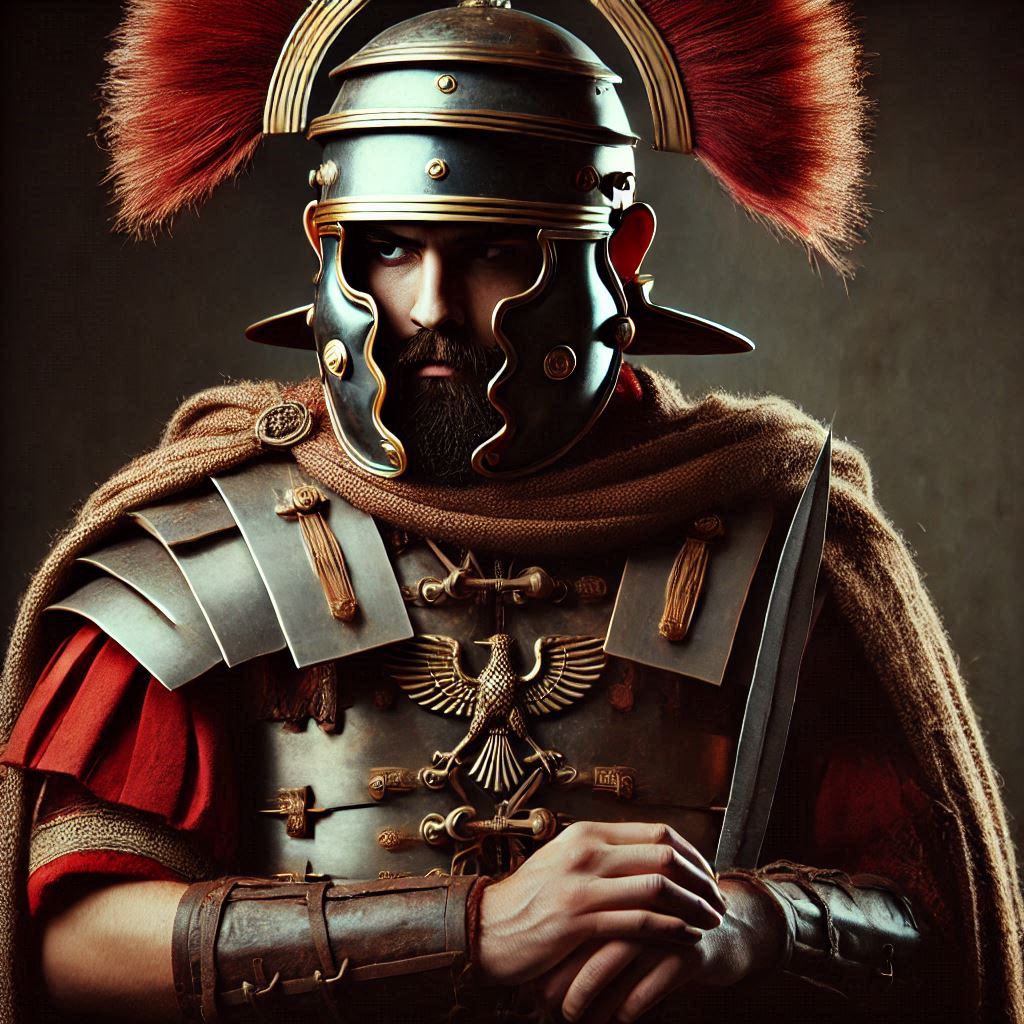
Cultural Influence of the Sagum
The sagum was not limited to Roman soldiers. It was also used in a wide range of contexts:
- Common citizens could wear the sagum in times of danger or turmoil.
- Other peoples of the time, such as the Gauls and Germans, shared this garment, evidencing its cultural influence in the Mediterranean.
- It was a symbol of military and social status that, even in peacetime, retained its meaning in an aristocratic culture.
| Characteristics | Details |
| Material | Thick wool |
| Color | Bright red |
| Design Features | Rectangular, head opening, sometimes with hood |
| Uses | Protection in battle, warmth in cold climates |
| Significance | Indicator of war and defense |
The Roman toga is one of the most iconic garments that has endured in the history of ancient Rome. This clothing, which was not only a formal attire, also symbolized the social status, citizenship, and authority of those who wore it. In this article, we will delve into the history, characteristics, and types of the Roman toga, as well as its meaning and some curiosities about its use.
Origins and Evolution
The toga has its roots in Etruscan and Greek garments, but the Romans adapted it, turning it into a cultural distinctive. Initially, the toga was worn interchangeably by men and women, but over time, it became exclusively associated with male Roman citizens, becoming a symbol of honor and distinction.
Characteristics and Types of Togas
The toga was a large piece of cloth, usually made of white wool, which was wrapped around the body over a tunic. There are several types of togas, each with its own meaning:
- Toga Virilis/Pura: This is the basic toga that a Roman citizen wore upon reaching adulthood. It was completely white and unadorned.
- Toga Praetexta: This toga, used by magistrates, featured reddish or purple borders, indicating their authority.
- Toga Candida: This white toga, treated with chalk, symbolized purity of intention and was worn by candidates for public office.
- Purple Toga: Worn by emperors and kings, this toga was a symbol of power and wealth, recognizable by its purple color.
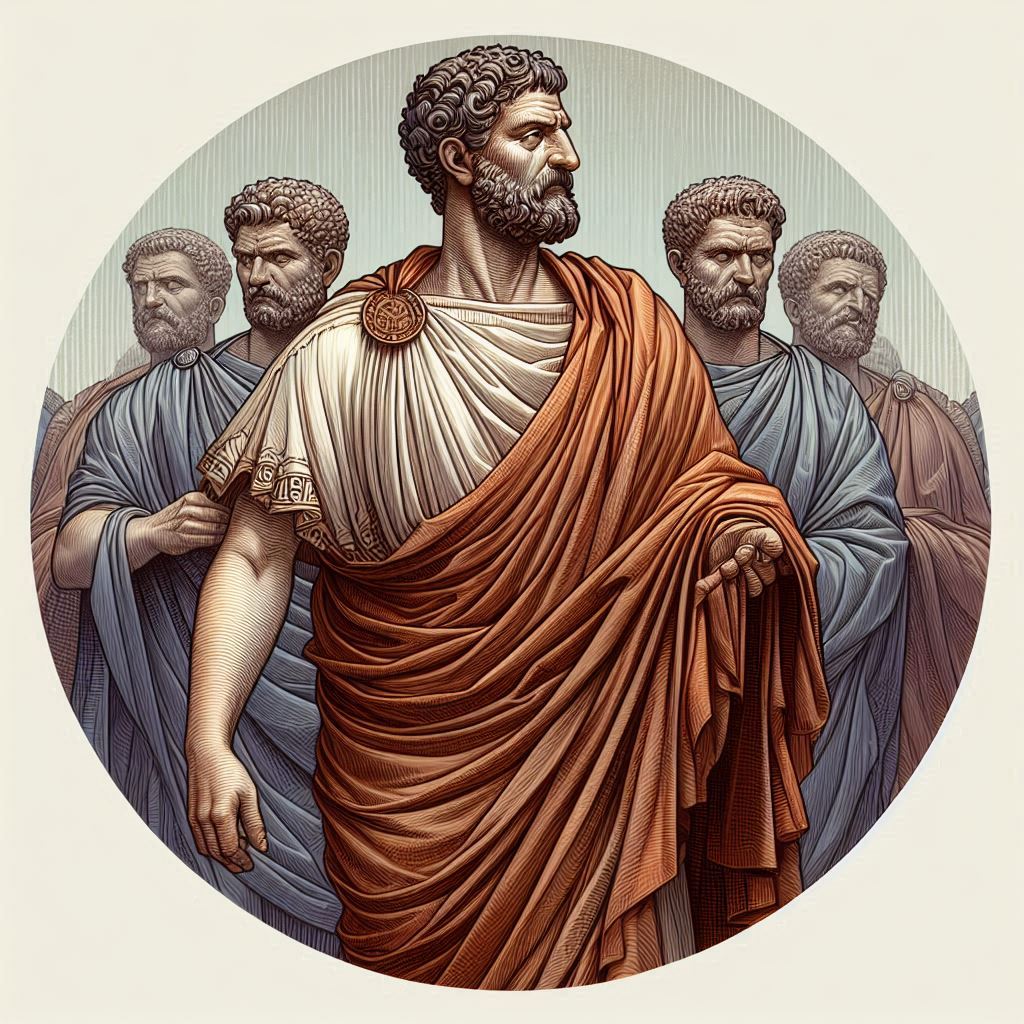
Use and Significance
Not only was it a formal garment, but the toga represented the social category of the wearer, distinguishing Roman citizens from those who did not belong to this group. The colors and adornments of the toga indicated the status and achievements of the individual, making it a symbol of social recognition.
Dressing Process and Restrictions
Putting on a toga was a complex task that required some skill. Many Romans needed help to adjust it properly. Despite its formality, it was not a comfortable outfit, so its use was reserved for ceremonies or significant events.
It is important to mention that the toga was restricted to free Roman men. Women and foreigners could not wear it, although there were exceptions, such as the toga muliebris, which was assigned to certain women in particular situations.
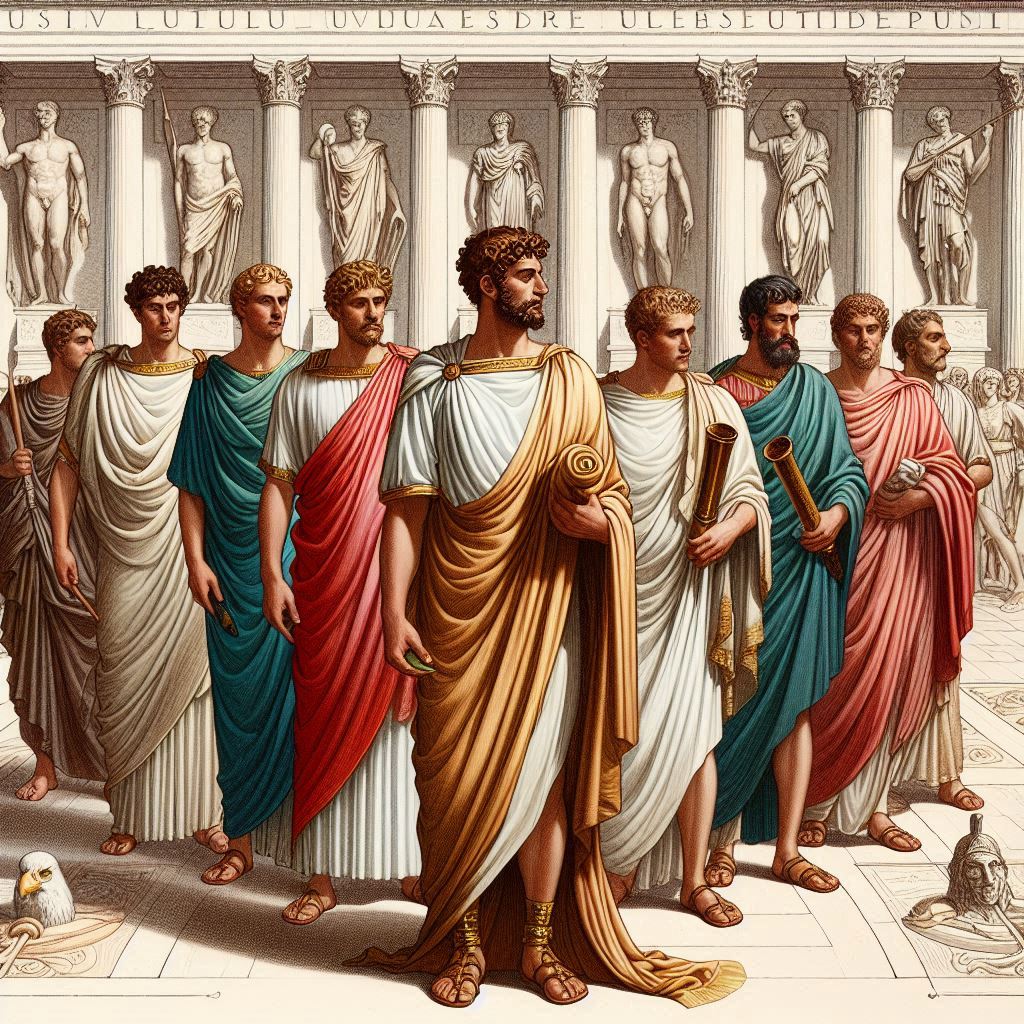
The Roman toga has become an enduring symbol of classical culture, reflecting not only the history of Rome but also the complex social structure of its time. Its relevance continues to be present, being a symbol associated with power and citizenship in the history of the Western world.
The Roman Subarmalis is a historical garment that played a vital role in the clothing and protection of soldiers during the Roman Empire and the Byzantine Empire. This innovative piece of armor not only offered comfort but also provided crucial defense on the battlefield.
Origin and History
The design of the Subarmalis is inspired by more primitive versions used by Greek peoples. Over time, the Romans made adjustments that optimized its functionality and comfort, making it an essential element of the Roman military arsenal.
Features of the Subarmalis
- Materials: Generally made of treated leather or padded fabrics, the Subarmalis offered durability and impact resistance.
- Design: It featured laces or fastenings that allowed for a tight fit to the body, ensuring that the garment did not move during combat.
- Layers of Protection: It was strategically placed under armor, such as the lorica hamata (chain mail) or the lorica segmentata, providing additional defense against blows and bruises.
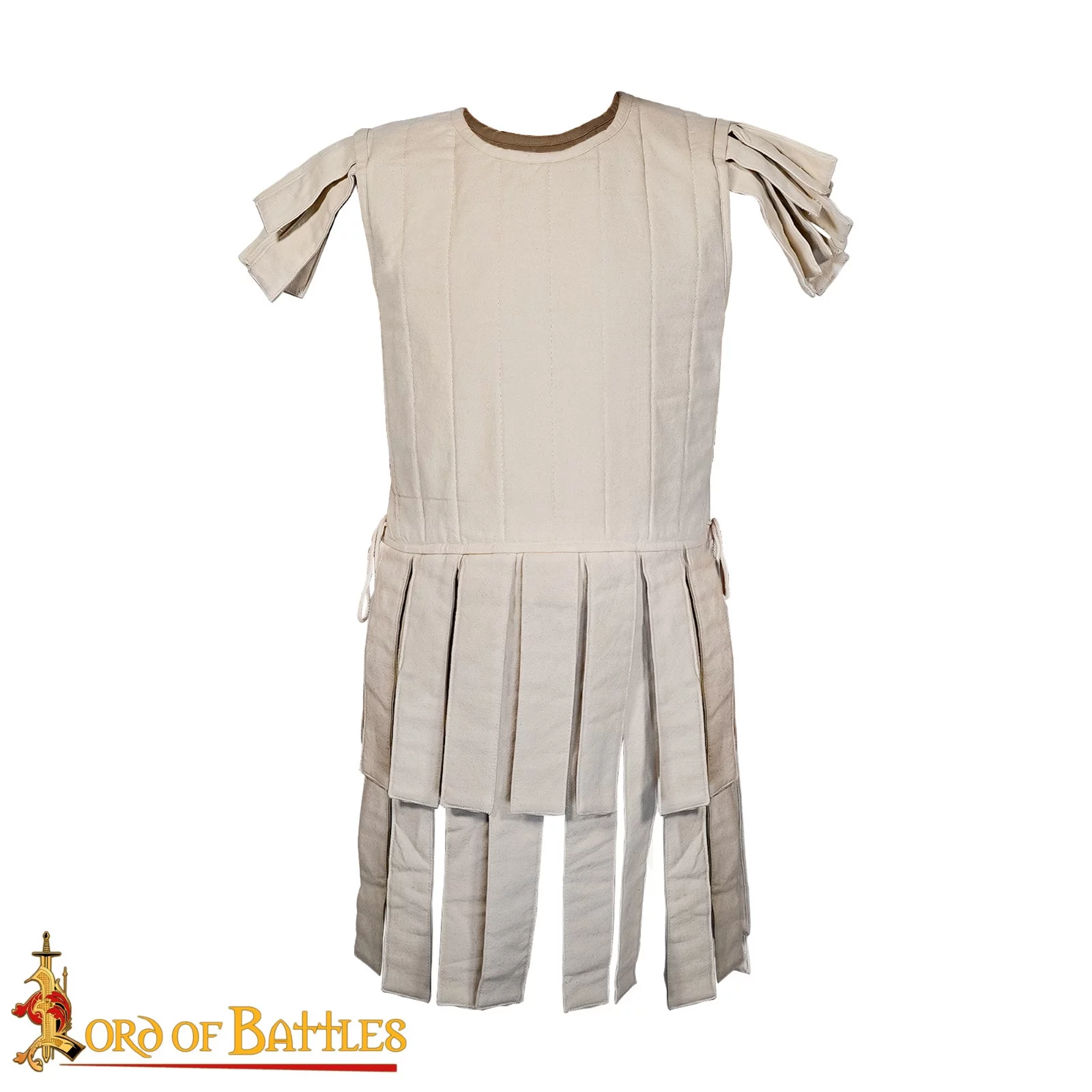
Use on the Battlefield
The Subarmalis was commonly used by both Roman and Byzantine troops and was considered indispensable for any soldier equipped with armor. Its main function was:
- Cushioning the impact of enemy weapons, especially in hand-to-hand combat.
- Protecting the soldier's torso and limbs, reducing the risk of serious injuries.
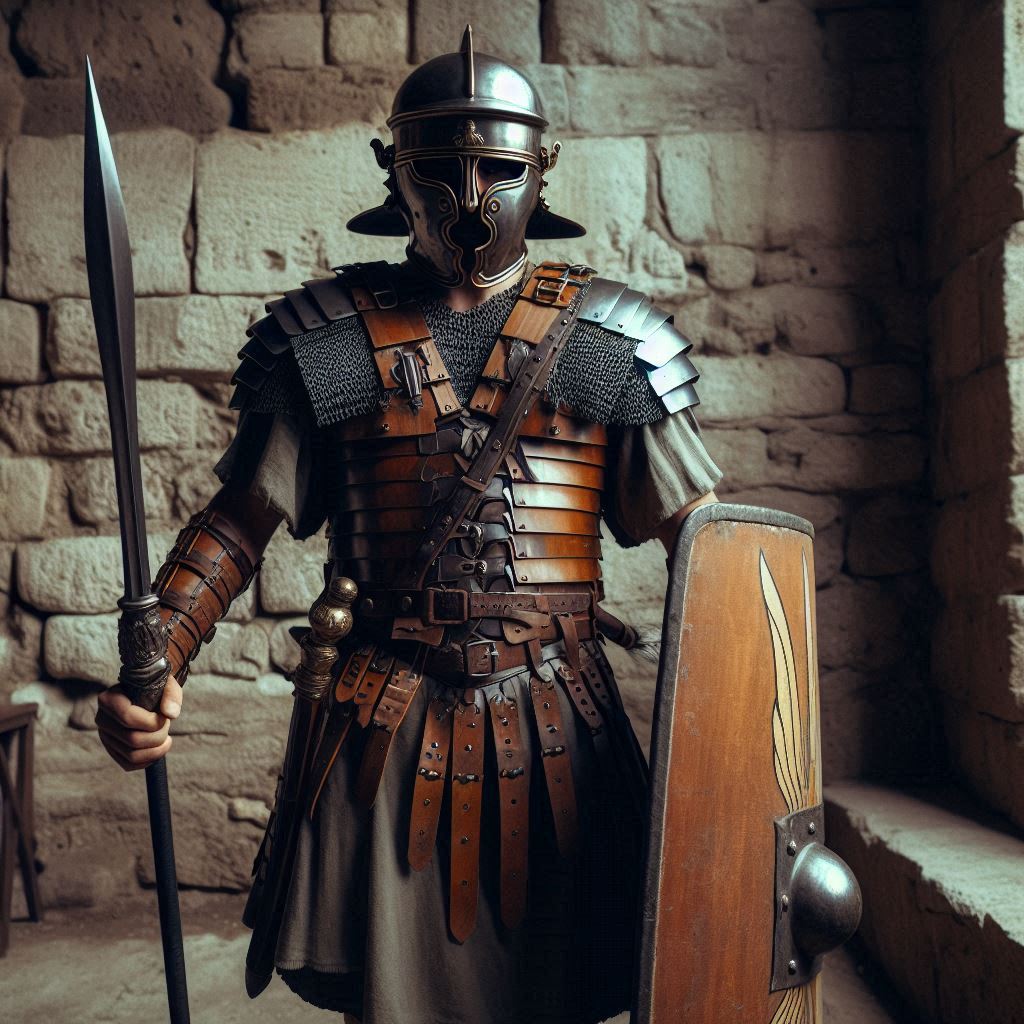
Impact on Military History
The utility of the Roman Subarmalis paved the way for the evolution of military garments. Its design not only benefited the soldiers in their performance but also laid the foundations for future innovations in personal protection. The legacy of this garment can be seen in the ongoing research and historical reenactment carried out by reenactor groups and academics, highlighting its importance over the centuries.
| Aspect | Description |
|---|---|
| Origin | Ancient Greek cultures, perfected by the Romans |
| Material | Treated leather and padded fabrics |
| Main function | Cushioning blows and protecting the soldier's body |
The tunica manicata is an intriguing element of Roman clothing that has endured over time and influenced various cultures. Below, we will explore its origin, characteristics, and evolution throughout history.
Characteristics of the Tunica Manicata
The tunica manicata is distinguished by its design that includes long sleeves, unlike traditional tunics, which were usually shorter and sleeveless. This garment was often made from materials such as cotton and wool, providing more warmth in cold climates.
- Protection in cold climates: Its design with long sleeves provided the wearer with greater comfort and warmth.
- Materials: Generally made of wool or cotton, adapted to the needs of the climate.
- Decorative elements: Often adorned with clavi and calliculae, which not only evoked aesthetics but also the wearer's social status.
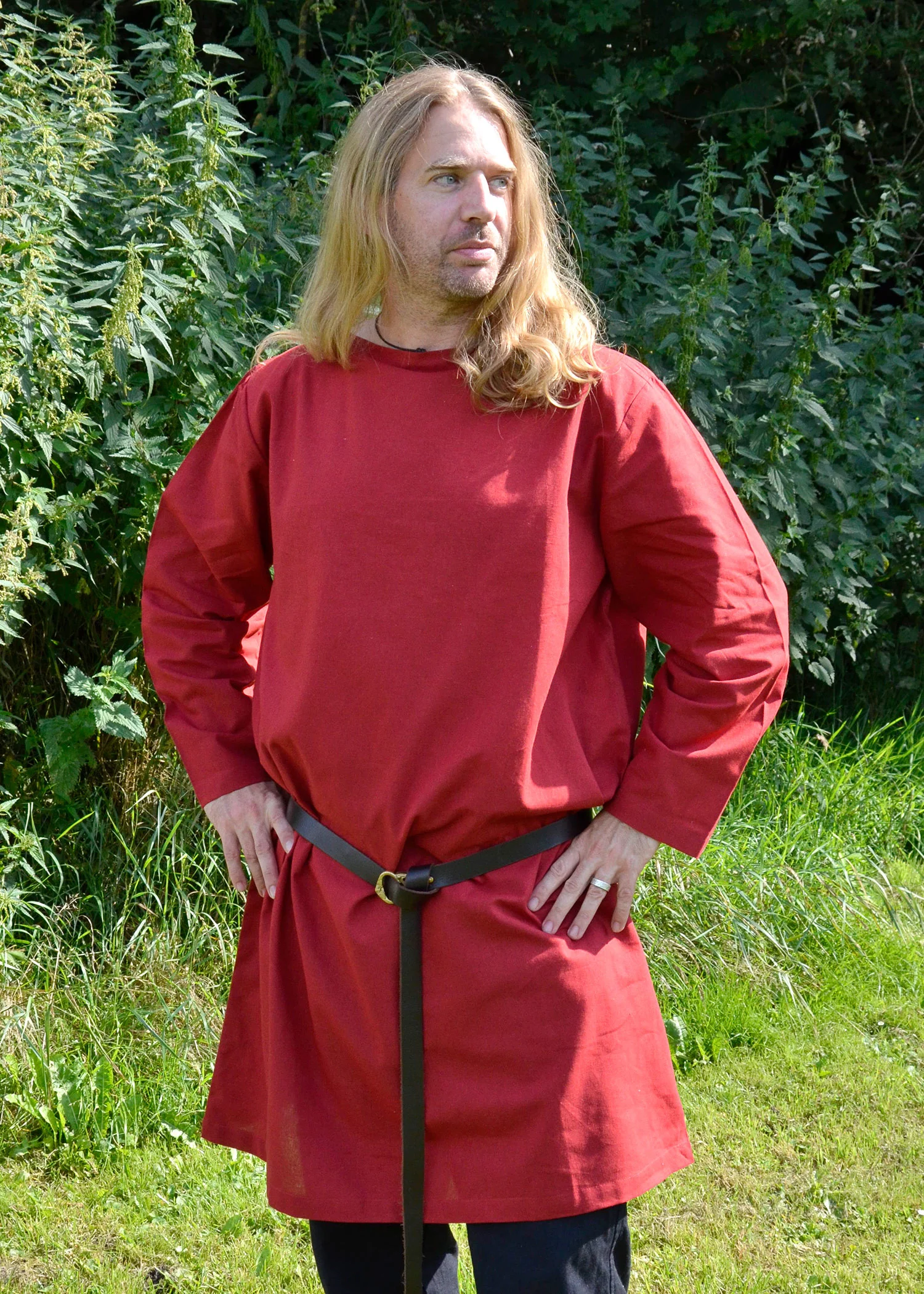
Origins and Use
The tunica manicata emerged as a response to the needs of those Romans living in regions with colder climates. It was particularly popular among legionaries and citizens who required more robust and functional garments to survive harsh winters.
Evolution Through the Centuries
As history progressed, the tunica manicata was adopted into various cultures and styles. In the Middle Ages, long-sleeved tunics became common not only in civil clothing but also in ecclesiastical attire, embellished with elaborate embroideries.
- Influence on medieval clothing: Its design significantly influenced medieval fashion trends, where long tunics with sleeves became a staple in attire.
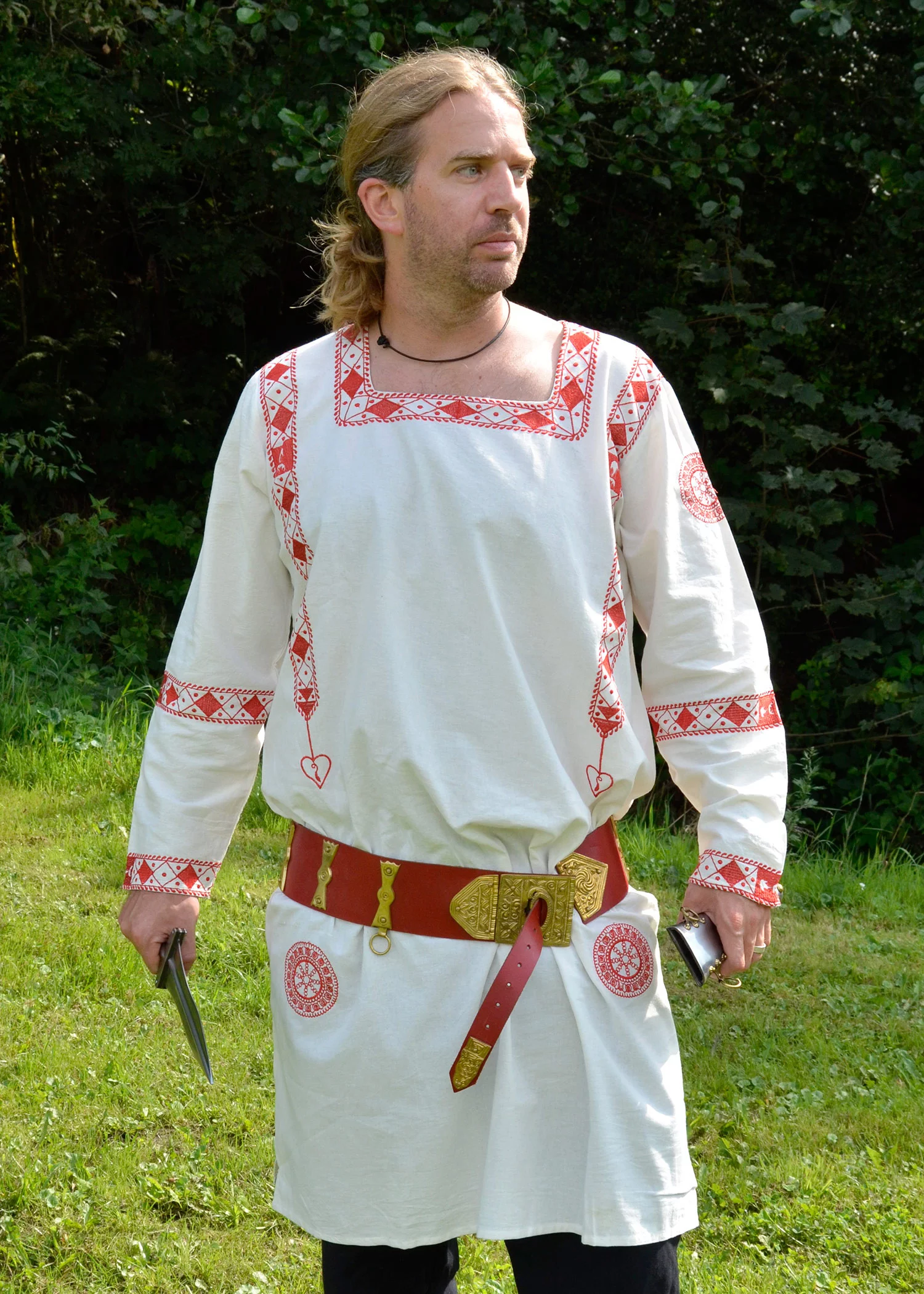
Conclusion
The tunica manicata is more than just a garment; it is a reflection of the cultural and climatic adaptations of ancient Rome. Its durability and ability to transform over time demonstrate its importance in the history of fashion and clothing. Every detail of this tunic tells a story that has influenced subsequent generations, leaving an indelible mark on attire throughout time.
| Characteristic | Description |
| Sleeve type | Long |
| Materials | Cotton, wool |
| Decoration | Clavi, calliculae |
| Uses | Cold regions, military and civil use |
The medieval pellote is an emblematic garment that played a crucial role in the clothing of the Middle Ages, especially between the 13th and 14th centuries. This piece was not only a clothing element but also a symbol of social status and fashion. In this article, we will explore its characteristics, history, and variations.
Origin and Characteristics of the Pellote
This garment has its roots in the Iberian Peninsula and quickly became popular throughout Europe during the 14th century. Some of its most notable features include:
- Side openings: The pellote features wide armholes that reach the hip, allowing freedom of movement.
- Round neckline: It is characterized by a round neck design that adds a distinctive touch.
- Variable length: While women wore longer versions, often brushing the ground, men opted for shorter models, facilitating horseback riding.
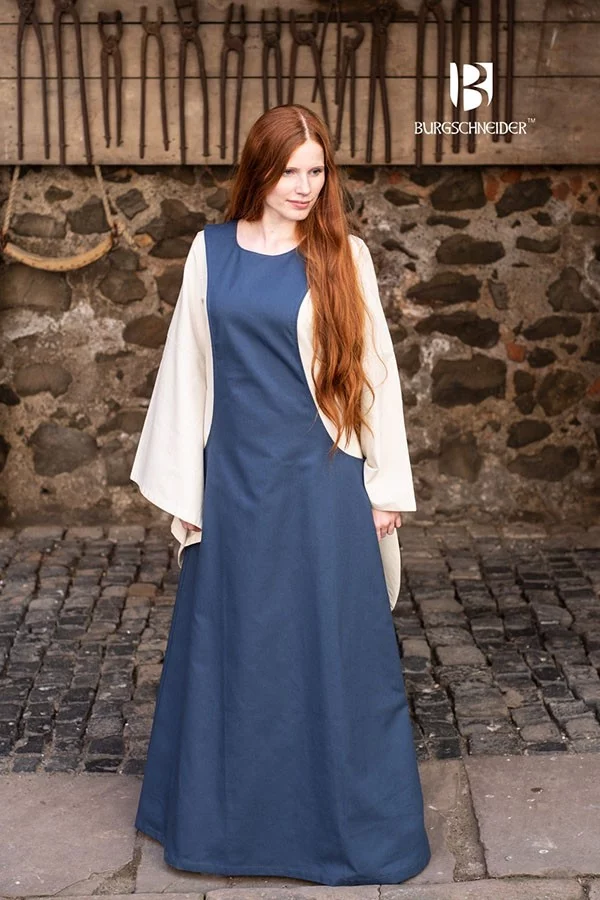
Materials and Manufacture
Pellotes were mainly made of leather or different types of fabric. It was common for fabric models to be lined with animal fur, usually rabbit. This use of fur was not only for style but also for warmth in cold climates.
Usage and Social Significance
The pellote was worn by both men and women, but the length and style varied by gender:
- Men: Wore shorter and more practical pellotes, ideal for mobility.
- Women: Preferred longer and more fitted versions that often hid footwear, emphasizing their status.
Among the nobility, the pellote was considered a symbol of wealth and power, sometimes so long that it dragged on the ground.
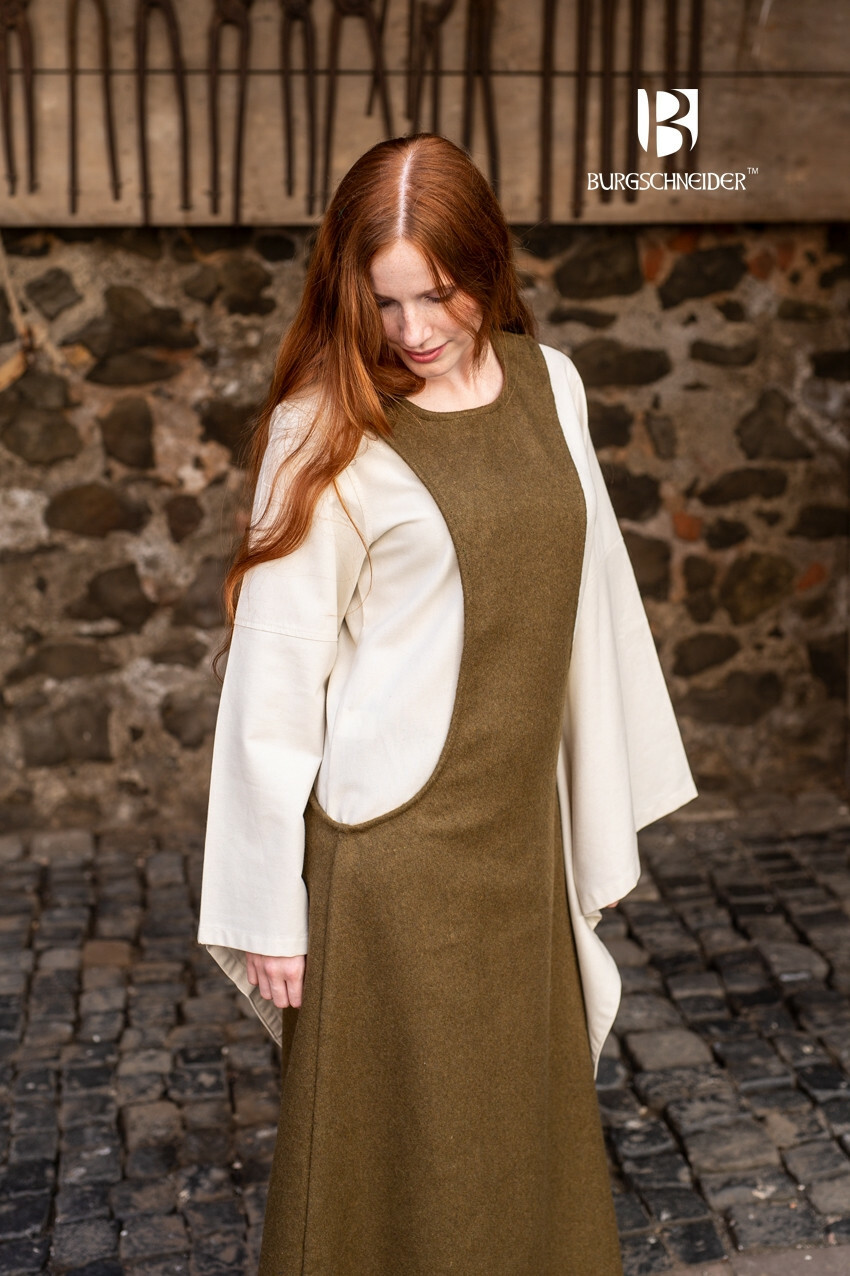
Cultural Reflection
The pellote was not only a functional garment but also reflected changes in fashion and social status throughout history. Its design and materials varied over time, adapting to the trends and needs of each era, making it a key piece of medieval clothing.
| Type of Pellote | Gender | Length | Materials |
| Women's Pellote | Female | Long (floor-length) | Leather, Fabric with Fur Lining |
| Men's Pellote | Male | Short (facilitates riding) | Leather, Fabric |
The Hangerock or Smokkr is a distinctive garment of Viking Age women's clothing that has captivated both historians and historical reenactment enthusiasts. This dress, also known as an 'apron-dress' or 'Viking apron,' combines functionality with a design that reflects Scandinavian ingenuity and culture. While the exact term used by Viking women to refer to this garment is unknown, archaeological evidence and studies have allowed us to reconstruct its appearance and function.
Origin and Characteristics of the Smokkr
The Smokkr was used between the 8th and 11th centuries and was a common part of Scandinavian women's attire. Its design resembles a pinafore-style dress worn over a linen inner tunic, protecting it and serving as the primary garment.
- Functional design: It was a rectangular piece that covered the torso and was fastened with oval brooches over the shoulders.
- Materials: Generally, the Smokkr was made of wool, with a linen interior for added comfort. Some versions included decorative silk details.
- Ingenious fastening: The garment was secured with small fabric loops (often linen) hooked into bronze oval brooches, an iconic feature of Viking women's clothing.
Archaeological Evidence
Much of what is known about the Smokkr comes from archaeological findings in places like Birka, a major Viking trading town in Sweden. Textile fragments found in these sites provide essential clues about its construction and style.
- Fabrics: Remnants of blue wool and decorative silk bands showcase the Vikings' textile craftsmanship.
- Oval brooches: These brooches have been discovered in numerous burial sites, confirming their central role in fastening the Smokkr.
- Minimalist ornamentation: While functional, some Smokkrs included tablet-woven bands for decorative purposes. These weaving techniques created unique geometric patterns.
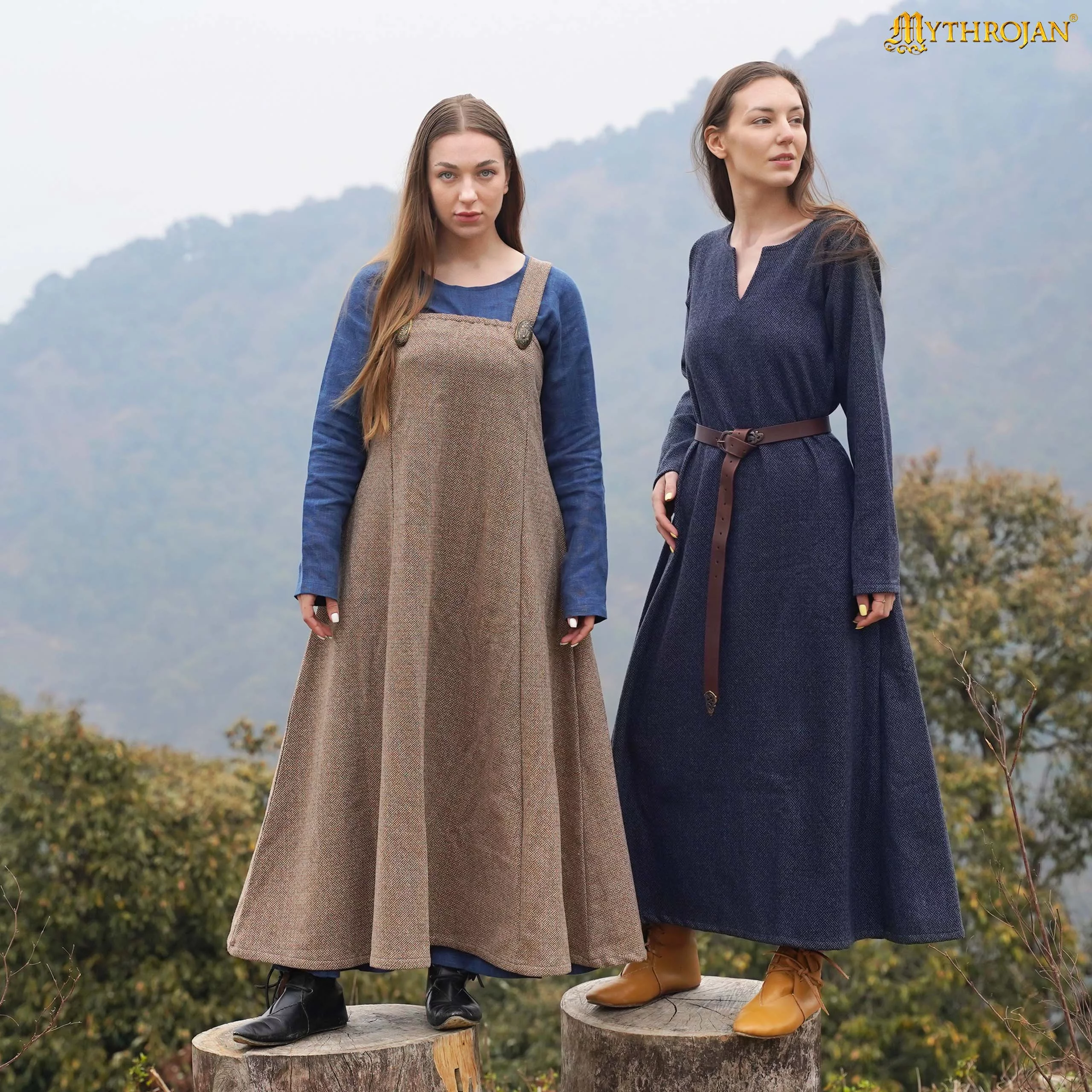
Modern Recreations
Historical reenactors and experts in Viking fashion have worked to recreate the Smokkr based on archaeological evidence and traditional weaving techniques. These representations help us better understand its daily use during the Viking Age.
- Authentic materials: Reconstructions use wool, linen, and silk decorations, replicating original designs.
- Oval brooches: These are crafted based on historical pieces, essential for the garment's authenticity.
- Decorative details: Some recreations include tablet-woven bands handmade for authentic geometric patterns and metallic fabric details, such as artificial gold threads.
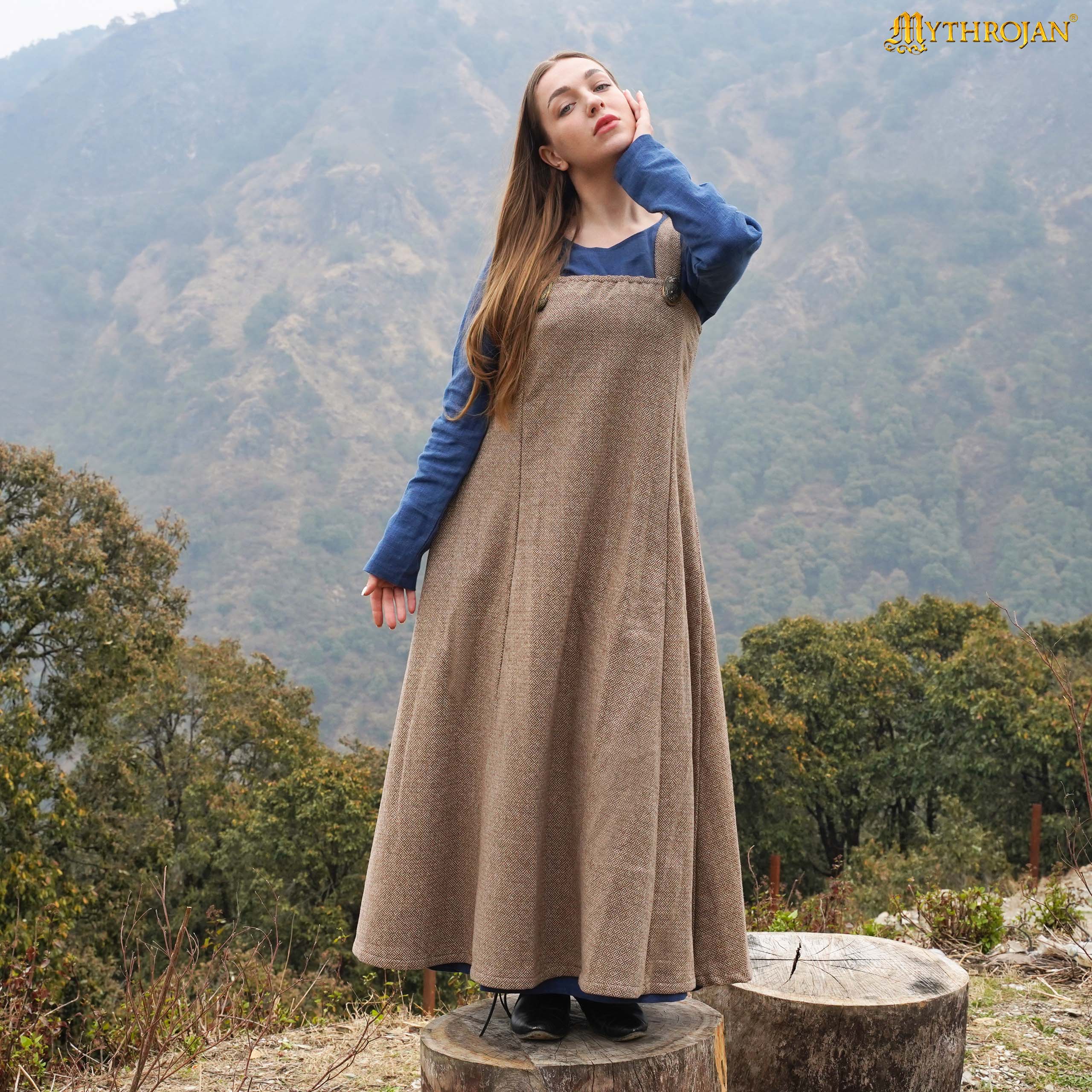
Historical and Cultural Significance
The Smokkr not only served a practical function in Viking attire but also had a representative component of status and craftsmanship. Brooches and decorations might have reflected the wearer's wealth, while the use of advanced weaving techniques showcases Viking women's high level of skill in textiles.
| Element | Material | Function | Decoration |
| Main fabric | Wool | Dress body | Silk band |
| Interior | Linen | Comfort | No |
| Brooches | Bronze | Fastening | Yes |
| Tablet-woven band | Silk/Cotton | Decoration | Geometry |
The overcoat, known by various names depending on the region, such as coat, cloak, or paltò in Italian, is a garment of great historical and practical importance. Over time, it has played essential roles not only in fashion and personal protection but also as a symbol of distinction and status.
Origin and History of the Overcoat
In the Middle Ages, the overcoat was used in a very practical way, especially during the Crusades. It acted as an additional layer over the knights' plate armor, providing protection against the scorching heat of the sun during campaigns in desert regions. Furthermore, these garments were often adorned with heraldic emblems representative of different orders of chivalry, such as the Templars, Hospitallers, and Teutons. By fulfilling this role, overcoats not only served a practical function of protection but also conveyed important information about the identity and affiliation of their wearers on the battlefield.
Characteristics of the Overcoat
- Design: This garment extends below the hip and fastens at the front with buttons. In some designs, a belt accompanies the closure to secure the garment and provide a better fit.
- Functionality: Its primary purpose has always been to provide protection against the elements, including cold and rain. It is designed to be worn over other clothing, ensuring the necessary warmth in adverse climates. During the Middle Ages, its function also extended to being an additional protective layer over armor, shielding it from heat and moisture.
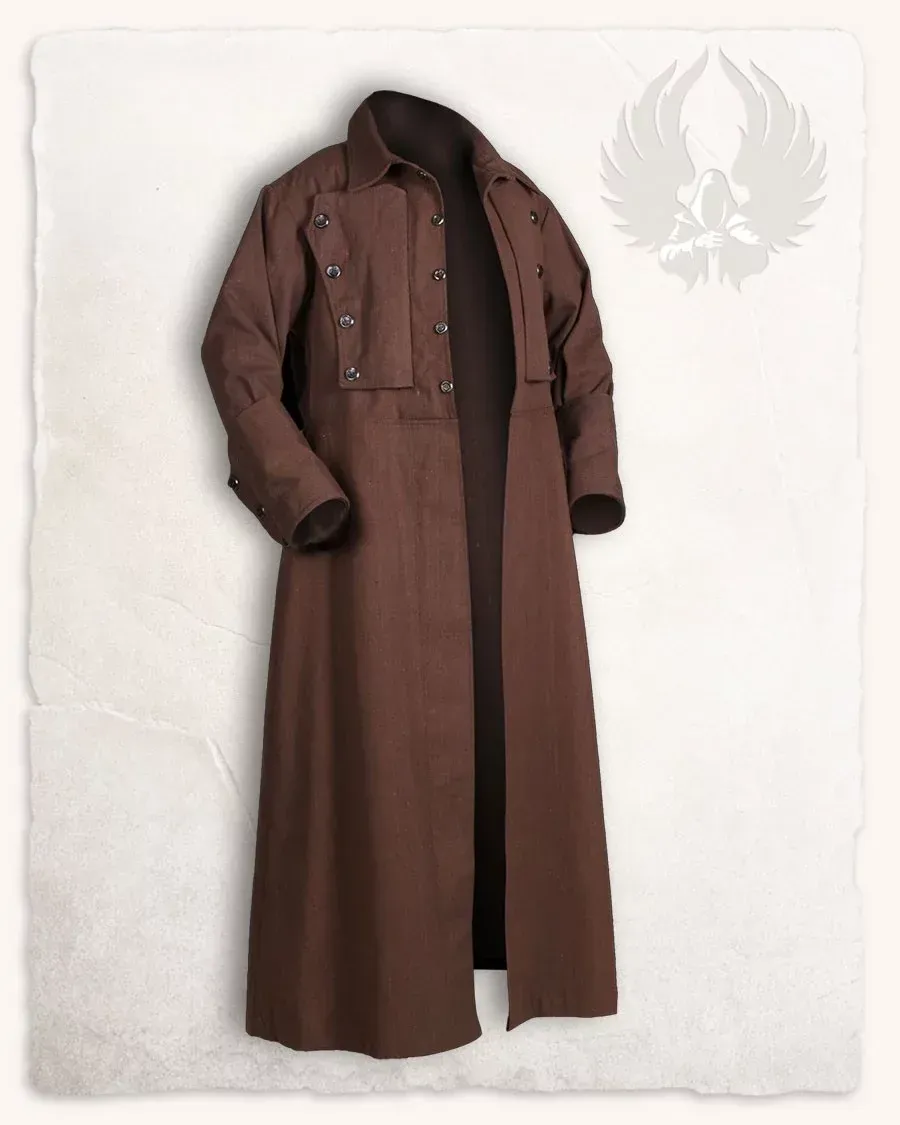
The Overcoat in the Middle Ages
Beyond its protective purpose, the overcoat played a crucial role in the visual representation of the orders of chivalry. Women also wore overcoats as a cape over their dresses, following the fashion trends of the time. These elements not only provided protection in difficult climate contexts but also formed part of the visual language of chivalry, communicating Order, rank, and loyalty.
The Overcoat in Modern Recreation
In modern times, the overcoat has retained its relevance in multiple areas, including medieval recreation and live-action role-playing (LARP) activities. In these contexts, overcoats not only serve to faithfully recreate the medieval aesthetic but also provide a functional level for participants. It is recommended to combine them with a dress and a belt, allowing for the comfortable carrying of additional items.
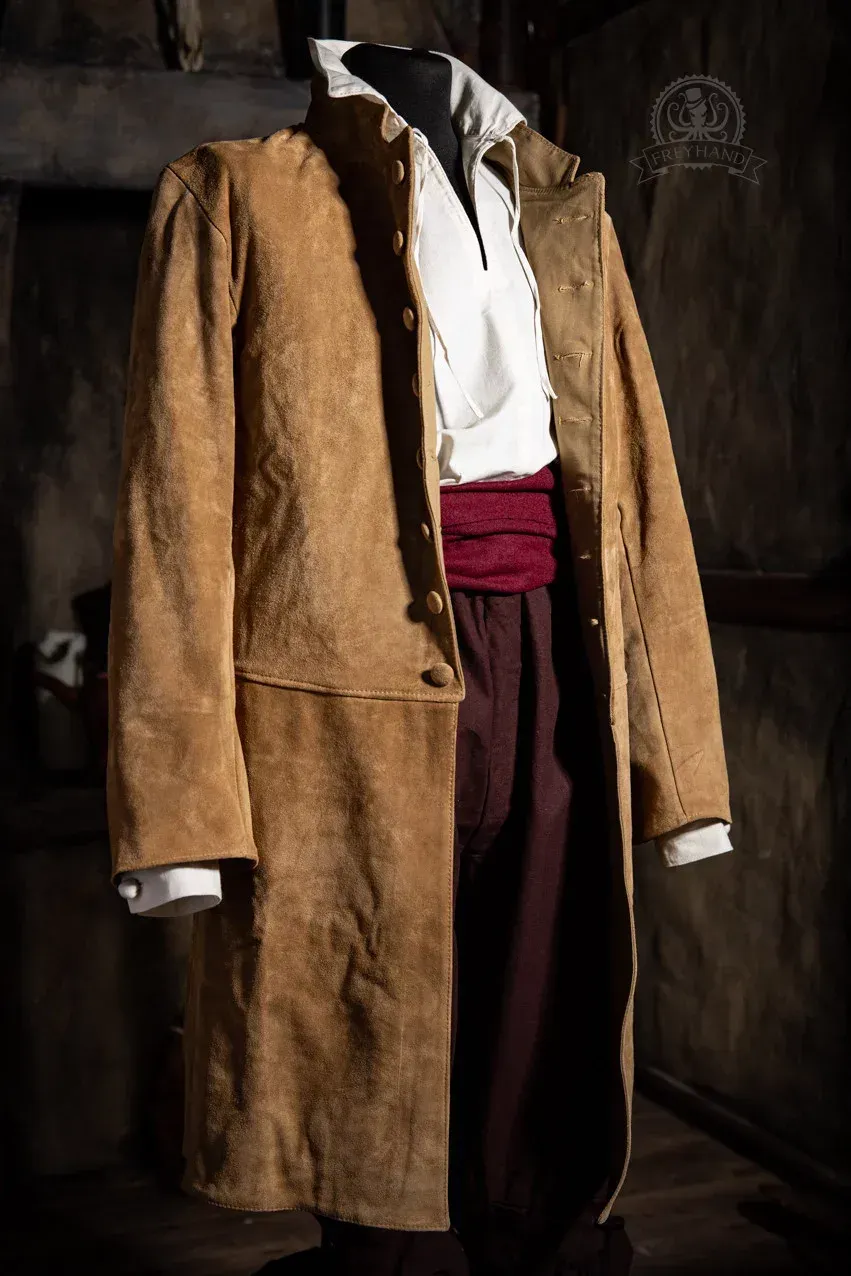
An Overcoat Dress
Today, the overcoat has adapted to various styles and uses, always maintaining its essence of offering elegance and functionality. Despite modern variations, its classic design has endured and continues to be a common garment choice in cold or rainy climates, thanks to its ability to provide additional layers of warmth and protection.
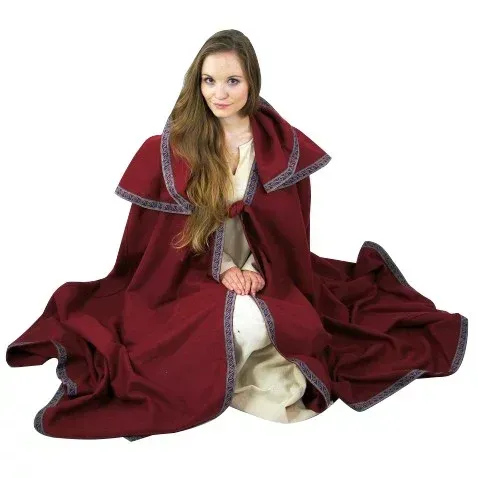
The durability of the overcoat, both in form and purpose, has made it an iconic piece in contemporary fashion, valued for its timeless style and its capacity to offer reliable protection against the elements. It is a garment that, without a doubt, has been present for centuries in the history of fashion and continues to be a pillar in wardrobes around the world.
The paletoque is a men's garment that played a fundamental role in the fashion of the Late Middle Ages and the Renaissance. Traditionally made from materials such as suede or wool, this coat symbolizes not only functionality and style but also the social status of those who wore it.
Origin and Evolution of the Paletoque
The paletoque, like many garments of its time, is enveloped in the rich history of medieval fashion. Originating in the Late Middle Ages, its use spread into the Renaissance period, where it evolved in design and purpose. The Royal Spanish Academy (RAE) describes it as a "capotillo," highlighting its characteristic as a protective cloak, similar in function to other styles such as the surcoat and the hopalanda.
Distinctive Features of the Paletoque
- Extended Length: Unlike its contemporaries, the paletoque is characterized by its length, which surpasses the waist. This quality notably differentiates it from the doublet and brings it closer to outerwear such as the over garment.
- Unique Sleeves: Over time, the paletoque acquired different configurations in its sleeves, which were initially short and, in some of its later uses, even disappeared completely.
- Contextual Variants: There is a notable contrast in the use of the paletoque based on age and social status. Young people preferred shorter versions, while older individuals opted for longer versions that reached down to the feet. The sleeves, when present, varied between short and notably long and flowing.
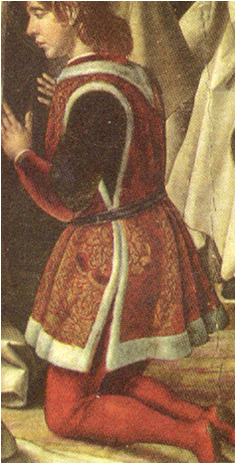
History and Influence of the Paletoque
In the 15th century, this garment was widely used, sharing similarities with the huca and the jornea. They were made by joining two pieces of fabric at the shoulders, often with floating sleeves. However, in the 16th century, the paletoque fell out of favor among the nobility, becoming relegated to the clothing of artisans and peasants. The adaptation of the paletoque over the centuries demonstrates an evolution parallel to the social, economic, and cultural changes of medieval Europe.
Materials and Style
The making of the paletoque in "rich fabrics," as well as its occasional lining in velvet, denotes the user's status. These choices of materials and adornments were not purely aesthetic but reflections of the role of clothing as a symbol of wealth and prestige. Beyond its function as outerwear, the paletoque also possessed a practical component, evidenced by details such as the laces found in some models, suggesting a design focused on everyday functionality.
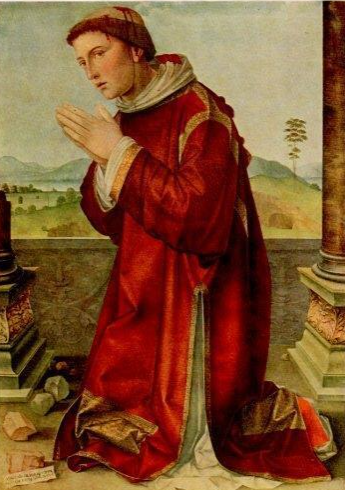
Cultural Significance of the Paletoque
The paletoque not only represents a historical garment but also a reflection of the social context in which it developed. Its evolution and use over the years, from a garment of nobility to a symbol of the working class, offers insight into the social dynamics of the time. This capotillo provides a window into the ideals of fashion, function, and status in its golden days, remaining a testament to the changing styles and trends of clothing in medieval and Renaissance Europe.
The "valona" is an iconic garment from the 17th century, known for its impressive design and cultural significance. It is a wide, turned collar that drapes over the shoulders, adorning the clothing of the era with a touch of elegance. Although its initial acceptance in Spain was limited, due to its Flemish origins, the valona established itself as an essential piece in both male and female wardrobes.
Origins of the Valona
The valona has its roots in the Netherlands, specifically in the region of Flanders. Despite its name, which might evoke Wallonia in Belgium, it was in Flanders where this garment began to take shape. Originally, it was a smooth, circular, starched fabric that was often adorned with lace, making the collar shine and adding a touch of sophistication to the garments of that era.
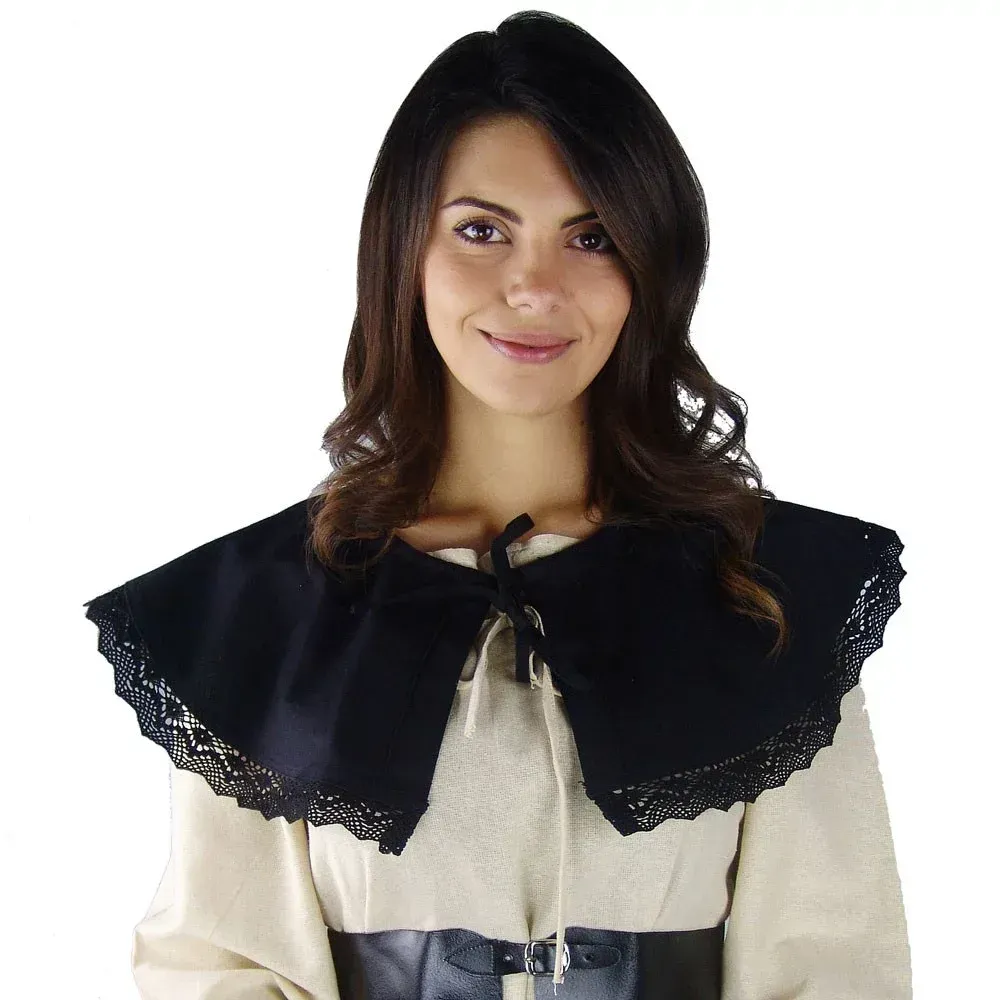
Distinctive Features
- Turned Collar: The valona is known for its wide, turned design that covers the shoulders and part of the back. This collar style provides an elegant and striking appearance.
- Embellishments: Often, the valona was decorated with lace, trimmings, and borders, which enhanced its sophistication. These embellishments could extend to other parts of the wardrobe, including cuffs and stockings.
Impact in Spain
Initially, the valona was not well-received in Spain due to its simplicity and foreign origin. However, the garment gained tremendous popularity when King Philip IV decreed in 1623 its mandatory use over the "golilla". This mandate propelled the acceptance of the valona in Spanish fashion, transforming it into a staple of the era's wardrobe.
Female Models
Valona Cariñana
This particular model was popularized by María de Borbón-Soissons, Princess of Carignan. It consisted of a large lace collar that left visible the area from the throat to the beginning of the chest, adorned with chokers and necklaces for added elegance.
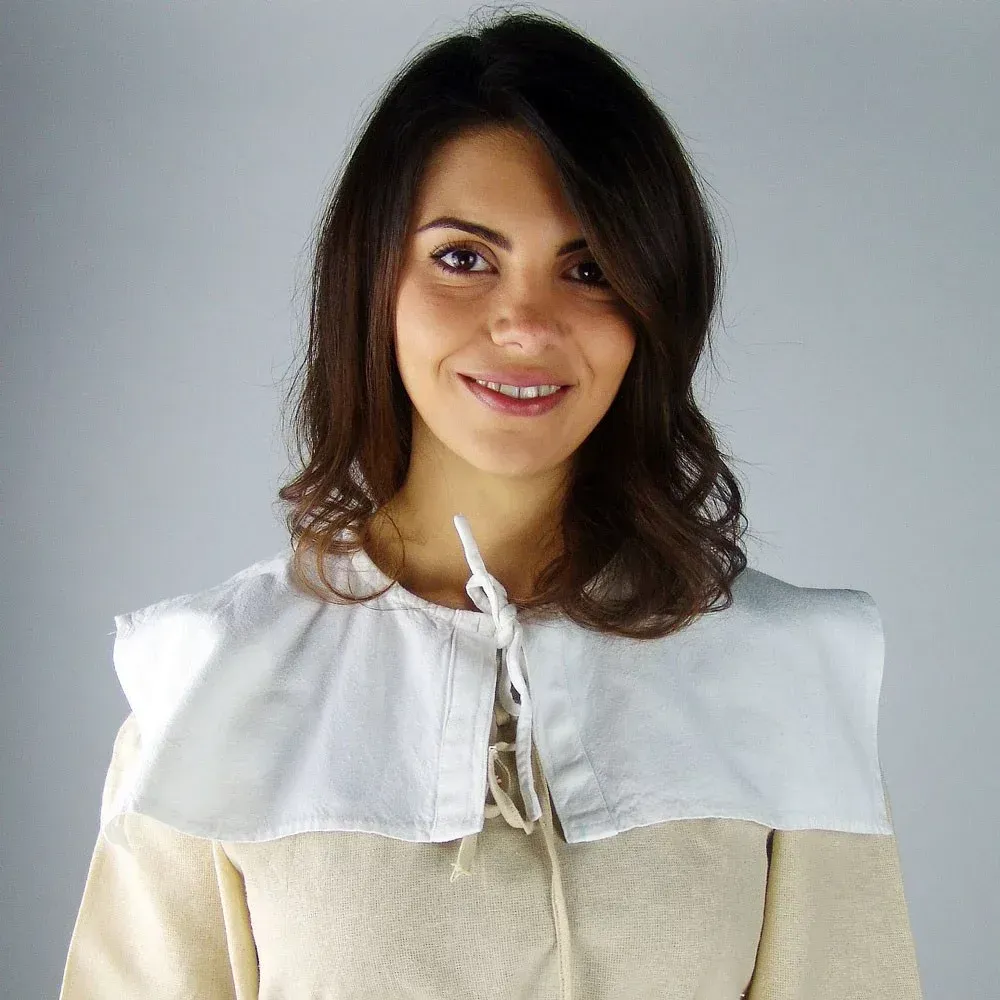
Other Models
Another notable model from the era was the fan collars, present since the late 16th century. These collars exposed the throat and fanned out behind in a fan shape, supported by a wire structure.
Cultural Significance
The valona was not only a fashion item but also played an important role in the cultural tradition of the 17th century. Its popularity among men and women is reflected in detailed descriptions from the time, such as those by the Spanish costumbrista writer Juan de Zabaleta. Despite its eventual replacement by other fashionable items like the golillas, the valona left a significant legacy in cultural and fashion history.
Evolution and Legacy
Over time, fashion styles evolved, and the valona was gradually replaced by other elements such as the golillas or "valoncillas," preferred by King Philip IV. Nonetheless, the influence of the valona on 17th-century fashion persists to this day, illustrating the richness of culture and style from that period.
The valona stands out as a garment that not only covered but also adorned with detail, witnessing an evolution in fashion that propelled it to the honored place it occupied during its time.
The chaperon is a medieval headdress that was widely used in Western Europe during the Middle Ages. Its usage spread particularly from the 13th to the 15th century, reflecting both the functionality and social status of the wearer. Over the centuries, this garment evolved from a simple hood to a complex and elaborate element within medieval clothing.
Origins and Description of the Chaperon
The term "chaperon" comes from the French "chaperon," which has its roots in the Latin "cappa," referring to a cape or hood. Originally, the chaperon was a short hood with a liripipe, a long tail at the back. It was commonly used as a short cape that could be worn over the head or tied at the front, providing protection against inclement weather.
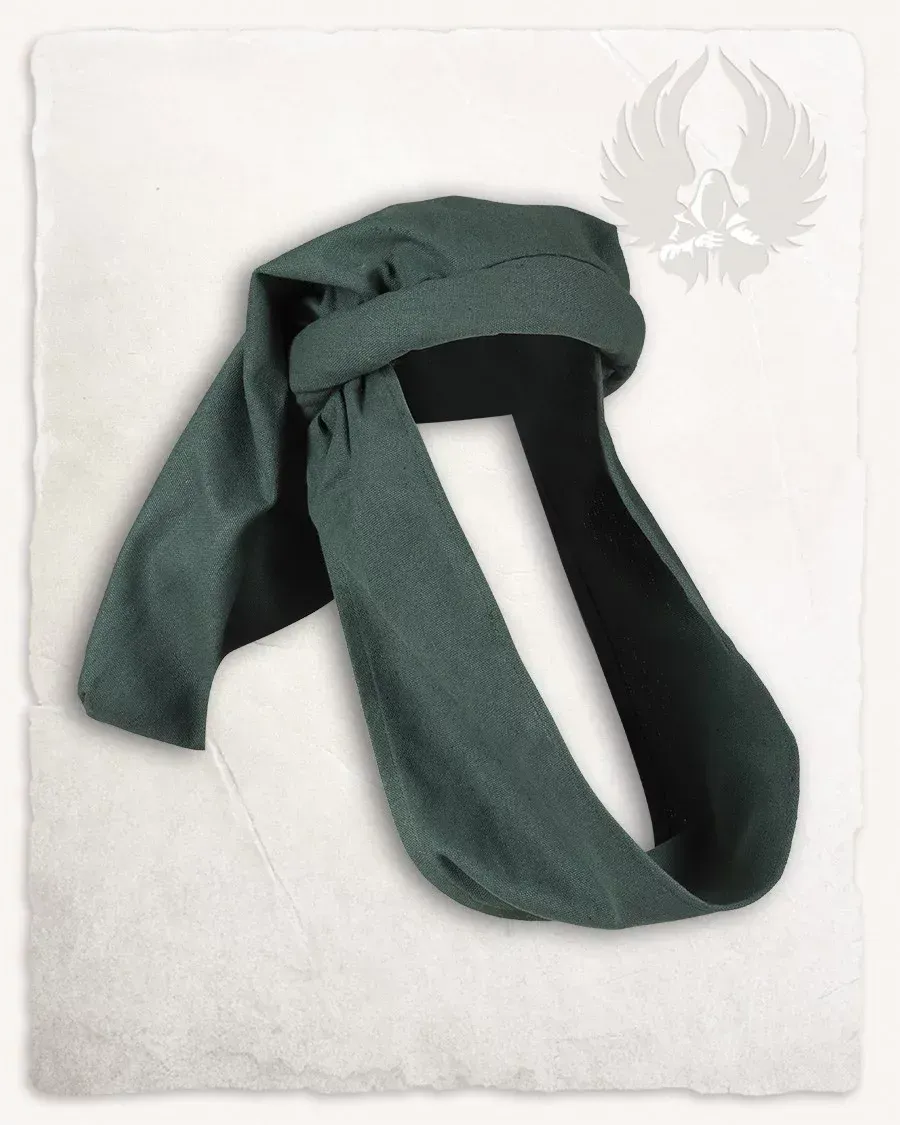
Evolution and Typology
Over time, the chaperon underwent a remarkable transformation. It changed from a simple hood to an elaborate garment that reflected the status and fashion of the moment. It became popular in Northern Europe among both men and women. The design evolved to include a wide hood at the back, often ending in a long pointed tail. These garments could be closed, leaving only an opening for the face, or open at the front and fastened with buttons.
Decoration and Embellishments of the Chaperon
The chaperon was not only practical but also decorative. Elements such as the **bourrelet**, a decorative ring, were sometimes added to enhance the outfit's style. Materials used included fabrics like wool and cotton, ideal for providing warmth and protection against rain. During the 14th century, chaperons with pointed hoods became popular, often adorned with turns at the front, achieving a more streamlined and fashionable look.
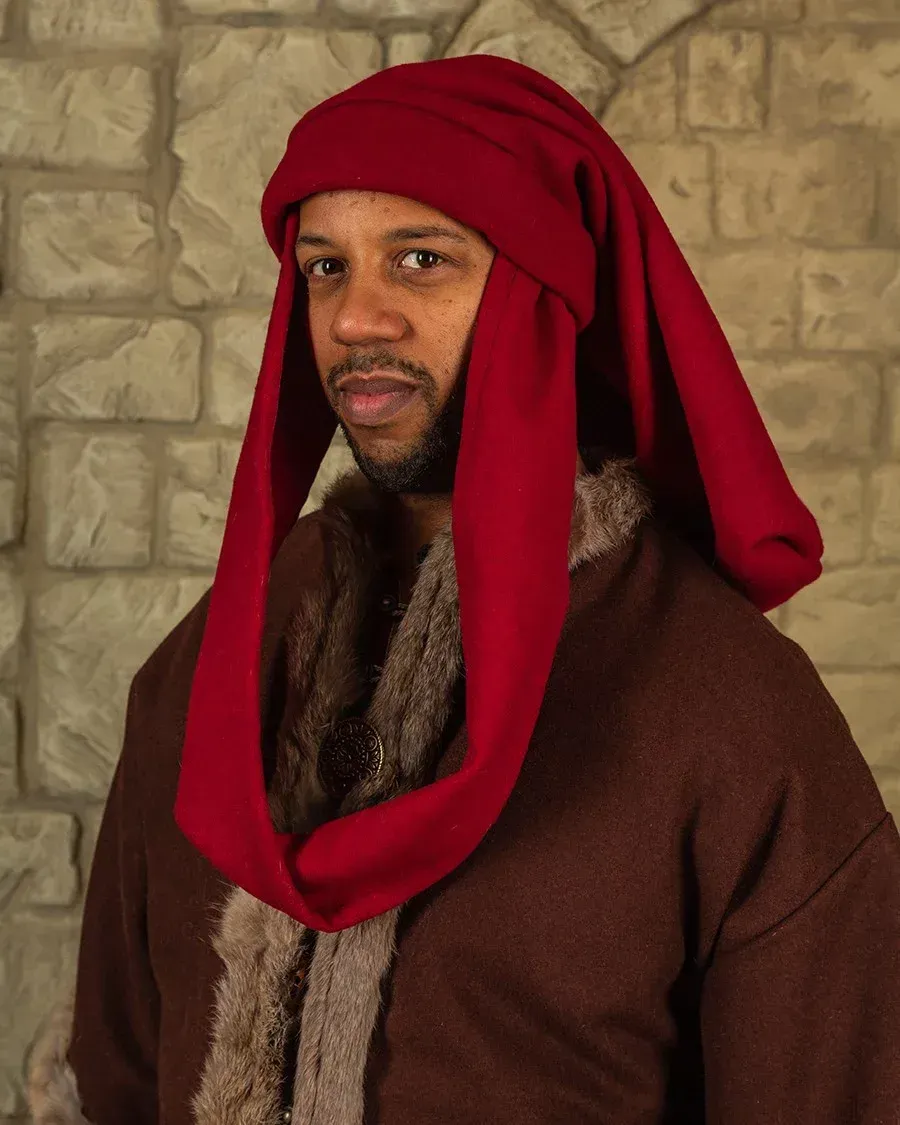
Social and Cultural Use
The chaperon became a symbol of status, especially at the Burgundian court of the 15th century. Terms such as **patte**, **cornette**, and **bourrelet** were used to describe its different components. Chaperons frequently appeared in early Flemish painting, depicting nobles and courtiers with elaborate designs that reflect the sophistication of the era.
Historical Context
The first documentation of chaperons dates back to the late 13th century, when they became popular in Western Europe. During the 14th century, it was common to wear the chaperon in an unconventional manner, placing the head through an opening meant for the face. This led to a variety of unique and sophisticated styles that prevailed until the 15th century.
The Capirote and the Evolution of the Term
The chaperon, also known as capirote or capirón, originated in France and was adopted by various social classes, with women beginning to wear it from the 14th century. Although there are no records of women's use in the 15th century, this garment initially served a similar function to the hood or 'capuchon' of 11th-century cloaks, offering protection against the elements. Later, it evolved and came to be called "chapel" in the 15th century.
| Culture | Period | Material | Decoration |
|---|---|---|---|
| Western Europe | 13th-15th Century | Wool, Cotton | Bourrelet, Turns |
| Burgundian Court | 15th Century | Luxury Fabrics | Patte, Cornette |
The chaperon stands as a distinctive garment of the Middle Ages, whose evolution from a simple hood to an elaborate accessory reflects the creativity and sophistication of medieval fashion in Western Europe.
French-Burgundian medieval fashion is a fascinating topic that transports us to a time of great cultural and creative wealth. Two emblematic garments from this period, the Hopalanda and the Haincelín, stand out for their beauty and functionality. Although they share a common origin and certain decorative features, these garments have clear distinctions that made them unique for their specific use.
Similarities between the Hopalanda and the Haincelín
-
Origin and Historical Context:
- Both garments have their roots in the fashion of the French-Burgundian region, a hallmark of European clothing during the Middle Ages.
- They were primarily used in the court setting, standing out as luxury garments due to their association with ceremony and social status.
-
Materials and Techniques:
- They were made from fine materials such as wool, silk, and velvet, which provided them with an attractive and sophisticated appearance.
- The decorative details included lost sleeves, embellishments on the edges, and high collars, distinctive features of Late Gothic fashion.
-
Social Function:
- Both garments served not only to keep warm but also as symbols of status and personal wealth for those who wore them.
Differences between the Hopalanda and the Haincelín
-
Length and Design:
- Hopalanda: It was longer, often reaching the floor and could have a train. It was fitted at the shoulders and cinched with a belt.
- Haincelín: It was shorter and fitted, primarily used as an outer garment, making it more practical and functional for daily wear.
-
Use and Purpose:
- Hopalanda: It was intended for ceremonies and formal events due to its voluminous and distinctive design.
- Haincelín: Designed for a more informal setting, it was suitable for everyday warmth, reaffirming its versatility.
-
Decoration and Style:
- Hopalanda: Included an elaborate style with lost sleeves and high collars, reflecting a more ornamental and sophisticated taste.
- Haincelín: Featured a simpler, more functional style with closed sleeves and a lower collar, suitable for more practical use.
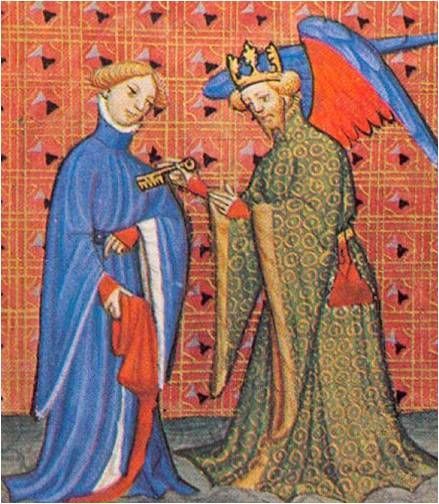
In studying these fascinating garments, the Hopalanda and the Haincelín, it is evident how dressing reflected more than just a functional or warmth need; it was also a means of communication about status, wealth, and occasion. The differences in design, length, and purpose highlighted how each garment adapted to the social and personal requirements of those times. While the Hopalanda shone in formal settings, the Haincelín served a more practical purpose, adapting to everyday life without losing its touch of elegance. Medieval fashion, with its rich variety of fabrics and decorations, remains a testament to the ingenuity and creativity of that era.
| Hopalanda | Haincelín | |
|---|---|---|
| Main Use | Formal ceremonies | Everyday warmth |
| Length | Long, to the floor | Short, fitted |
| Decoration | Elaborate, lost sleeves | Simple, closed sleeves |
| Main Materials | Wool, silk, velvet | Wool, silk, velvet |
The Hopalande, also known as Houppelande or simply "hopa," is an iconic historical garment of medieval European fashion. This piece of clothing not only defines the refined and ostentatious aesthetic of its time but also reflects the social distinction and taste for luxury characteristic of the 14th and 15th centuries. Let’s explore more about the design, use, and legacy of this fascinating garment.
Design and Features
The Hopalande is a long outer garment, known for its wide sleeves and funnel-shaped collar. This particular design makes it stand out among medieval clothing, especially among the affluent classes. The sleeves could be so long that they sometimes touched the ground, adding a touch of volume and elegance.
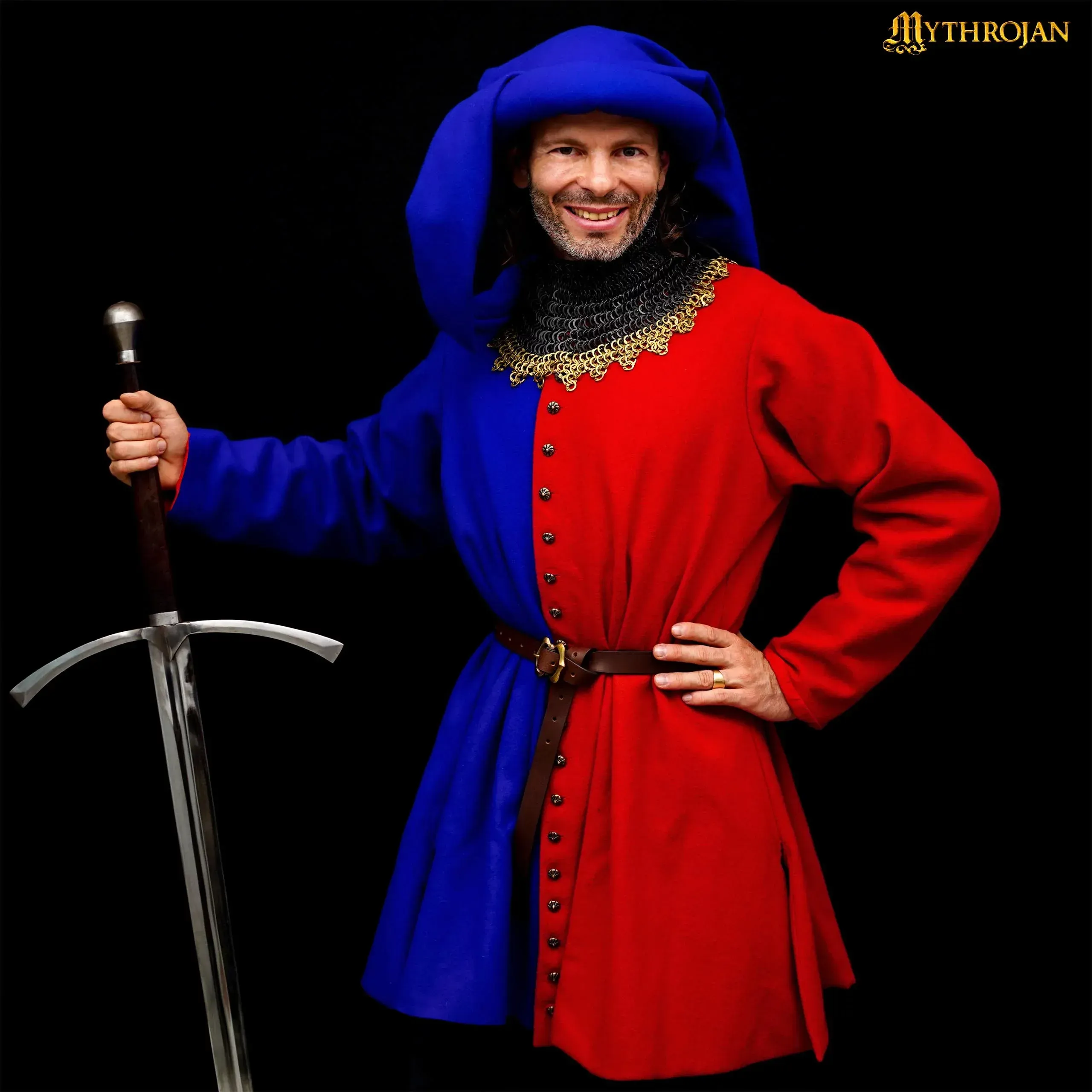
Use and Social Context
The Houppelande was worn by men, women, and children at important social events such as ceremonies, dances, and strolls. This garment was made from elaborate fabrics like silk, brocade, and velvet, reflecting the social status of the wearer. Its use was often limited to special occasions due to its luxurious and elaborate design.
Variations and Embellishments
Throughout the 14th and 15th centuries, the Hopalande underwent modifications in its structure while maintaining its main characteristics. The design of the collar could vary, sometimes being low or raised, and it often featured front openings for ease of movement. The embellishments included details on the sleeves and the edge of the skirt, often elaborated with fur.

Decorations and Lining
In addition to the fur trimmings and decorations, the inside of the Hopalande was lined with fur for warmth during the winter months. An ornate and rich jewel like the belt complemented the garment, often set with precious stones, adding a touch of luxury.
Variants of Use
The length of the Hopalande varied according to its purpose. For ceremonial events, it commonly reached the ground. However, for activities such as hunting or dancing, it was shorter, sometimes reaching the thighs. This shorter version, called Haincelín, was exclusively for men.
Influence and Legacy
Although shorter and more fitted garments became popular over time, the Hopalande retained a prominent place in fashion due to its representation of distinction. This taste for long and elaborate clothing influenced dress until the 16th century, especially in the attire of monarchs and professions that required a dignified appearance.
| Type of Garment | Use | Fabric | Details |
|---|---|---|---|
| Long Hopalande | Ceremonies and Events | Silk, Brocade | Long sleeves, Funnel collar |
| Haincelín (Short) | Hunting, Dancing | Velvet | Decorated belt |
The Hopalande is undoubtedly a garment that has left a lasting mark in the history of medieval fashion. Its peculiar design, the richness of its materials and ornaments speak of a time when clothing was synonymous with status and class.
In the medieval era, the selection and use of clothing served not only to protect against the elements but also reflected the social status, regionality, and even religious beliefs of the wearer. Two notable garments from this period are the tunic and the tabard. Both have historical relevance and have left a significant cultural mark. Below, we will explore in detail the characteristics that define them and the aspects that differentiate them.
Medieval Tunic
The medieval tunic is an iconic garment that symbolizes much of the European medieval wardrobe.- Origin and Use: With a heritage from Roman and Merovingian clothing, the tunic was an essential garment in the wardrobes of both men and women. Depending on the period and social status, the length, material, and embellishments varied, allowing both upper and lower classes to reflect their respective positions in society.
- Materials and Construction: Tunics were mostly made of linen, cotton, and wool, reflecting the resources available in different regions. Generally, women wore longer tunics, while men opted for shorter versions.
- Decoration and Accessories: While tunics could be simple, those belonging to nobles were adorned with clasps and belts made of precious metals and even embedded with gemstones, symbolizing wealth and power.
- Styles and Variations: Over time, tunics evolved; the upper classes preferred body-hugging designs, while the peasantry remained with more somber styles.
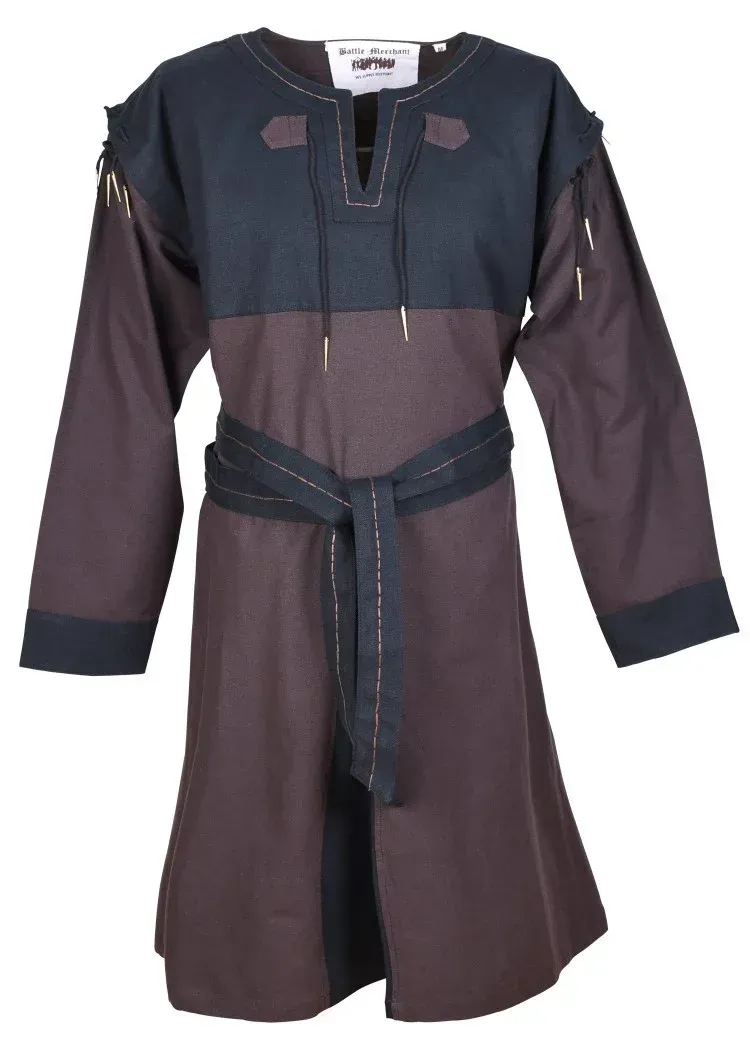
Medieval Tabard
The medieval tabard is another distinguished garment, often worn over the tunic for multiple purposes.- Origin and Use: Originally, the tabard functioned as a cloak to provide warmth and display status. Over time, it became a separate garment, used both for ceremonies and more practical functions such as in battles.
- Materials and Construction: Similar to tunics in terms of fabric, they were frequently lined for greater durability.
- Decoration and Accessories: Also decorated with embroidery and clasps, although its function remained more practical and less ceremonial than the tunic.
- Styles and Variations: Variations occurred in both length and design, depending on the specific use, whether as a short cloak or a longer overgarment.
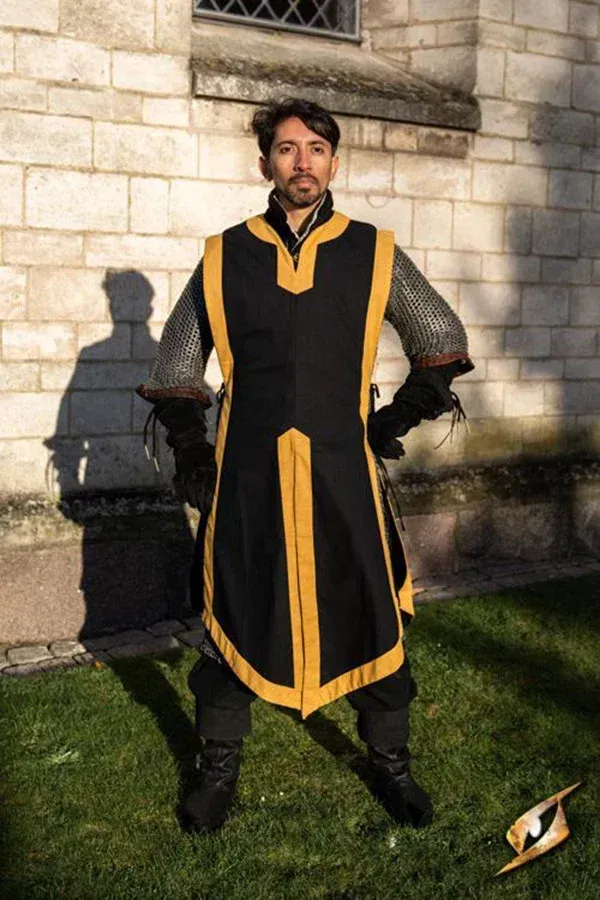
Detailed Comparison
| Attribute | Medieval Tunic | Medieval Tabard |
|---|---|---|
| Length and Fit | Generally longer, covering the torso and legs. | Shorter, used as a cloak or overgarment. |
| Function | Basic clothing item used daily. | Provides additional protection, signifies status. |
| Decoration and Accessories | Adorned with various decorations depending on social status. | Similar decorations, but with a practical focus. |
| Styles and Variations | Evolved according to fashions and social classes. | Adapted to its use as a cloak or overgarment. |
Through this comparison, we can observe how medieval clothing not only served a practical function but also reflected the society of those times. Both tunics and tabards are distinctive of medieval fashion, each with its peculiarities and specific purposes.
The comparison between the **gambeson** and the **brigandine** allows us to delve into the fascinating medieval era, where protection on the battlefield was crucial. These two pieces of armor stood out for their design and efficiency, adapting to the needs of the warriors of their time. Through this analysis, we discover their differences and similarities, as well as the historical context in which they were used.
Gambeson: Padded Protection
The **gambeson** is a padded garment that dates from the 10th century to the 18th. This soft armor functioned to provide an additional layer of protection to the medieval soldier.
- Padded Structure: Made of linen or cotton, and often filled with scraps or horsehair, the gambeson acted as a protective barrier against scrapes and cuts by preventing direct contact with metal pieces.
- Variants: There were two types: one designed to be worn under other armors, and another that functioned independently, the latter being thicker and made with more durable materials like leather or canvas.
- Military Popularity: It was especially appreciated by common soldiers who could not afford more sophisticated armor. It gained significant relevance during the 11th century by enabling the independent use of chainmail.
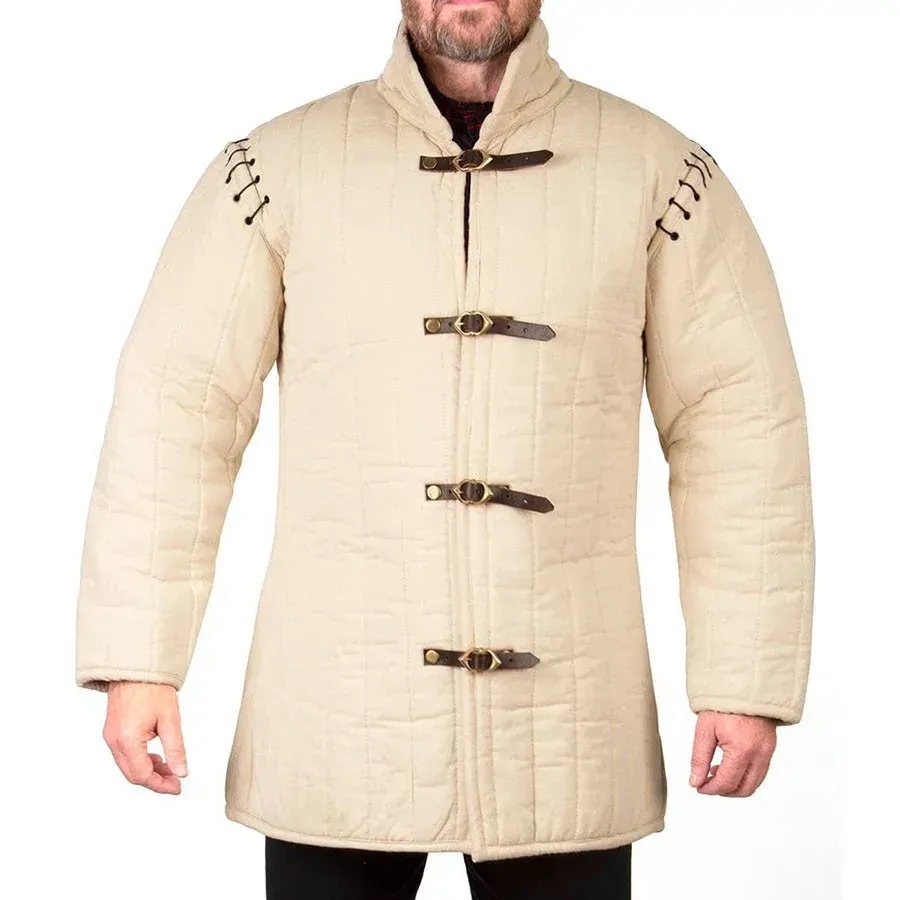
Brigandine: Flexibility and Style
The **brigandine** appeared later, in the mid-15th century, and was used until the 16th century. This armor combined functionality and aesthetics, being a key element in the military attire of the time.
- Design: It was made using fabric or leather as a base, with metal plates riveted inside. This design provided great flexibility and freedom of movement.
- Construction Elements: The smaller metal plates, strategically placed, allowed for superior mobility, being lighter than other heavy armors.
- Use and Acceptance: It was frequently worn over a gambeson and chainmail, making it popular among elite soldiers such as archers and knights.
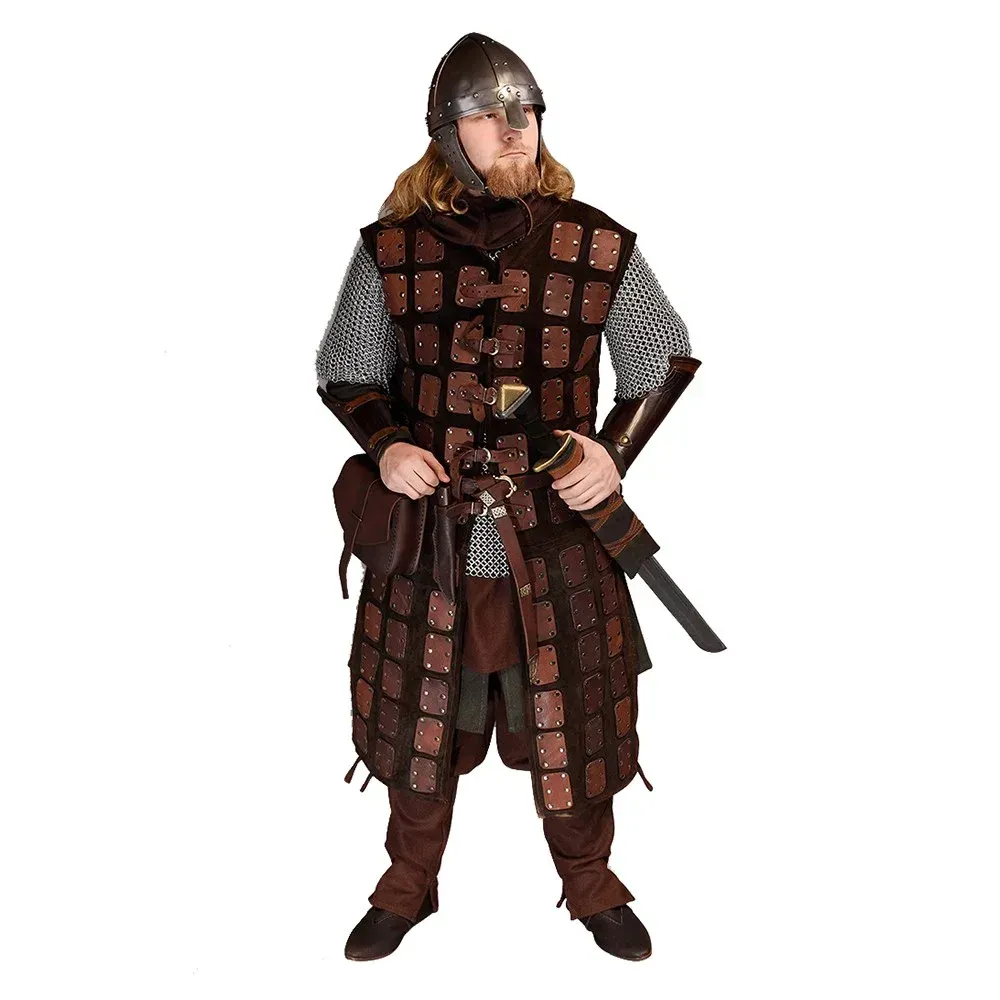
Comparison between Gambeson and Brigandine
Both armors played crucial roles, but they have differences in design, utility, and social preference.
| Characteristic | Gambeson | Brigandine |
|---|---|---|
| Structure | Padded with linen or cotton | Fabric or leather with metal plates |
| Flexibility | Low, due to padding | High, thanks to movable plates |
| Use | Under other armors or alone | Over gambeson and chainmail |
| Material | Linen, cotton, scraps/horsehair | Fabric, leather, metal plates |
| Period of Use | 10th century to 18th | 15th century to 16th |
| Popularity | Common soldiers | Nobles and elite |
The **gambeson** stood out for its accessibility and effectiveness as a base for other armors, while the **brigandine** offered better mobility and visual appeal, becoming a status symbol. The choice between these two pieces would have largely depended on social rank and specific military function, highlighting the ongoing evolution of medieval armor in response to the changing needs of the battlefield.
The greaves, known in the Middle Ages as "escarpines" or medieval "sabatons," represent one of the most interesting innovations in armor design of that time. Their main purpose was to protect the warriors' feet without compromising mobility. Below, we will explore in detail their composition, types, and evolution throughout medieval history.
Composition and Function of the Greaves
The greaves were essentially like "armored shoes," made up of articulated plates that covered the heavy footwear typically worn by the man-at-arms. Although they did not have their own soles, the greaves were worn over normal boots, providing an extra layer of protection that extended from the throat of the foot to the toes.
Articulated Plates
- The articulated plates allowed for flexible and natural movement of the foot. This articulation was crucial for freedom of movement, especially during combat.
Types of Greaves
There are several types of greaves, each adapted to different circumstances and needs:
- Extended Blade Greave: Used from the 14th to well into the 15th century, it consisted of 4 to 6 plates and ended in a sharp point, reflecting the styles of footwear of the time.
- Bear Paw Greave: Designed for foot combat, it featured a wide base for greater stability and was secured with a strap. It offered great mobility through its six plates.
- Duckbill Greave: Emerged in the 16th century, it was suitable for both horse riding and foot combat. With nine plates and a square toe, it adhered to the fashion of footwear of the moment.
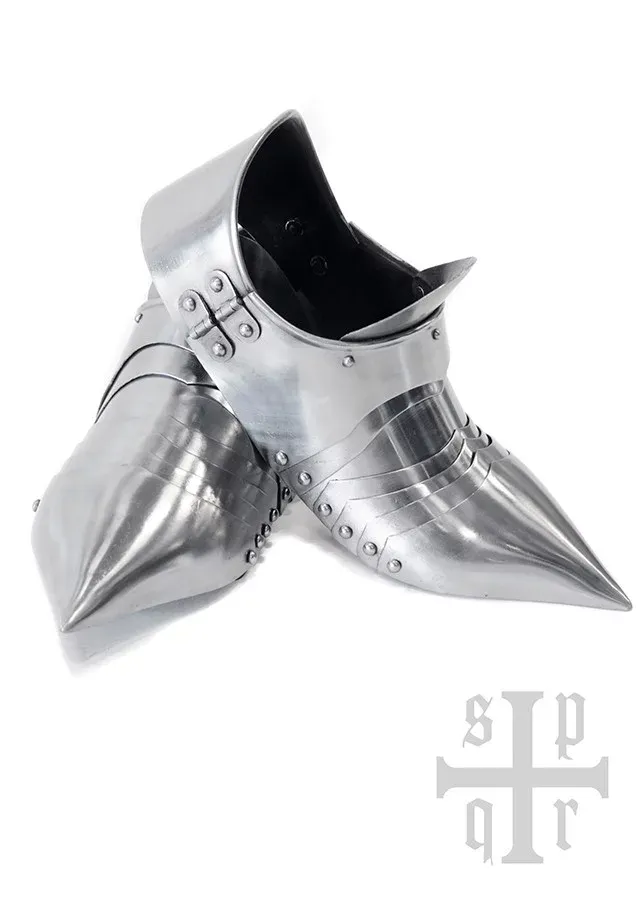
Evolution and Use of the Greaves
The greaves began to be used in the early Middle Ages, when chainmail was reinforced with additional plates to improve defense. Historical documents, such as the seals of Alfonso VIII of Castile, demonstrate their widespread use from then on.
Improvements in Protection
Over time, the materials and designs of the greaves evolved. With the introduction of materials such as galvanized steel, these items became not only more resistant but also more comfortable. Some models even integrated spurs, facilitating both riding and foot combat.
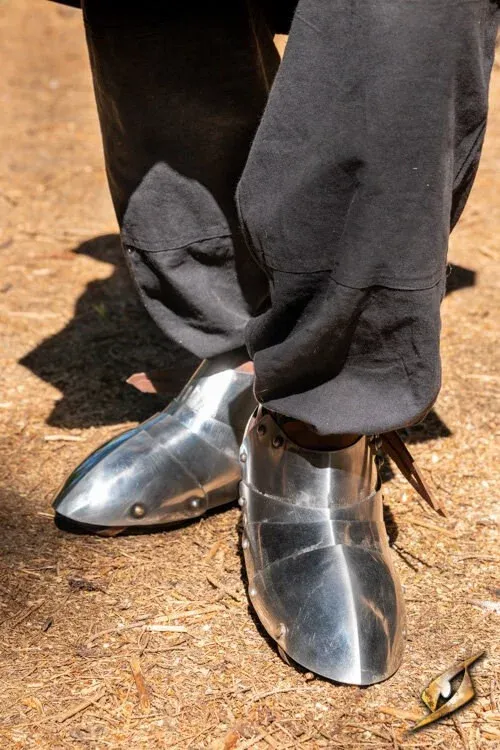
Complementary Uses
In addition to their defensive function, some greaves were designed with sharp points to inflict damage on enemy horses during combat, demonstrating their utility in both offensive and defensive scenarios.
Innovations and Design
The greaves exemplify the complex relationship between function and fashion in medieval armor. They not only represented essential defense but, with their elaborate designs and embellishments, reflected the hierarchy and social status of the wearer. This balance between functionality and style is a key characteristic of medieval weaponry.
| Type of Greave | Period | Characteristics | Main Use |
|---|---|---|---|
| Extended Blade Greave | 14th-15th Century | Sharp point, 4-6 plates | General |
| Bear Paw Greave | Middle Ages | Wide base, 6 plates | Foot Combat |
| Duckbill Greave | 16th Century | Square toe, 9 plates | Riding and Foot Combat |
These elements continued to evolve throughout the Middle Ages, showcasing the ingenuity and adaptability of armor designers who sought to balance maximum protection with the practical needs of medieval combat.
The balandre is a medieval garment that played a crucial role in the clothing of the humble classes during the 13th, 14th, and 15th centuries. This garment served as protection against inclement weather, being an indispensable item in the wardrobe of field workers.
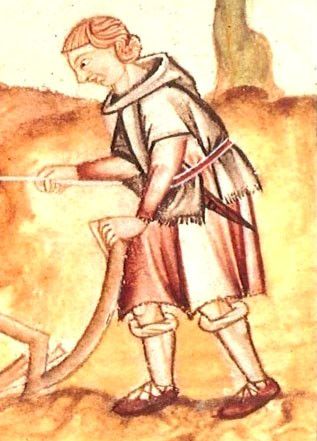
Description of the Balandre
The balandre is characterized by its simple yet functional design. It was a rectangular cloak with a hole in the center for the head. This design allowed users to easily put on the garment and keep their heads covered without obstructing their vision or breathing. Additionally, a hood was added to its structure to improve protection against cold and rain.
Categories of Balandres
- Balandre: If the sides of the cloak were sewn.
- Perpunte: If the sides were corded.
- Gonela: If there were no seams on the sides, allowing greater freedom of movement.
Usage and Historical Context
The balandre was especially popular among the lower classes, such as field workers. It was not common in the fashion of higher classes, such as nobility. The simplicity and utility of the garment made it very effective for being worn over other clothing, providing an additional layer of warmth and protection without interfering with daily tasks.
Functionality
The balandre had the advantage of being a loose-fitting and comfortable outer garment. Its design allowed for freedom of movement, something essential for those engaged in physical activities in the fields. It was an ally against cold and humidity, common characteristics of the climate in many European regions during that period.
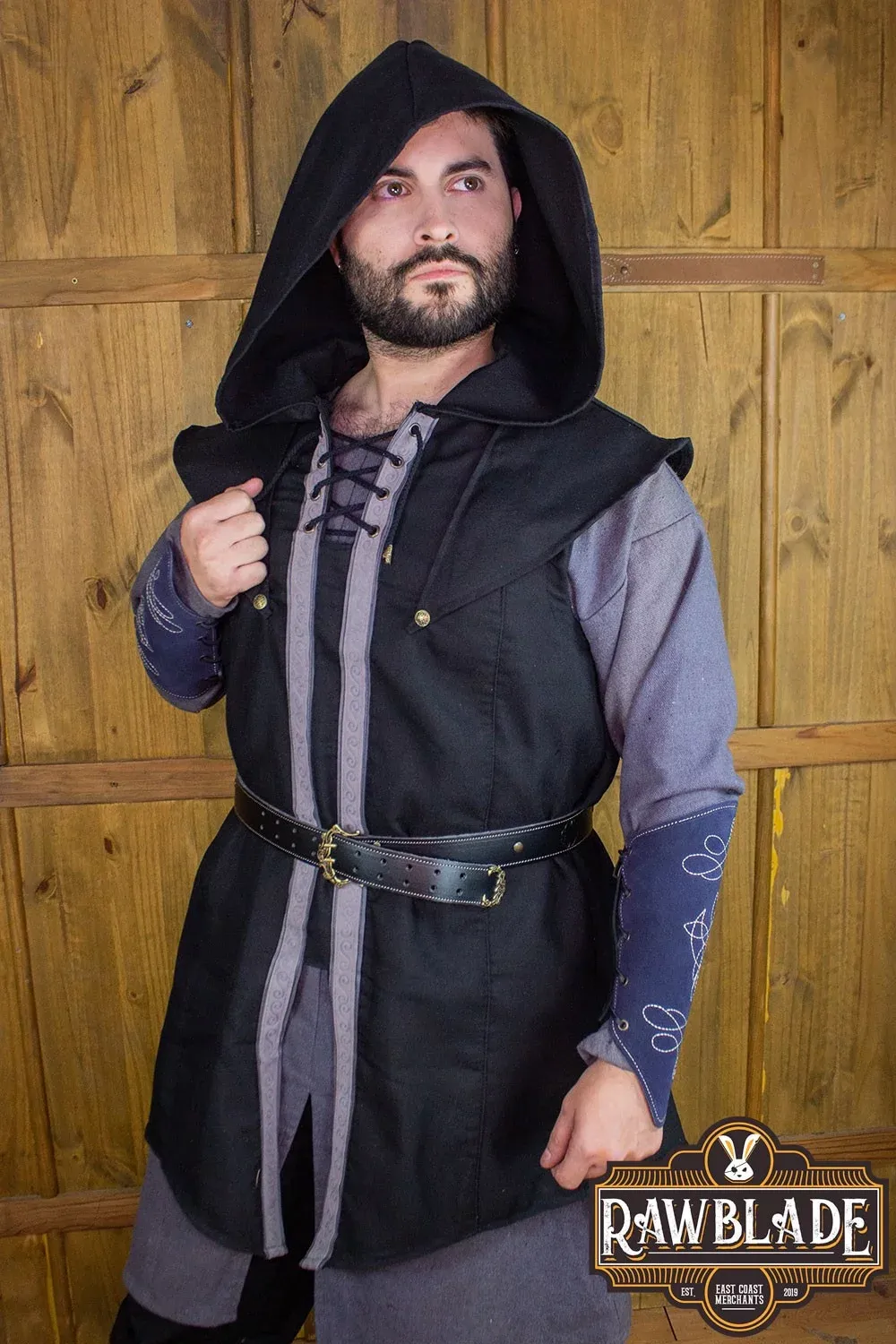
Evolution of the Balandre
Over the centuries, the balandre underwent variations in its design. Early versions may or may not have seams, but over time, some balandres began to incorporate seams for better support and durability. This change facilitated use and reduced the need to fasten the garment with cords.
Images and Representations
The balandre appears in various artistic representations, especially in the marginalia of medieval manuscripts. A notable example is the Luttrell Psalter from the 14th century, where field workers are depicted wearing this garment. These images not only reflect the practical use of the balandre but also offer us valuable insights into daily life in the Middle Ages.
Medieval Clothing
The balandre was part of the ensemble of medieval clothing for both men and women of humble condition. It was a versatile garment, suitable for different seasons of the year, notable for its ease of use and effectiveness in keeping warm and protecting against rain.
| Type of Balandre | Distinctive Features | Main Use |
|---|---|---|
| Balandre | Sewn sides | Weather protection, free movement |
| Perpunte | Corded sides | Flexible and adjustable |
| Gonela | No side seams | Greater freedom of movement |
The balandre, in all its variations, is an excellent example of how functional garments adapted to the specific needs of people could make a difference in daily life during the Middle Ages.
The redondel is a fascinating historical garment that reflects the elegance and sophistication of medieval Hispanic fashion. This circular cape not only provided warmth but also served as a symbol of status and nobility.
Features of the Redondel
- Circular Shape: One of the most distinctive features of the redondel is its circular shape, which sets it apart from other capes of the time. This structure allowed for a graceful and enveloping fit.
- Side Opening: An additional peculiarity is its side opening. Depending on the design, this opening could be located on the left, right, or even in the center. This feature facilitated arm mobility, allowing actions such as drawing a sword.
- Leather Neck: Often, the redondel included an elegant circular leather collar known as trascol. This design not only provided additional warmth but also added a touch of sophistication and distinction.
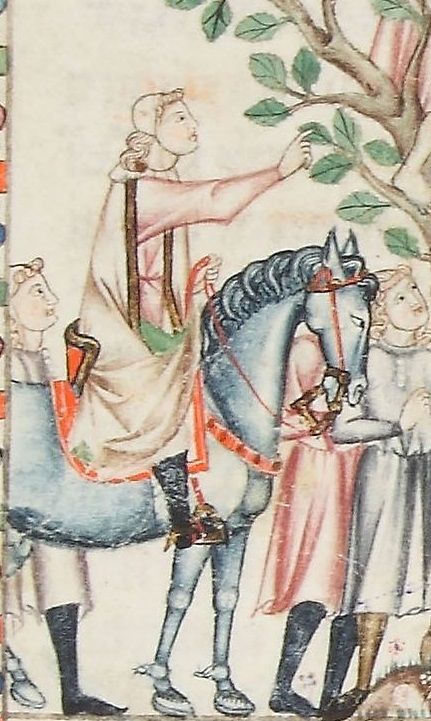
Origin and Use
- Hispanic Origin: The redondel has its roots in the Iberian Peninsula, used primarily from the 14th century to the early 16th century.
- Use Among the Nobility: This garment was reserved for those of high social standing, such as kings, nobles, and important court figures like doctors and musicians. Its use was not only a statement of style but also a symbol of social privilege.
Evolution Over Time
The design of the redondel maintained a certain stability from the mid-15th century to the early 16th century, despite changes in fashion trends of the time. This stability in its design suggests that it fulfilled a specific function that did not require significant modifications over the years.
Comparison with Other Garments of the Time
Although the redondel shares similarities with the traditional Hispano-Moorish cloak, its circular appearance and strategic side opening differentiate it from Renaissance capes, which tended to have a more straight and structured design.
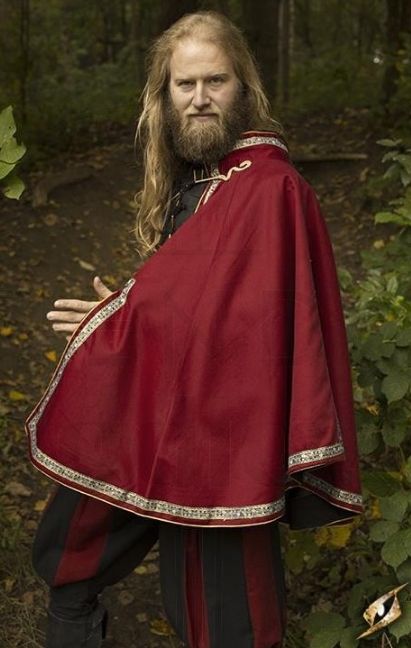
In comparison to Renaissance capes, the redondel offers superior mobility and a more functional approach without sacrificing appearance, which explains its popularity among the upper echelons of society.
Visual References of the Redondel and Related Fashion
To better understand the aesthetics and design of the redondel, various visual representations from the time can be considered, capturing its form and the materials used.
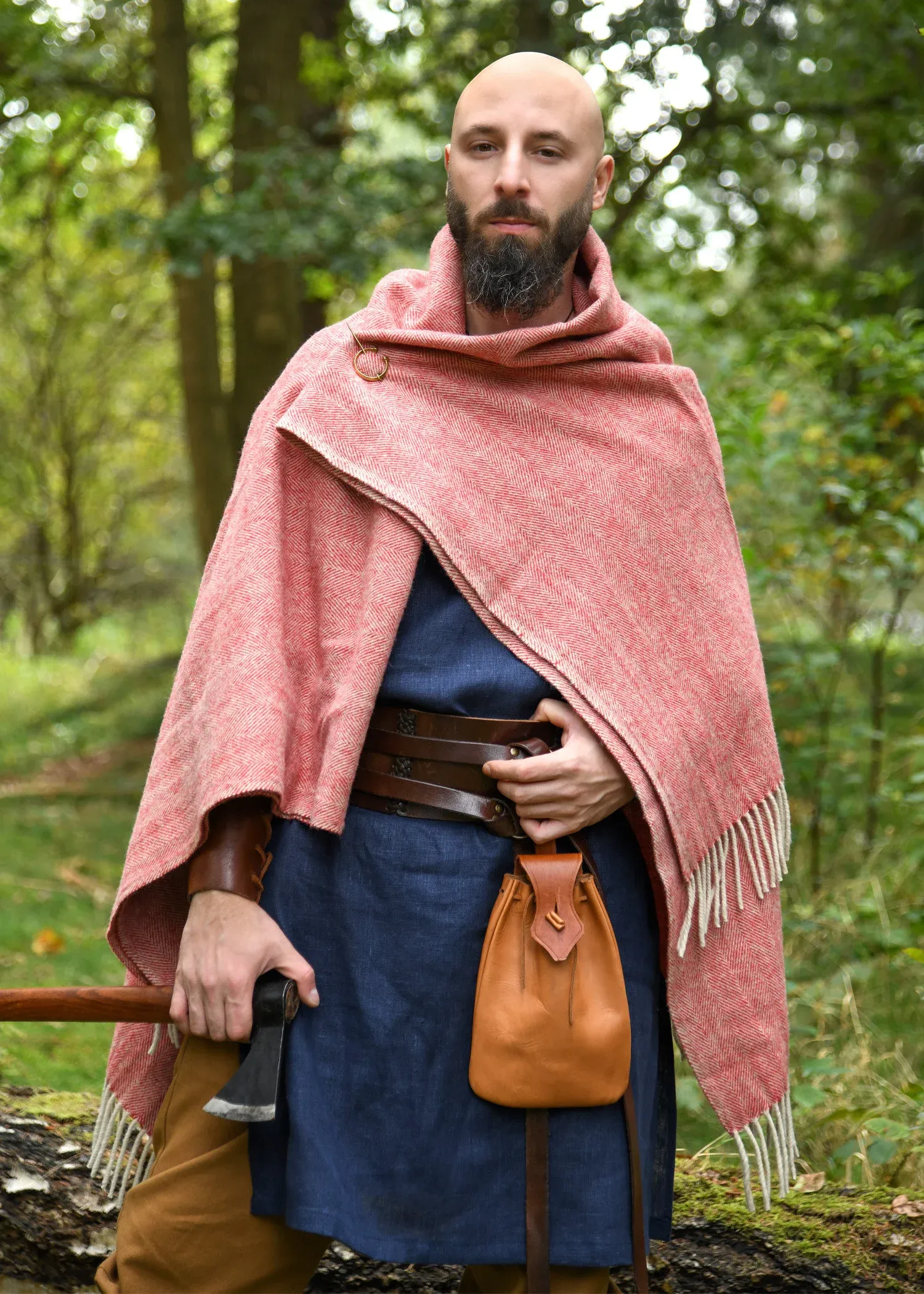
| Features | Description |
|---|---|
| Shape | Circular |
| Usability | Exclusive to the nobility |
| Additional Material | Leather collar (trascol) |
| Availability | Mainly in the Iberian Peninsula |
This analysis of the redondel demonstrates its value as an object of historical study, highlighting its unique design and its role in the fashion of the Middle Ages.
The aljuba, also known as aliuba, is a fascinating outer garment whose origins date back to Muslim cultures and gained popularity during the Middle Ages, particularly in the Iberian Peninsula. Over time, this clothing, initially conceived for military purposes, became a hallmark of the Christian nobility, symbolizing status and elegance.
Origin and Military Use
The aljuba emerged as a type of military cloak, designed to be worn over armor as an extra layer of protection. This garment was common in Muslim armies, providing solid defense to soldiers in combat.
Evolution in the 13th Century
As time progressed, the aljuba adapted to the changing needs of medieval society. In the 13th century, its design became more fitted, featuring a tailored waist, fitted sleeves to the neck, and a moderately-length skirt that ranged between the knees and mid-calf. This modification not only improved mobility but also provided exceptional comfort to those who wore it on a daily basis.
Characteristics and Ornamentation
Among the most striking features of the aljubas are their rich embroideries, typically located on the sleeves, neckline, and hem. This type of ornamental textile not only provided physical protection but also served as a clear indicator of the wearer's prestige and social standing. The inclusion of these embroideries and other embellishments was typical among members of the nobility.
Francisco de Osona, CC BY-SA 4.0, via Wikimedia Commons.
Complements and Accessories
The aljuba was often complemented with a classic mantle, which could be rectangular or semicircular, and was secured in place with a clasp or knot. Additionally, the garment was often cinched at the waist with a belt, adding an extra touch of elegance and sophistication.
The Aljuba in Medieval Culture
The aljuba transcends its practical function to become a culturally significant element of the medieval period. Its transition from a design of Muslim origin to a fashion adopted by Christian nobility illustrates the reciprocal cultural influence and interaction between civilizations during the Middle Ages. In this sense, the aljuba is a reflection of the luxury and sophistication of the era.
The term **Alquicel** has a profound legacy in the history of medieval fashion. It refers to a garment and fabric of Arabic origin that played a crucial role in clothing during the Middle Ages, particularly in the 13th century. This garment is significant not only for its functionality but also for its cultural and religious symbolism, which allowed its wearers to express their identity and social status.
Origin and Description of the Alquicel
The name "Alquicel" comes from the Arabic terms "kisa" or "qisí," referring to both the fabric and the garment. Originally, this fabric was made of white wool, although variations of linen and cotton were also found. This material was versatile and used in various ways in both the Muslim and Christian worlds.
Types of Alquicel
- Narrow Fabric: The Alquicel was manufactured as a narrow one-piece fabric, used for covering tables, benches, or other furniture. It also served as a blanket, enhancing its practical use within the home.
- Garment: As a garment, the Alquicel was a long tunic with wide sleeves, commonly worn at home. This clothing was especially popular among Muslim and Christian women, providing comfort and elegance.
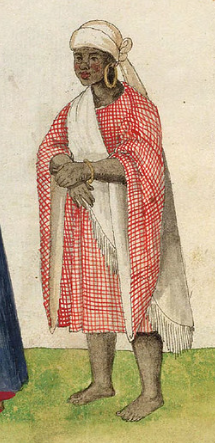
Photo of the Codex of Costumes: National Library of Spain via the Digital Hispanic Library
Use in Medieval Clothing
The Alquicel not only served practical functions but also held cultural and religious significance. Among its most notable uses, we find:
- Head Covering: Women often wore the Alquicel on their heads, a practice that not only had a decorative purpose but also indicated the social and religious status of the wearer.
- Body Wrap: This garment was also used to wrap the body, draping it over one shoulder and encircling the torso to pass it under the opposite arm. This method of dressing was characteristic of Moorish attire.
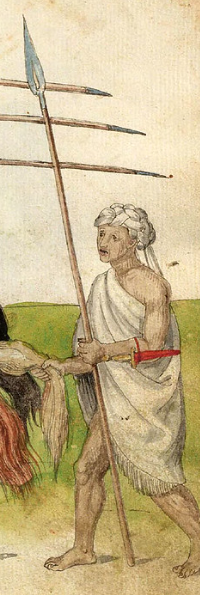
Photo of the Codex of Costumes: National Library of Spain via the Digital Hispanic Library
A Vestige of Traditional Fashion
The Alquicel is much more than just a simple garment or fabric; it embodies a rich cultural tradition that developed during the medieval period. Its use was common in both Muslim and Christian societies, reflecting the functionality of the fabric as well as its remarkable adaptation to the customs of its time. Its legacy endures in history, reminding us of the cultural interconnection and diversity that existed during this period.
| Aspect | Description |
|---|---|
| Materials | Wool, Linen, Cotton |
| Main Uses | Covering furniture, clothing as a tunic |
| Cultural Significance | Indicator of social and cultural status |
| Target Audience | Men and women from Muslim and Christian backgrounds |
The pedules or peales were a type of footwear commonly used during the Middle Ages. This footwear had the particularity of completely covering the foot and being secured with strings and ribbons, providing robust protection against inclement weather. The materials used in their making, such as coarse wool fabric or sheep leather, reflected the resources and technology available during the period from the 6th century to the 9th century.
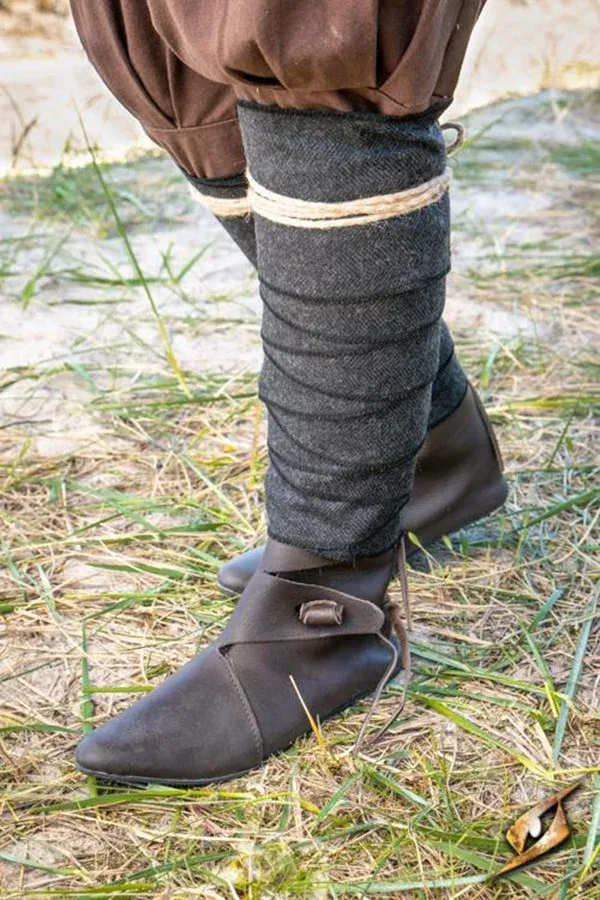
Characteristics and Use of the Pedules
- Materials: The pedules were primarily made from coarse wool fabric, a very rough woolen cloth, or sheep leather. This choice of materials not only reflected what was available but also the need to protect the feet from cold and other adverse elements.
- Fastening: Using strings and ribbons, the pedules were firmly secured around the foot, adapting to its shape and providing a snug fit.
- Evolution: With the progress of the Middle Ages, the pedules underwent certain modifications. During the 10th and 11th centuries, they began to be made from finer fabrics such as silk and were adorned with straps, strips of fabric or leather, which added strength and style.
Influence and Variations
- Muslim Influence: During the 10th century, some footwear models showed Muslim influences. They started to be made with cordovan leather and, at times, were painted, indicating notable cultural exchange between the civilizations of the time.
- The Word "Shoe": Although "shoe" did not become popular until the 12th century, the pedules still maintained their relevance. During this time, the "French shoe" was also documented, a variant that opened at the instep and was secured with a strap around the ankle.
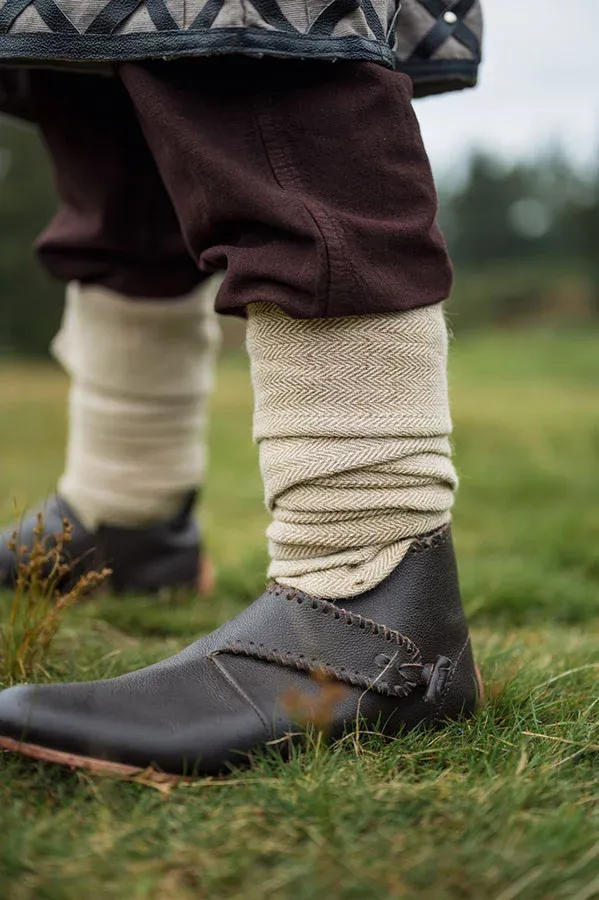
Comparison with Other Types of Footwear
- Alpeduques: Similar in names and functions, alpeduques were also used to protect the feet, although they were generally made of wool.
- Relation to Underwear: In medieval clothing, the pedules were on par with underwear such as shirts and breeches, which were essential for hygiene and protection against the weather.
The pedules or peales represent a crucial element in medieval attire, reflecting not only climatic needs but also cultural influences over the centuries. Their evolution highlights the richness of cultural exchange and the ability to adapt to new technologies and materials.
Footwear throughout history has played a fundamental role not only in fashion but also as a cultural and social symbol. Within this rich history, we find the zabata, a type of medieval footwear that stands out for its distinctive design and the materials used in its manufacture. Below, we will explore in detail the zabatas, analyzing their origins, characteristics, social use, and historical importance.
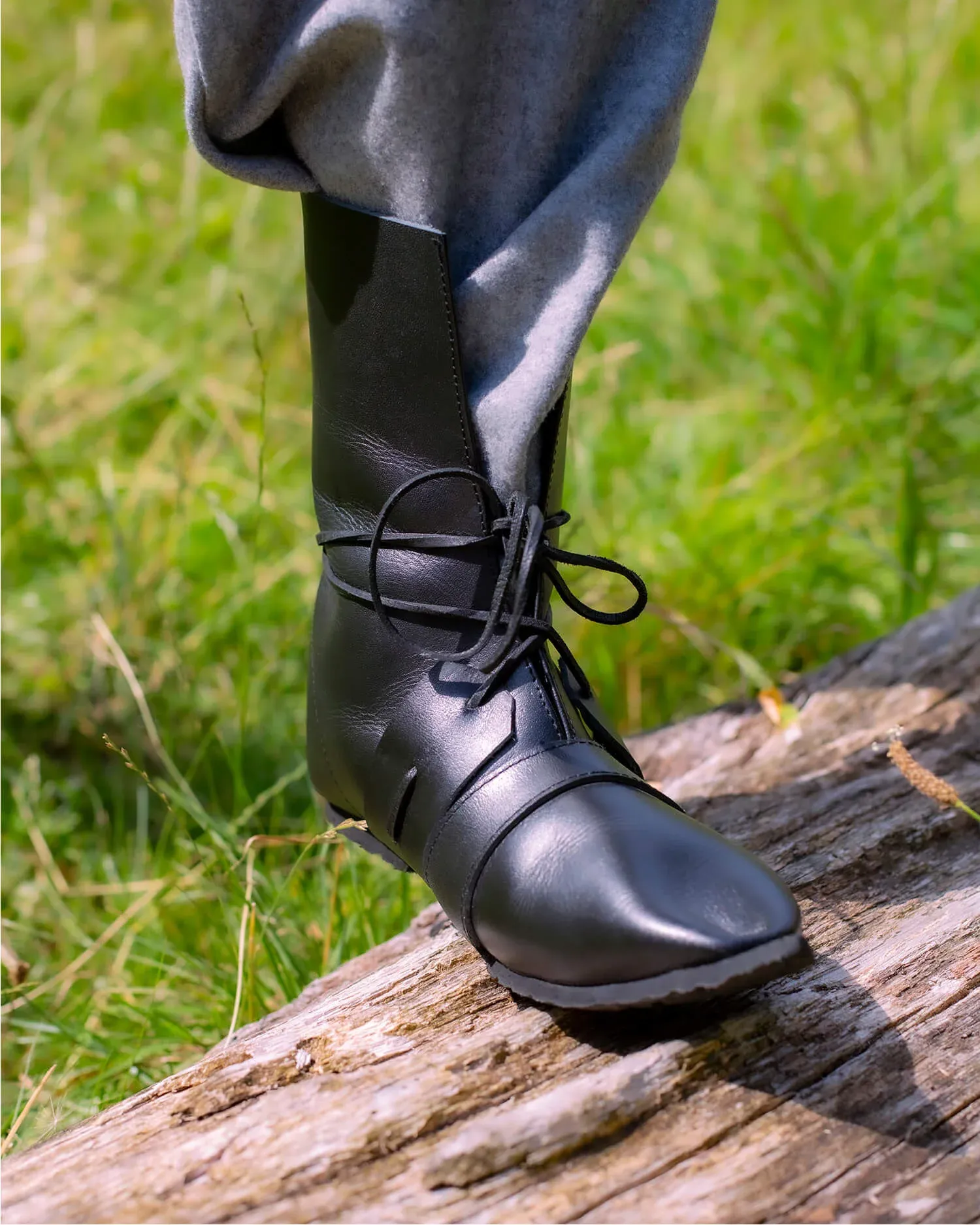
Origin and Etymology
The term zabata has its roots in the Turkish "zabata", which describes tanned or cured bovine leather, a key material in the making of this type of footwear. Documented for the first time in the 11th century, the use of the word spread until the early 16th century, especially in the context of women's shoes. This etymology offers us a glimpse into the techniques and materials used in the past for shoe manufacturing.
Characteristics
- Materials: Leather was the primary material, although it was occasionally lined with fabric such as silk, allowing for aesthetic and decorative variety.
- Design: They were commonly designed as fitted boots that enveloped the foot and ankle. There were also more elaborate versions with scooped or perforated designs.
- Construction: Strips, or pieces of fabric and leather, were used to reinforce the footwear. These were sewn between the sole and the upper and often ran along the instep or the sides.
Social Use
During the medieval period, footwear was a direct reflection of social class. Members of the nobility and upper classes often wore sophisticated leather footwear, usually covered with expensive fabrics such as silk, while the lower classes settled for simpler materials like wooden clogs. The zabatas not only served a functional purpose but were also indicators of social status.
While many designs offered an ornamental appearance, the primary concern was functionality, ensuring that the shoes were suitable for the daily demands of life at that time.
Historical Examples
- Documentation: In Castilian writings from 978, the term "zapatones aut abarcas" is already mentioned, and in the famous Cantar del Mío Cid (1140), "çapato" is used, showing the widespread use of the word in medieval texts.
- Iconography: Frescoes from the 6th century, such as those in Santa María de Tarrasa in Barcelona, depict shoes that possibly resembled zabatas, providing visual evidence of their design and use.
The zabatas are a key piece in the history of medieval footwear, representing not only the material resources and craftsmanship of the time but also the social and cultural context in which they existed. Their legacy in fashion and functionality is a testament to human ingenuity in adapting natural materials for everyday needs and aesthetic aspirations.
The capiello is a fascinating garment from the Middle Ages that, although it fell out of use, leaves behind a rich history both in fashion and in the military realm. During the 13th and 14th centuries, capiellos were a distinctive element among nobility, aristocrats, and monarchs, serving not only as a simple clothing accessory but also as a symbol of prestige. While it had an appearance that could remind one of a bonnet, the capiello was more than that; it was a declaration of power and social status.
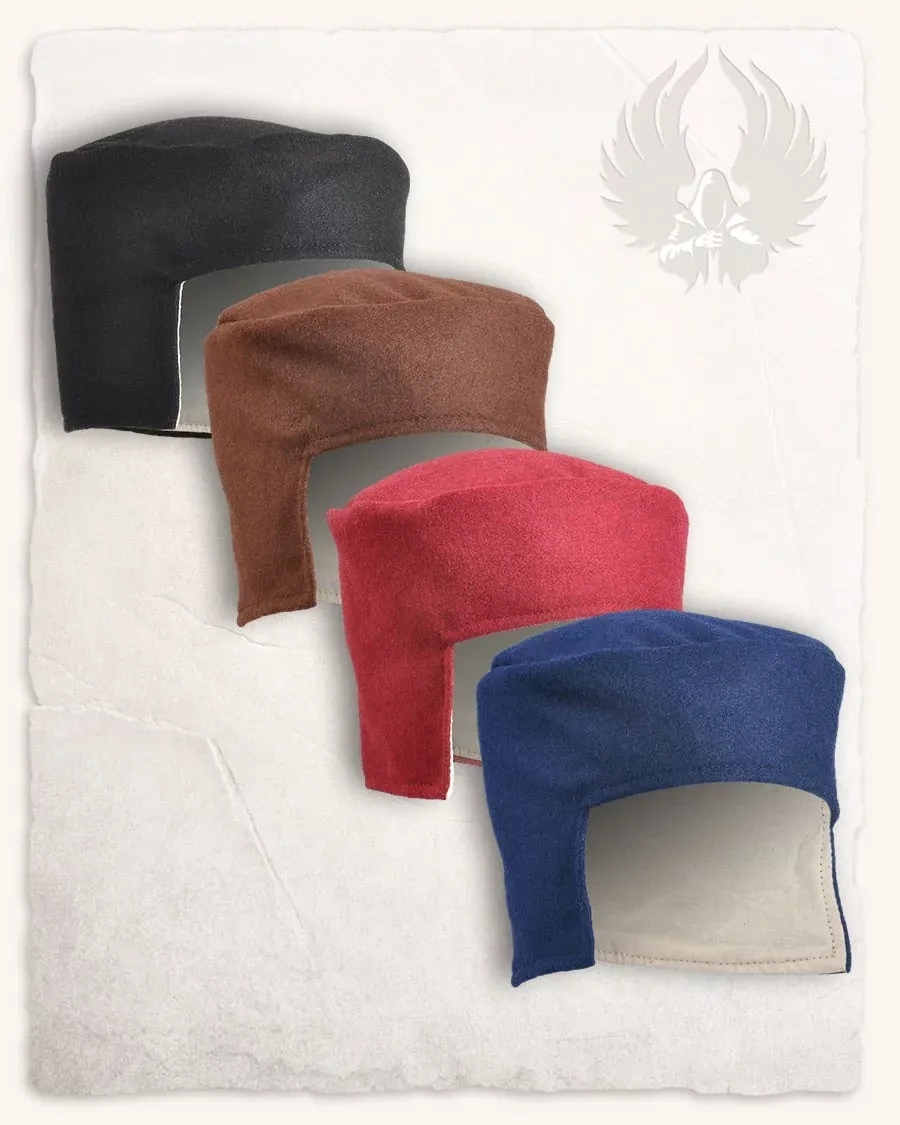
The Origin of the Capiello and Its Role in Armory
The creation of capiellos is closely linked to the military realm. This garment aimed to emulate armor helmets, as well as the cylindrical helmet, both used in combat. This connection to the art of war explains its popularity among the nobility, a class always associated with the defense of territories and conquest. Capiellos were an essential part of the daily life of commanders and masters of military orders, who used them beyond the battlefield, integrating them into their monastic lives.
Distinctive Characterization of the Capiello
The design of the capiello distinguished it from other head garments of its time through its cylindrical shape. This accessory not only covered the top of the skull but extended down to the nape of the neck, providing added protection. The lateral extensions at ear level offered effective defense when placed over the mail—part of the armor covering both the head and shoulders—and helped reduce uncomfortable friction.
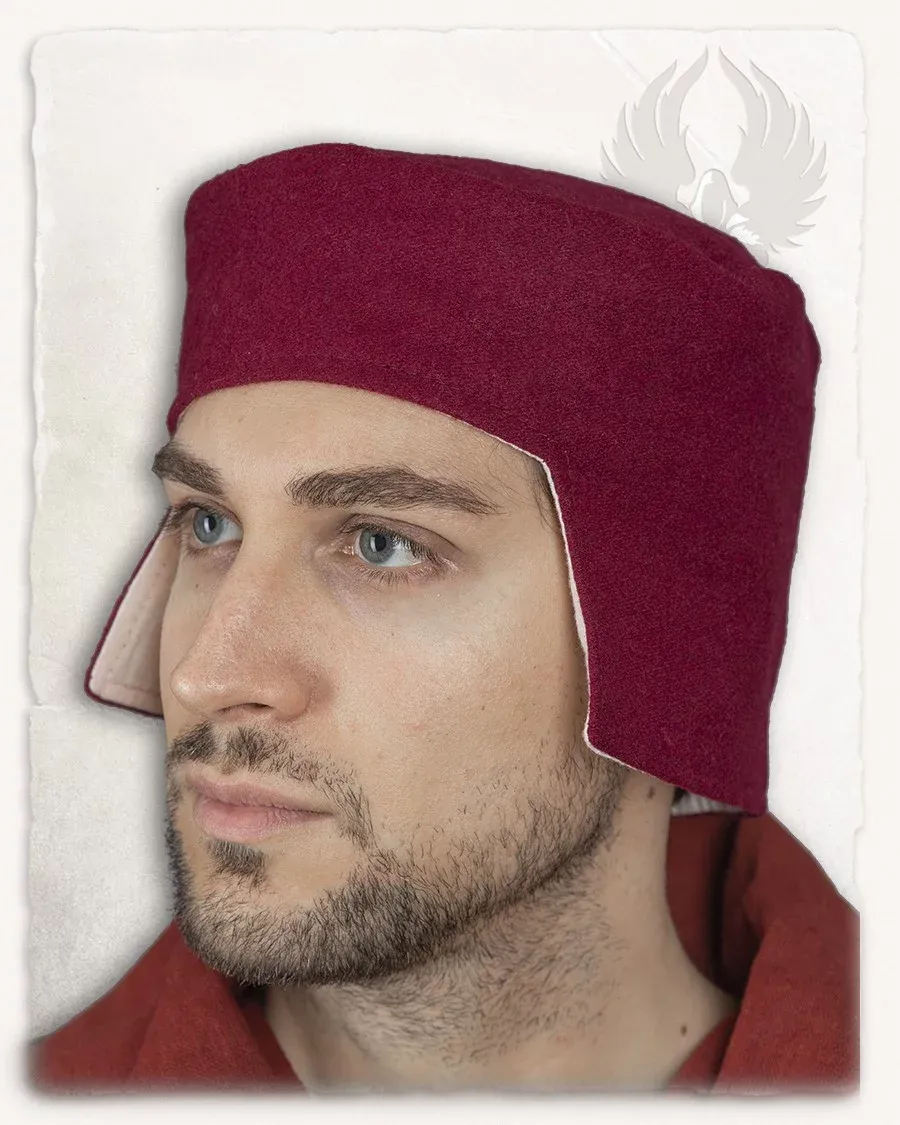
Evolution and Decline of the Capiello
As the 14th century progressed, the capiello lost its fashion, being replaced by other types of headgear such as bonnets, birettas, coifs, capirotes, or caps. These changes reflected both an evolution in aesthetic tastes and the development of new and more advanced armor styles suited to the times.
Historical Examples and Their Legacy
A historically significant capiello is that of Alfonso X the Wise, which is still preserved in the Cathedral of Saint Mary of the See in Seville. This relic provides a glimpse into the cultural and military sophistication that characterized this period. Furthermore, in the "Cantigas de Santa María," one can observe illustrations showcasing the artistic richness that a royal capiello could possess, adorned with brocades and embroideries.
Historical Context of the Capiello
The capiello was not only popular among the nobility; it was also a recognized piece among common knights. The "Chronicle of the Population of Ávila" speaks of these men, their armors and headgear, adding context on how such garments became symbols of authority. Knights wore the capiello as part of their gear, which set them apart from ordinary combatants, providing prestige and recognition.
| Century | Popular Headgear |
|---|---|
| 13th | Capiello, Bonnet |
| 14th | Biretta, Coif, Capirote |
The capiello, with its military origins and its presence in the daily life of medieval nobility, was much more than a simple head covering. It was a symbol of power, fashion, and practical function, an iconic representation of its time. Although its popularity declined, the capiello remains a testament to the influence that military fashion has had throughout history.
The bonete is a classic piece of medieval headwear characterized by its perfect fit to the shape of the head, used by both men and women. With a rich cultural history, the bonete was not only a functional garment but also a symbol of social status, art, and personal distinction. This article provides a detailed overview of the bonete, including its origin, characteristics, materials, and evolution over the centuries.
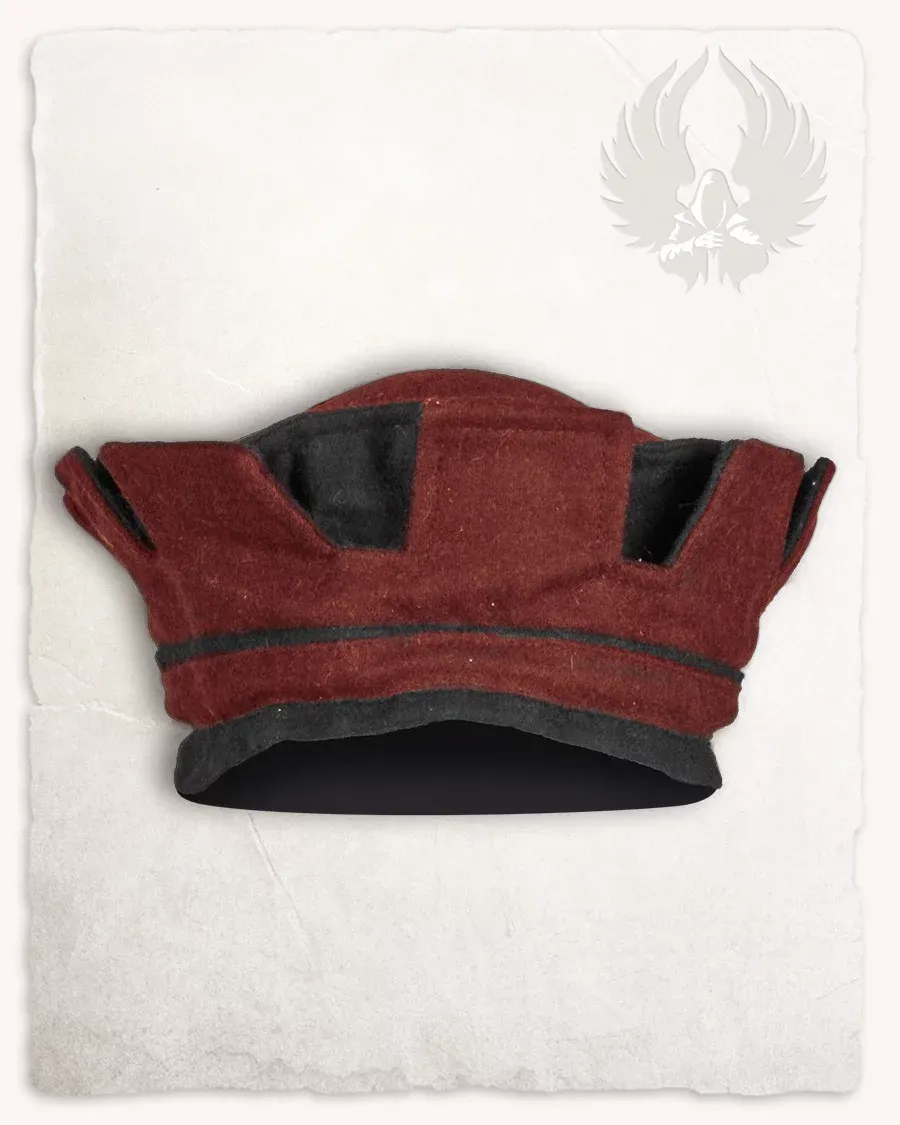
Origin and Etymology
The term "bonete" comes from the Catalan "bonet," which in turn is a diminutive of the Latin "abonnis." Originally, it was used to describe a cap or headpiece that conformed to the shape of the head. This versatile garment dates back to medieval times when it became popular among various social strata.
Characteristics and Materials
The versatility of the bonete lay in its construction, which varied greatly depending on social status and available resources. Some of the most common materials used in making bonetes included:
- Wool - primarily used by peasants and the lower classes.
- Felt and Leather - optional for the middle classes and more durable bonetes.
- Precious metals, velvet, and silk - incorporated into luxury bonetes.
Bonetes could be simple or richly decorated, depending on their purpose and the recipient they were intended for.
Types of Bonetes
Over time, the bonete adopted various styles. Some of the most common types during the Middle Ages were:
- Simple Bonetes: Without flaps or embellishments, worn throughout the 15th century.
- Folded Bonetes: Characterized by having double fabric or a flap that borders the base.
- Bonetes with Rounded Crown: Very popular during the third and fourth decades of the 15th century, featuring a gathered crown.
- Bonetes with High Flap: Included a rounded crown combined with a high flap.

Social Use and Status
The bonete played an important role in social differentiation. While nobles and well-off individuals opted for majestic and decorative bonetes, peasants preferred more accessible and functional caps. Moreover, the bonete was more than a garment; it served as a means of social communication, reflecting the user's position or aspirations.
Evolution of the Bonete
The bonete evolved significantly throughout the 15th century, adapting to successive changes in fashion and social context. In the second half of the century, it became common among women, sparking debates among the moralists of the time. However, starting in the 16th century, this item was largely relegated to ecclesiastical officials and academics, before being replaced by caps in most secular contexts.
Historical Context
Throughout medieval history, the bonete was an essential element of attire due to its functionality and symbolism. Bonetes, laboriously crafted by bonete makers—a specialized guild—demonstrated the skill and dedication of these artisans through the use of precious materials and elaborate designs.
In essence, the bonete embodies not only a past fashion but also a reflection of cultural norms, social status, and textile skills of the medieval era. Its impact on bygone fashion remains a fascinating topic for exploration by historians and design enthusiasts.
The mortarboard is a distinctive and significant element in the academic and ceremonial realm, widely recognized as a symbol of educational achievement and professional distinction. Worn by graduates, magistrates, and judges, the mortarboard reflects a historic tradition that dates back to ancient times. This article will delve into the characteristics, history, and cultural relevance of the mortarboard across various cultures and ceremonies.
Characteristics of the Mortarboard
- Structure: The mortarboard consists of a square horizontal panel attached to a hat, adorned with a tassel in the center, a design that persists in most academic mortarboards.
- Color: Although traditionally black, there are also versions in ivory, blue, and white, adapting to the representative colors of different institutions.
- Shape: Its distinctive prismatic shape makes it easily identifiable at ceremonial events.
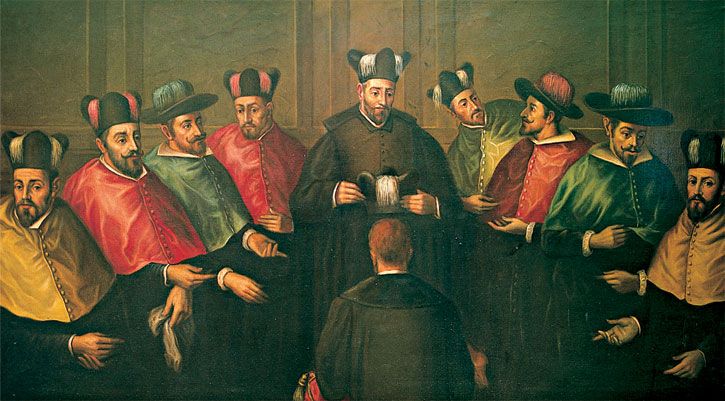
Anonymous, Unknown author, Public domain, via Wikimedia Commons
Use in the University Community
- Graduates: In graduation ceremonies, the mortarboard is an essential part of the academic attire, symbolizing the culmination of an educational cycle.
- Academic Degrees: Mortarboards can be differentiated by color and design according to the academic degree and field of study. For example, doctors may wear mortarboards embellished with silk tassels that represent their discipline.
- Meaning: Beyond being a simple accessory, the mortarboard is an emblem of knowledge and academic dedication. In some traditions, it is used in coats of arms to denote the doctor's degree of the family.
Presence in Ceremonial Events
- Use by Magistrates and Judges: In addition to its academic relevance, the mortarboard is worn by judicial authorities at formal events, adding solemnity to their attire.
- Historical Tradition: Its origin dates back to Roman times with the *pileus quadratus*, evolving over the centuries into the modern mortarboard used by various ecclesiastical and academic communities.
Notable Examples of Mortarboard Use
- University of León: Known for its laureated mortarboard, which represents the symbol of a doctorate. It is common to see black mortarboards with tassels in the color corresponding to each discipline.
- National Autonomous University of Mexico (UNAM): Follows the Spanish tradition in its mortarboard but incorporates specific variations in the tassels and their arrangement.
Importance of the Mortarboard in Academic Culture
- Academic Identity: The mortarboard is integral to academic identity and is subject to institutional regulations to maintain its uniform character in official ceremonies.
- Customization: Although its essence is uniform, mortarboards can vary in design and color according to personal preferences, reflecting individuality within conformity.
The tradition of the mortarboard as part of ceremonial attire has endured throughout history, from its beginnings in ancient Rome to its current adoption in educational and judicial institutions. Its evolution and adaptation demonstrate the importance of these symbols in the perpetuation of traditions and the representation of academic and professional achievements.
The **lucet** or **luceta** is an ancient tool of medieval origin, mainly used for weaving cords and braids. Over the centuries, its use has been linked to various cultures, especially during the Viking and medieval periods. Although the use of the lucet declined around the 12th century, this artisanal braiding technique resurfaced in the 16th century and continued to be employed until the 19th century.
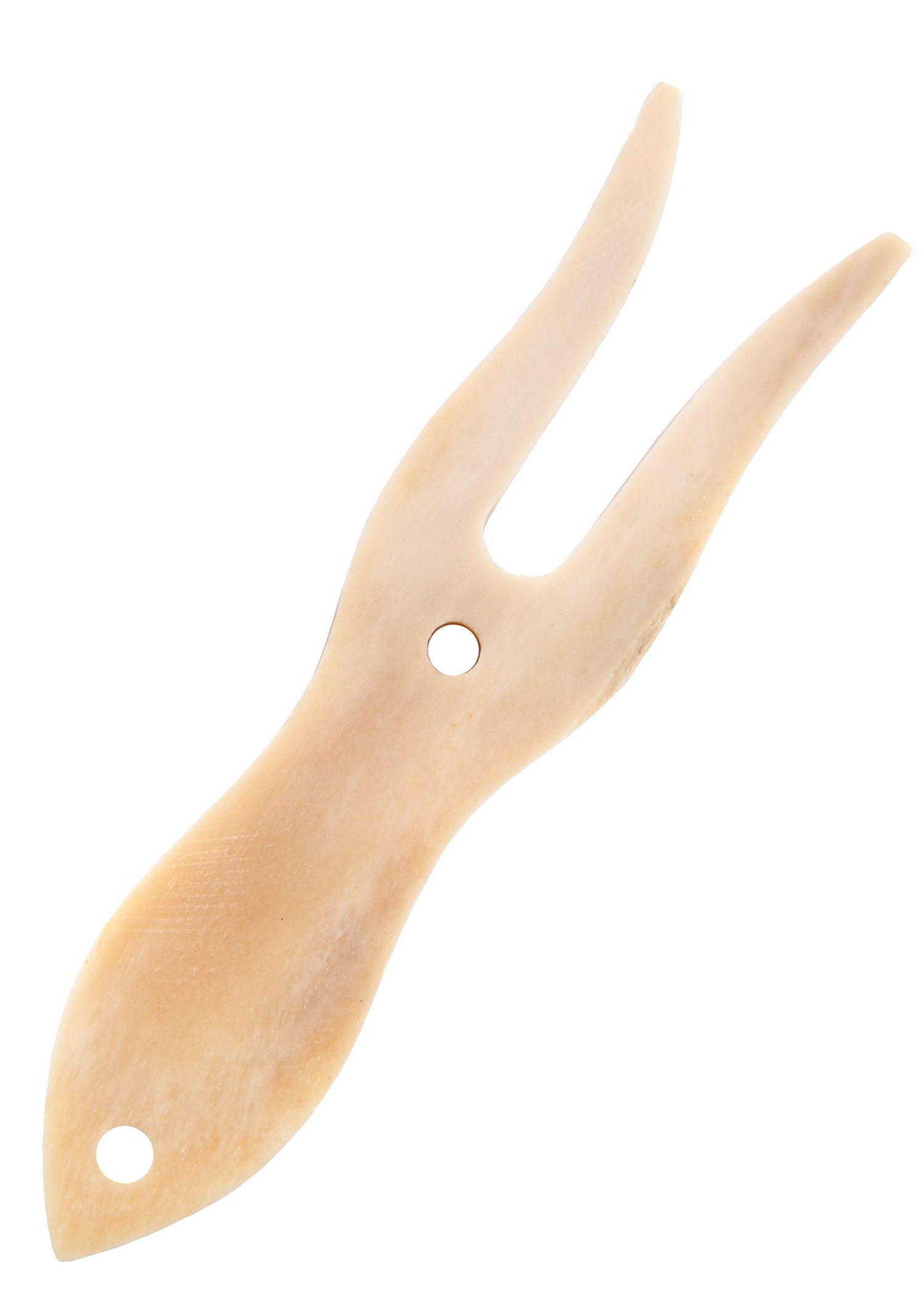
Origins and Historical Use
The **lucet** dates back to ancient times, where it was primarily used to create strong and decorative cords that could be used in clothing as fastening or elastic elements. During the Middle Ages, the Vikings employed these cords for various practical uses, including hanging objects from their belts. Archaeological findings at Viking sites, along with literary references, confirm the widespread use of this tool.
Description and Construction
The design of the **lucet** is simple and functional. Typically, it has a shape reminiscent of a horn and is made from durable materials such as wood, bone, or, in more recent times, ivory and mother-of-pearl. It has two prongs or horns that are fundamental to the weaving process. In the Victorian era, lucets were made from more exotic materials, highlighting attention to detail and aesthetics.
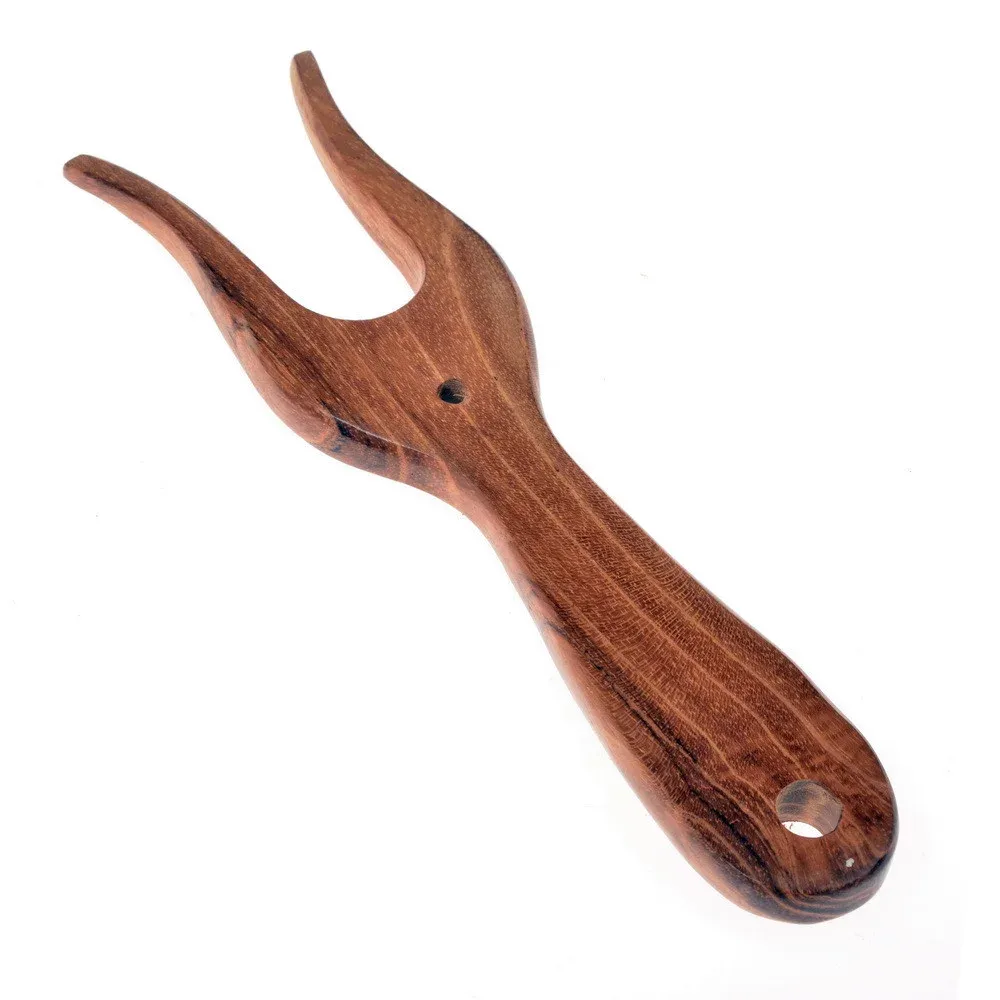
Weaving Technique
The process of making a cord with a **lucet** is quite simple but requires manual skill. It starts by threading the yarn through the central hole of the tool and then wrapping it around the prongs to form a figure-eight. The resulting knots are raised using fingers or a small additional tool, and tension is applied by pulling the yarn behind the luceta. This repetitive pattern allows for the creation of cords of any length, characterized by being square, strong, and moderately elastic.
Uses and Applications
Cords made with a **lucet** were used in a wide variety of contexts. Typically made from materials like wool, linen, silk, and other vegetable fibers, they became functional and aesthetic elements in belts, straps, and textile decorations. Their robust nature and the ability not to unravel after being cut, increased their popularity as a reliable technique in the past.
Archaeological Finds
Despite its simple design, which complicates its identification in archaeological contexts, objects associated with the use of the **lucet** have been found. A notable example is a tubular bone artifact from the 11th century found in Lund, Sweden, which features a runic inscription. These discoveries underscore the historical relevance of the luceta and its widespread use across different cultures.
| Material | Era | Use |
|---|---|---|
| Wood, bone | Viking and medieval era | Cords for clothing and practical uses |
| Ivory, mother-of-pearl | Victorian era | Decorative and practical cords |
The **luceta** remains a fascinating tool that, despite its simplicity, retains a special charm for those interested in traditional weaving techniques, as well as for historical framing and medieval reenactment. Its legacy endures and offers a window into the artisanal techniques of the past.
The **sporran** is a key element of traditional Scottish attire, particularly relevant in the Highlands. This piece, whose name derives from Scottish Gaelic and means "purse" or "bag," resembles a fanny pack or pouch. It is characterized by its location: it is worn over the *kilt*, the traditional Scottish skirt, which has no pockets, making the sporran an essential component of the outfit.
Origin and History of the Sporran
The sporran has its roots in the Middle Ages when men in Europe wore bags hanging from their belts before pockets became popular in clothing. In Scotland, this item had a particularly significant longevity because the *kilts*, unlike other European garments, did not include pockets. Thus, the sporran remained a practical and distinctive item in the attire of the Scottish Highlands.
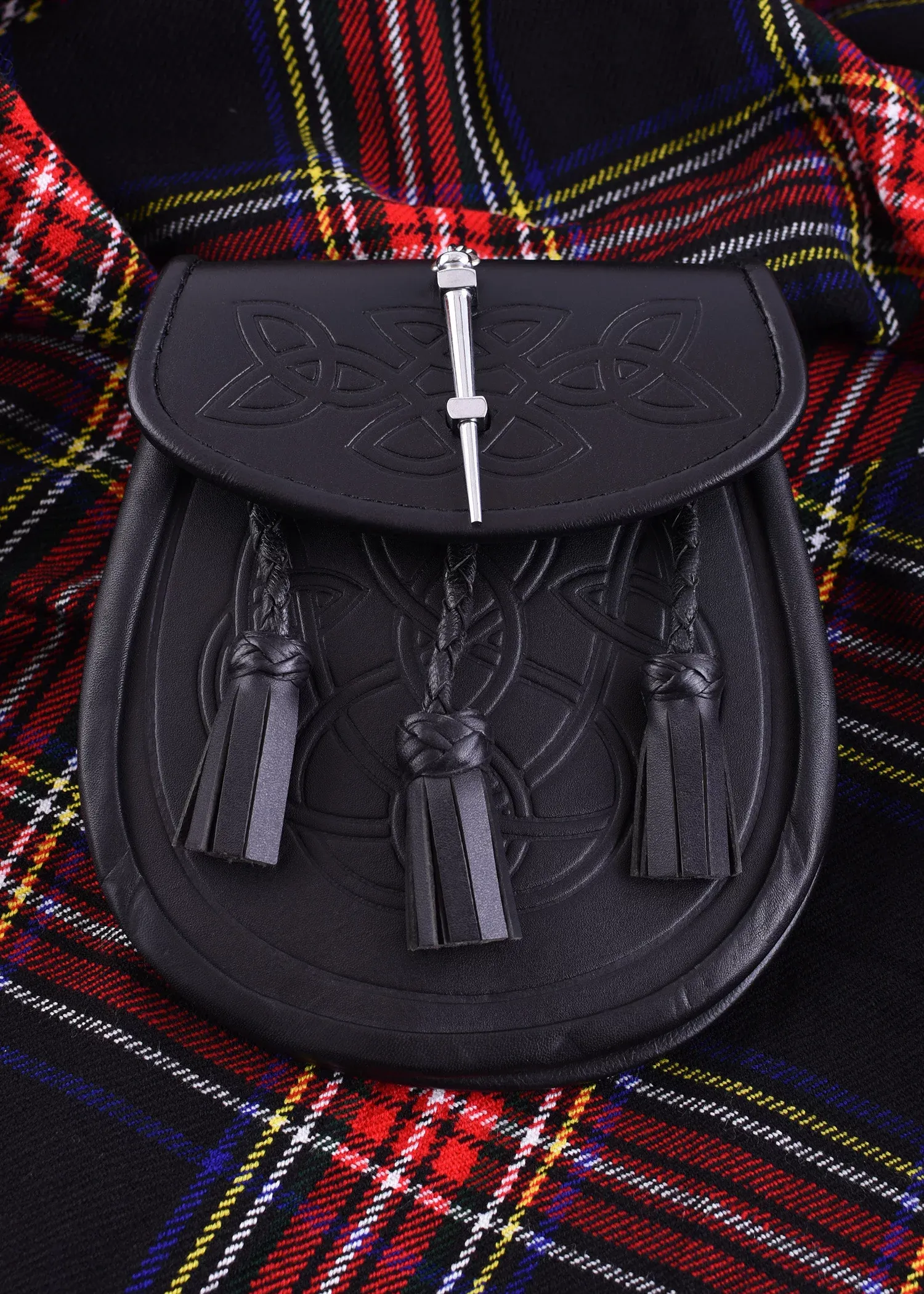
Design and Materials of the Sporran
Traditionally, sporrans are made from leather or animal skin. However, depending on the event and the formality of the attire, designs can vary in their level of ornamentation. Contemporary sporrans come in simpler formats for everyday use, made of leather, and in ceremonial versions, which often feature embellishments such as silver details, tassels, metal trims, and Scottish heraldic or floral motifs.
How to Wear the Sporran
The sporran is hung in front of the body, usually covering the groin area, thanks to an adjustable chain or strap. It is positioned just below the buckle of the kilt's belt. An important element is the stylistic coordination, as the design of the sporran is typically chosen to match the rest of the outfit, considering the belt buckle and ceremonial weapons like the *sgian dubh*, a Scottish dagger.
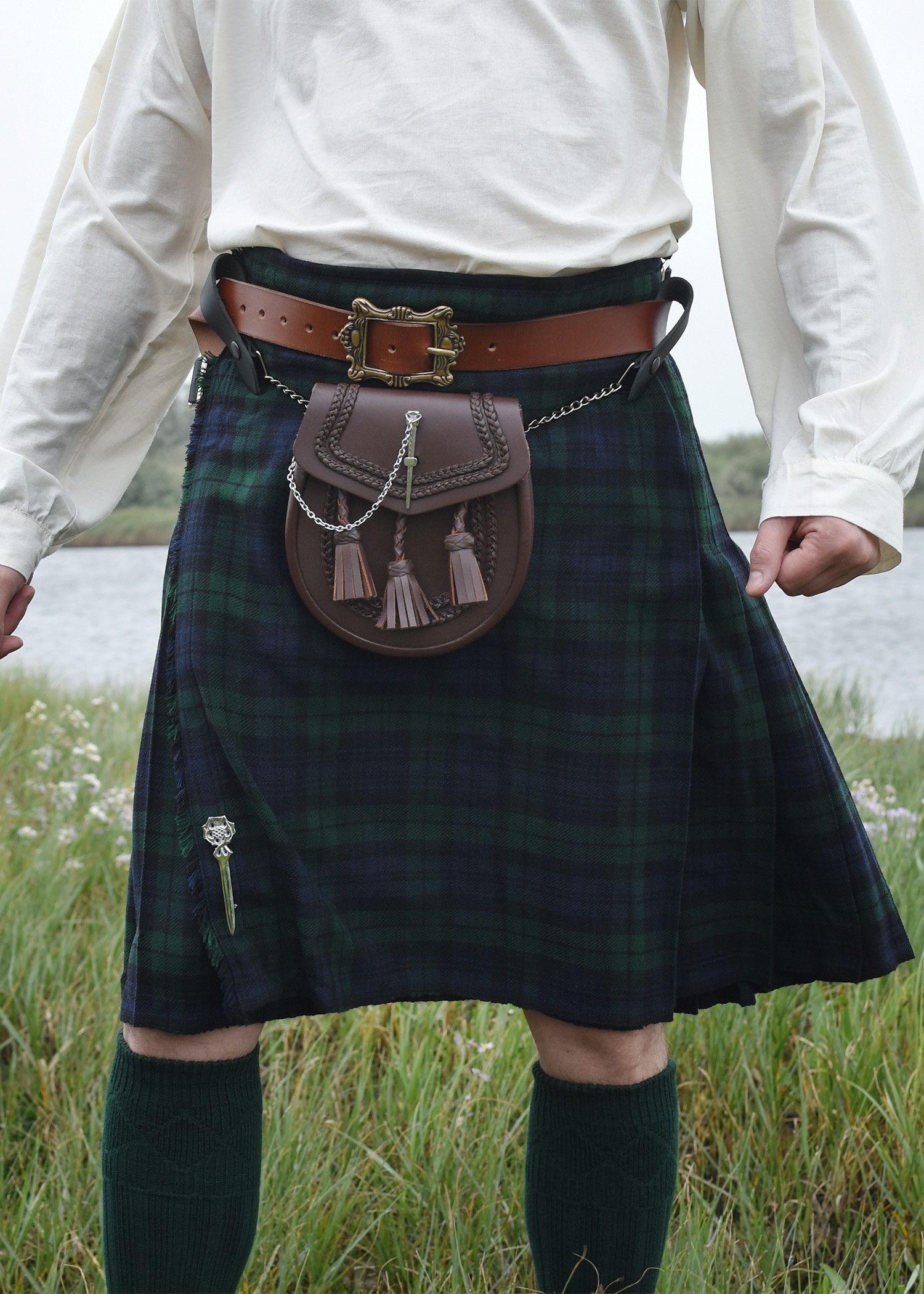
Function and Current Use
The sporran is the only "pocket" that accompanies the kilt, used to hold personal items such as money, keys, and even modern devices like mobile phones. It is not only a functional accessory but also an aesthetic one, enhancing the visual appeal of Scottish attire, especially at events such as weddings, festivals, and other cultural celebrations where it also serves an ornamental purpose.
Types of Sporran
- Everyday Use: Designed for daily wear, these sporrans are simpler and are typically made of leather.
- Semi-formal: Combining leather with simple ornaments, suitable for less strict occasions.
- Formal or Gala: Crafted from skin and metallic decorations, these designs are more ceremonial, often incorporating tassels, heraldry, or intricate details.
The sporran is more than just an accessory; it stands as a cultural and identity symbol of Scotland. Its design is a testament to how traditions endure, adapting to modern times while preserving a rich cultural legacy that enhances every Scottish outfit.
The leather is a historical garment that has fascinated historians and enthusiasts of ancient fashion due to its rich history and functionality. Throughout the centuries, this garment has been much more than just a piece of clothing; it has served as a symbol of status, protection, and craftsmanship. Let us discover together the fascinating world of leather, from its origin to its varied uses and its manufacturing process.
Origin and Meaning of Leather
Leather is, in essence, a type of skin jacket worn over the doublet, a fitted garment that covered from the shoulders to the waist.
Traditionally made from leather or tanned hide, leather was fundamental in eras such as the medieval and Renaissance periods. The main material, leather, played a crucial role in daily life at the time. From footwear to garments, leather was used in a wide variety of items, and the creation of leather garments employed techniques developed by artisans such as tanners and curriers in establishments known as tanneries.
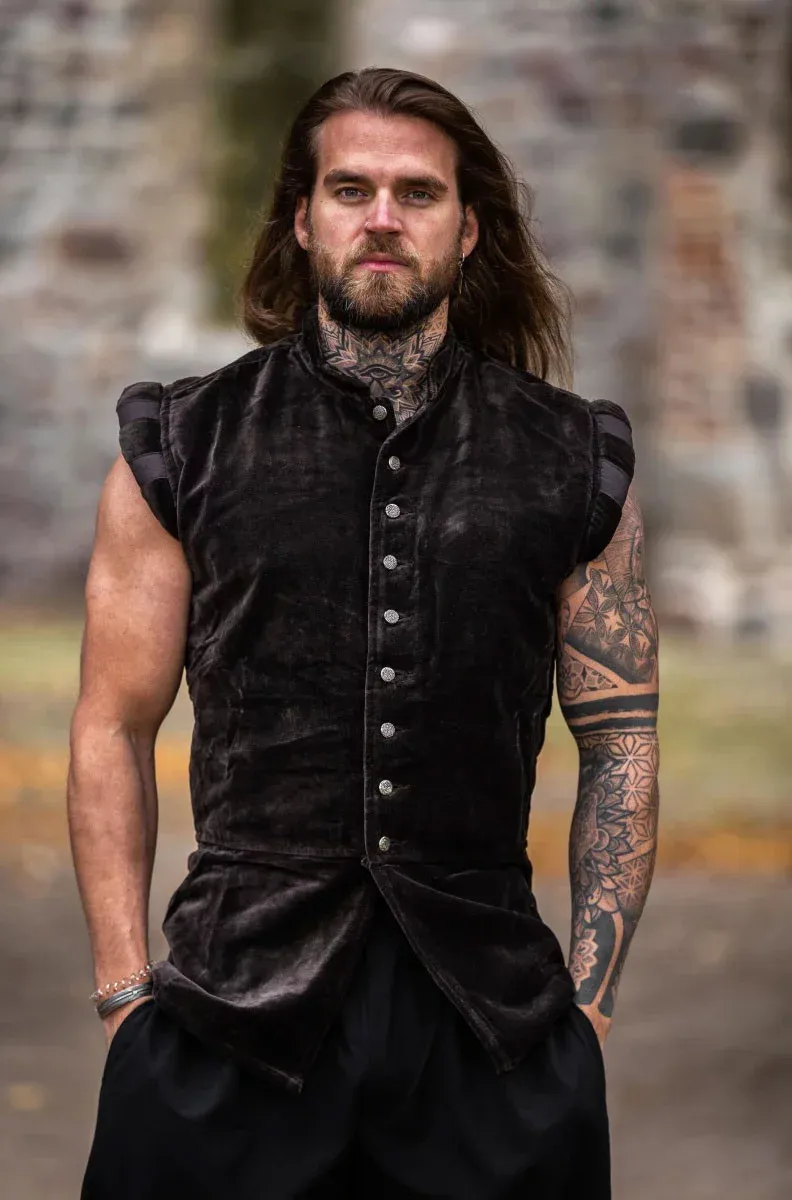
Functionality and Variants of Leather
Leather as Civil Garment
In the civil sphere, leather not only provided warmth but also indicated the social status of its wearer. The quality of the material, along with the craftsmanship and decorative details, reflected the economic and social position. Higher-quality and more decorative leathers were used by the upper echelons of society.
Leather as a Defensive Element
Leather also played an essential role as a protective element in warfare contexts. This type of leather often had multiple layers, sometimes up to seven, which gave it resistance and a certain level of protection compared to metal armor. Although these leathers could weigh more than ten kilograms, they offered several advantages, such as lower cost, ease of production, and, in some cases, greater flexibility of movement. It was common for soldiers to wear this leather over their uniforms during combat and battles.
Manufacturing Process of Leather
The manufacturing process of a leather garment was complex and meticulous. It began with the tanning of hides, a specialized craft that transformed raw hides into malleable leather for garment making. The fundamental stages of this process are as follows:
- Cleaning and preparation of the hides for treatment.
- Soaking in various substances intended for tanning.
- Treatment with elements such as bark, sumac, or gall to give special characteristics to the leather.
- Drying and final conditioning of the leather for use.
These artisanal procedures were passed down from generation to generation and were carefully regulated by the guilds of the time.
Social Relevance of Leather in the Middle Ages
Like many other garments of the time, leather was regulated by specific dress codes that dictated what materials, cuts, and decorations were appropriate for different social strata. These regulations helped maintain social order and prevented lower classes from simulating a higher status through their clothing. The quality of the leather and decorative details marked notable differences between the leather of a noble and those of a peasant or artisan.
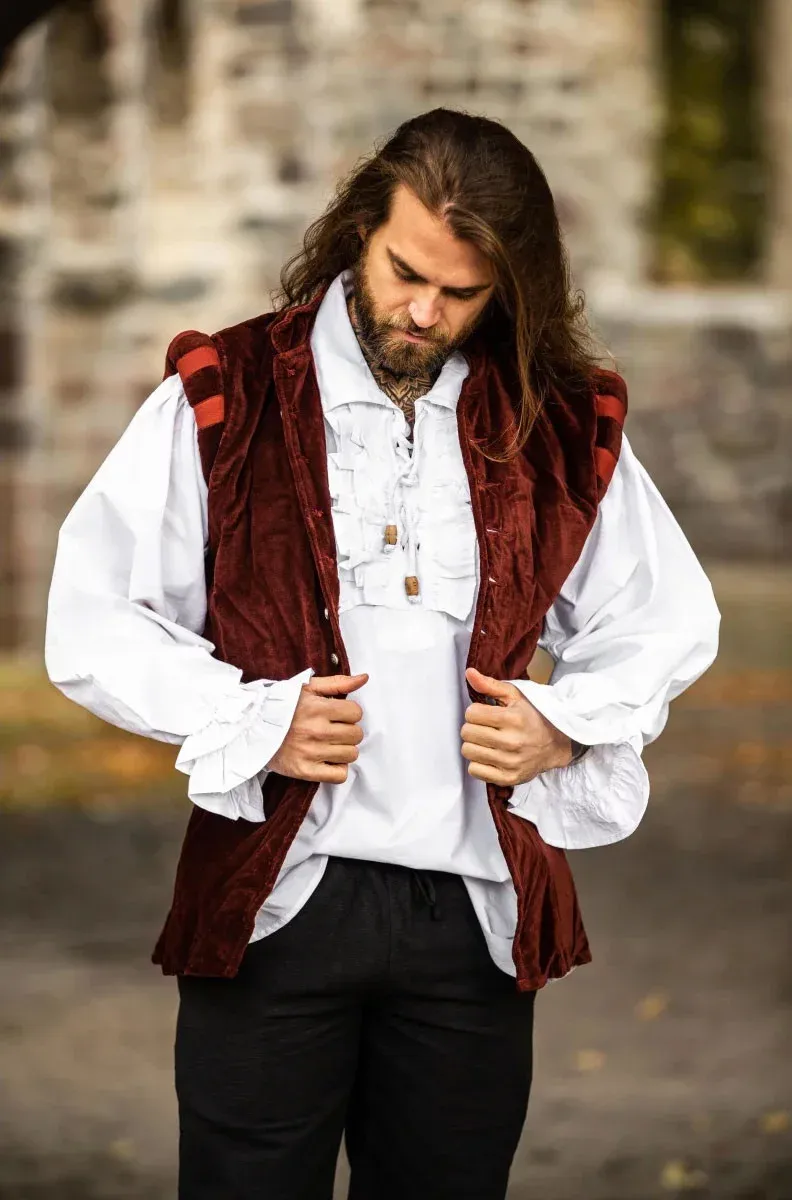
Evolution Throughout History
Over time, leather has evolved from being a garment primarily associated with protection and comfort to becoming an item of aesthetic and symbolic value.
During the Renaissance, the design of leather garments, including leather, underwent a significant evolution in terms of ornamental sophistication and artisanal beauty. Leather remains, to this day, a testament to the skill of medieval artisans and the importance of leather in the daily life of those times.
The headpieces have been an essential part of attire throughout history, serving multiple functions across various cultures and eras. From simple accessories to elaborate ceremonial adornments, their evolution reflects changes in societies and fashion trends. These elements have symbolized status, elegance, and in many cases, power, with origins dating back to ancient civilizations. In this article, we will explore the history and cultural significance of headpieces, emphasizing their importance both in the past and today.
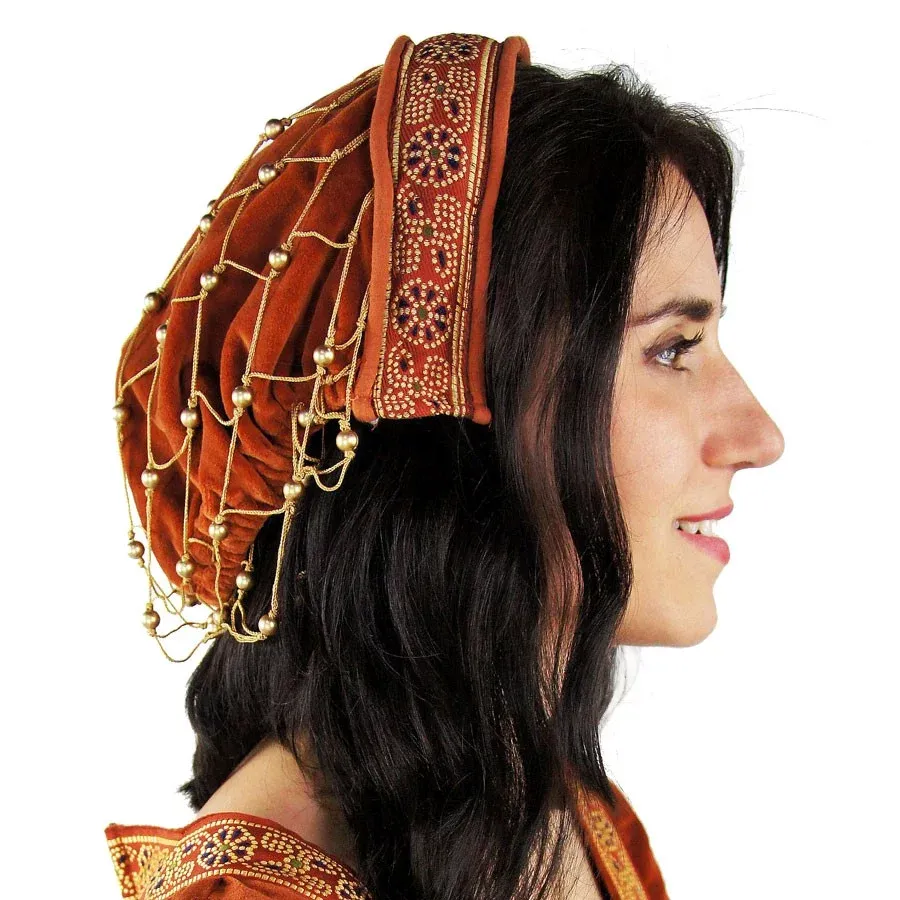
Historical Evolution of Headpieces
The term headpiece encompasses a wide range of garments or accessories intended to cover the head to varying degrees. Throughout history, they have fulfilled both aesthetic and cultural functions. In antiquity, headpieces were part of the wardrobe in civilizations such as Iberian and Roman, where they served as a reflection of social status and local traditions.
In Roman Hispania, diadems and tiaras were predominant, while in the Middle Ages, the diversity of shapes and styles depended on geographic context and social rank. During this period, these accessories not only decorated and protected but also indicated social position, marital status, and even family wealth, being essential in the daily attire of the upper classes.
Diversity of Headpieces in the Middle Ages
Some of the main types of medieval headpieces include:
- Bonete: A close-fitting cap.
- Hat: Various forms, worn both in cities and the countryside.
- Toca: Fabric covering the head and occasionally the neck and shoulders.
- Redingote: Mesh that gathered the hair, widely used across social classes.
- Garland: Ribbon or small crown, common among maidens.
- Cowl: Fine cap often worn under other headpieces.
- Cape: Practical and protective hood.
- Hennin: Tall cone with a veil, typical of Northern European nobility.
- Corniform headpiece: Horn-shaped, associated with wealth.
- Crown and diadem: Reserved for royalty and high-ranking ladies.
.png)
Functions of Headpieces Over Time
Headpieces have served various functions throughout their extensive history:
- Social differentiation: Their material, shape, and size reflected the wearer's social status.
- Fashion and beauty element: Beyond covering, they enhanced personal appearance.
- Ceremonial component: Imposing in rituals due to their symbolism.
- Protection: Against weather and for modesty reasons, especially among women.
The Headpiece in the Modern Era
Today, headpieces have resurged as fashion items, often used in formal events, weddings, and themed celebrations. This revival evokes both the aesthetic and symbolic aspects of these accessories' history. Medieval headpieces are handcrafted from materials such as cotton, linen, or velvet, adding authenticity and elegance to any ensemble.
Currently, as we revive past customs, medieval headpieces integrate into contemporary fashion. They represent not only a remnant of history but also a fascinating connection between tradition and style. As complementary accessories in modern fashion, headpieces continue to symbolize identity, status, and beauty, perpetuating their rich history through the centuries.
The jacket is a garment that represents an iconic part of men's fashion during the Renaissance. Also known by different names such as jaquetilla, xaqueta, or xaquetilla, its history dates back to the Late Middle Ages. Its development was driven not only by functional needs but also by a significant cultural transformation in how clothing was used as a symbol of social status and elegance.
Origin and Historical Evolution
The jacket was born approximately around the year 1370 within the military context, coinciding with the appearance of the doublet. Initially, this garment was designed for soldiers, providing additional protection when worn over the battle doublet and under armor or loriga. It was made with padding and lining of cotton or wool, features that provided insulation and warmth to the wearer. However, it soon transcended its military use to become civilian attire, gaining popularity during the 15th century.
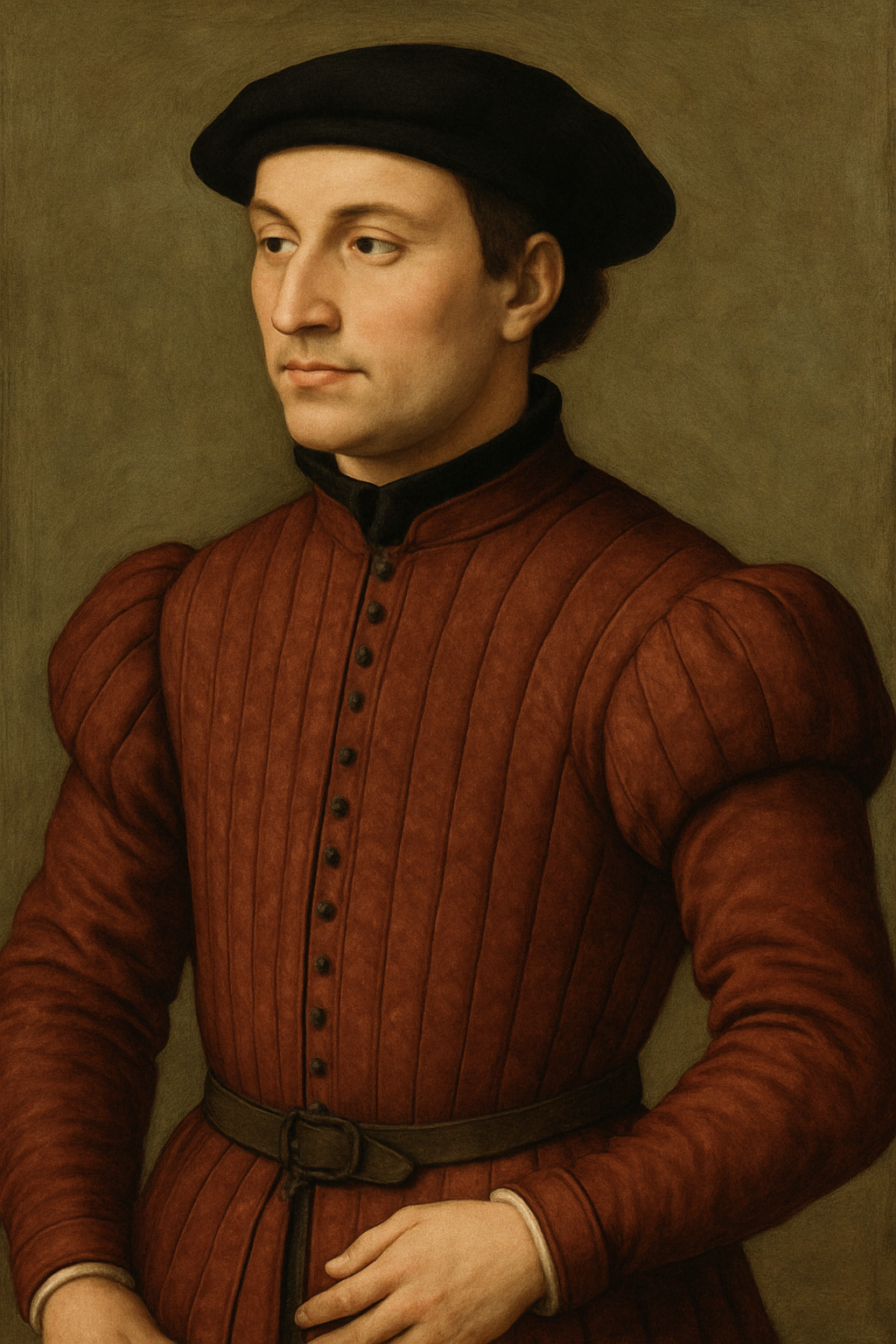
The jacket established itself as an essential piece of Renaissance men's wardrobe, commonly worn over the doublet and paired with hose. This fashion allowed for a wide range of styles, especially in the design of the sleeves, which could vary in cut and ornamentation.
Distinctive Features
One of the most distinctive features of the jacket was its length, which left the thighs exposed, causing some controversy within Christian medieval society. The garment was fitted to the body and often required help to put on or take off, reflecting not only a functional aspect but also an indicator of social status.
- Extremely fitted
- Padded for greater warmth
- Complemented with a belt of articulated plates (in its early forms)
Social Context and Usage
The jacket was particularly popular among young nobles and wealthy merchants, serving as a symbol of distinction and refinement. Its tailoring was carried out by the "jubonero," a craftsman specialized in this type of high-quality clothing. During its peak, it served not only a practical purpose but also reflected the status and stylistic taste of the wearer.
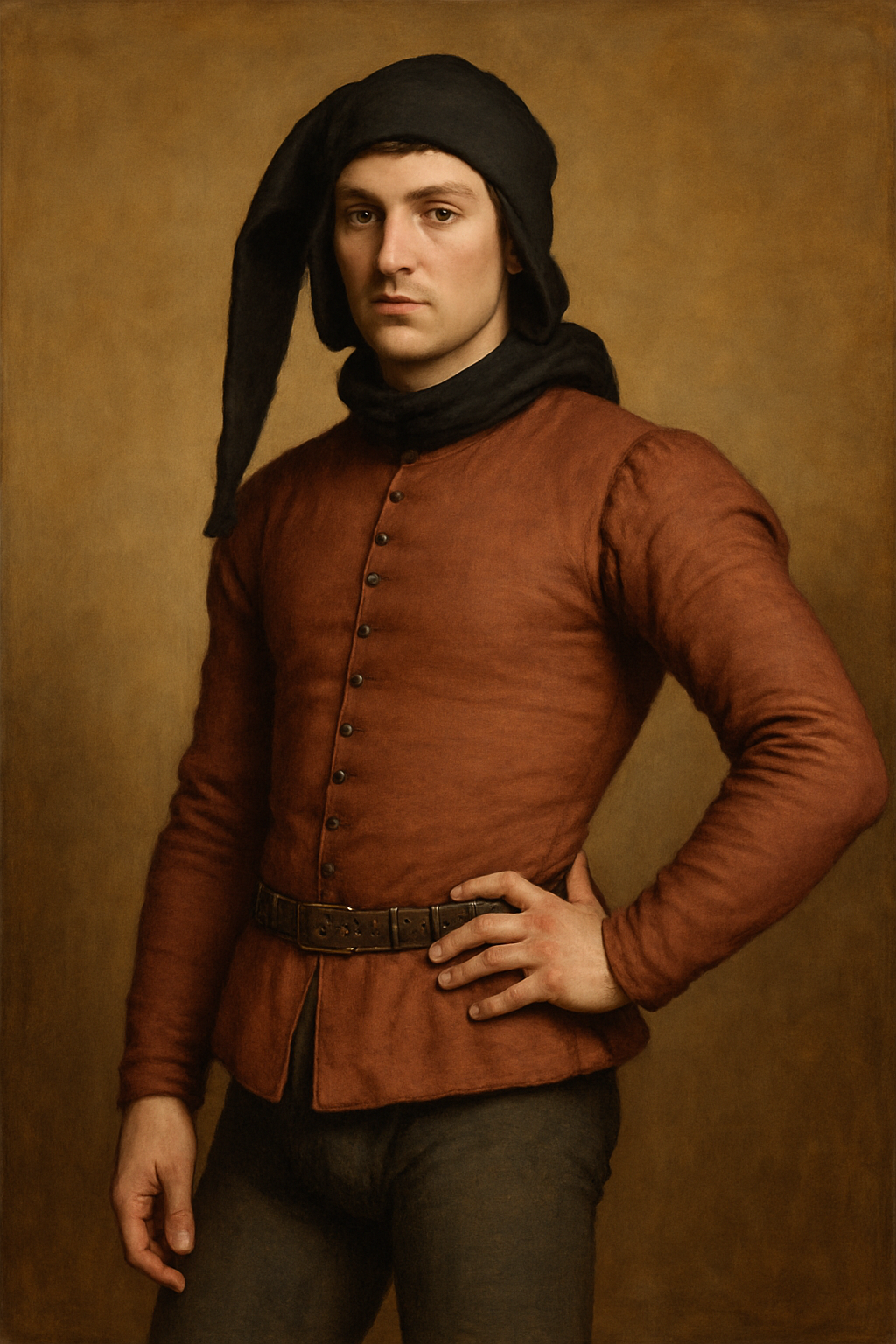
Evolution and Decline
With changing fashion trends over time, the shape and use of the jacket underwent transformations. In the early 15th century, the extremely tight style began to decline, and the jacket was incorporated into looser ensembles known as "short clothes."
From the 15th century onward, the jacket declined in popularity, and the term itself started to fall out of use. Before the 16th century, words such as "sayuelo" and "ropeta" began to replace it, marking its obsolescence in fashion terminology.
Variants and Cultural Legacy
There are known variants of the jacket, such as the jaquetilla, which is a shorter version of the original. This evolution had a significant impact on the development of later garments, laying the groundwork for what would later become modern jackets.
The legacy of the jacket is prominent in the history of Western clothing, representing a break with earlier fashion trends of the period and reflecting social and cultural changes of its time. The influence of the jacket remains present in contemporary fashion, demonstrating the importance of clothing as a reflection of social and cultural identity.
The jacket is a garment that represents an iconic part of men's fashion during the Renaissance. Also known by different names such as jaquetilla, xaqueta, or xaquetilla, its history dates back to the Late Middle Ages. Its development was driven not only by functional needs but also by a significant cultural transformation in how clothing was used as a symbol of social status and elegance.
Origin and Historical Evolution
The jacket was born approximately around the year 1370 within the military sphere, coinciding with the appearance of the doublet. Initially, this garment was designed for soldiers, providing additional protection when worn over the war doublet and under armor or loriga. It was made with padding and lining of cotton or wool, features that offered insulation and warmth to the wearer. However, it soon transcended its military use to become a civilian garment, gaining popularity during the 15th century.

The jacket established itself as an essential piece of Renaissance men's clothing, commonly worn over the doublet and combined with hose. This fashion allowed for a wide stylistic range, especially in sleeve design, which could vary in cut and ornamentation.
Distinctive Characteristics
One of the most distinctive features of the jacket was its length, which exposed the thighs, causing some controversy in Christian medieval society. The garment was form-fitting and often required assistance to put on or take off, showing not only a functional aspect but also an indicator of social status.
- Extremely tight-fitting
- Padded for greater warmth
- Complemented with a belt of articulated plates (in its early versions)
Social Context and Use
The jacket was particularly popular among young nobles and wealthy merchants, serving as a symbol of distinction and refinement. Its tailoring was carried out by the "jubonero," a craftsman specialized in this type of high-quality clothing. During its peak, it fulfilled not only a practical function but also reflected the social status and stylistic taste of the wearer.

Evolution and Decline
As fashion trends changed over time, the shape and use of the jacket underwent transformations. In the early 15th century, the extremely fitted style began to decline, and the jacket was incorporated into looser outfits known as "short clothing."
From the 15th century onward, the jacket waned in popularity, and the term itself began to fall out of use. Before the start of the 16th century, words like "sayuelo" and "ropeta" began to replace it, marking its obsolescence in fashion vocabulary.
Variants and Cultural Legacy
There are known variants of the jacket, such as the jaquetilla, which is a shorter version of the original. This evolution had a significant impact on the development of later garments, laying the groundwork for what would later become modern jackets.
The legacy of the jacket is prominent in the history of Western clothing, representing a break from previous fashion trends of the time and reflecting the social and cultural changes of its era. The influence of the jacket remains present in contemporary fashion, demonstrating the importance of clothing as a reflection of social and cultural identity.
The jacket is a garment that represents an iconic part of men's fashion during the Renaissance. Also known by different names such as jaquetilla, xaqueta, or xaquetilla, its history dates back to the Late Middle Ages. Its development was not only driven by functional needs but also by a significant cultural transformation in how clothing was used as a symbol of social status and elegance.
Origin and Historical Evolution
The jacket was born approximately around the year 1370 within the military context, coinciding with the appearance of the doublet. Initially, this garment was designed for soldiers, providing additional protection when worn over the war doublet and beneath armor or loriga. It was made with padding and a lining of cotton or wool, features that provided insulation and warmth to the wearer. However, it soon transcended its military use to become civilian attire, gaining popularity during the 15th century.

The jacket became a staple of Renaissance men's clothing, commonly worn over the doublet and combined with hose. This fashion allowed for a wide range of stylistic expression, especially in the design of the sleeves, which could vary in cut and ornamentation.
Distinctive Features
One of the most distinctive characteristics of the jacket was its length, which exposed the thighs and caused some controversy in Christian medieval society. The garment was form-fitting and often required assistance to put on or remove, displaying not only a functional aspect but also an indicator of social status.
- Extremely fitted
- Padded for extra warmth
- Complemented with a belt of articulated plates (in its early forms)
Social Context and Usage
The jacket was particularly popular among young nobles and wealthy merchants, serving as a symbol of distinction and refinement. Its tailoring was usually done by the "jubonero," an artisan specialized in this type of high-quality clothing. During its peak, it served not only a practical function but also reflected the social status and aesthetic taste of the wearer.

Evolution and Decline
With changing fashion trends over time, the shape and use of the jacket underwent transformations. By the early 15th century, the extremely tight fashion began to retreat, and the jacket was incorporated into looser clothing ensembles known as "short clothes."
From the 15th century onward, the jacket declined in popularity, and the term itself began to fall out of use. Before the beginning of the 16th century, words such as "sayuelo" and "ropeta" started to replace it, marking its obsolescence in fashion vocabulary.
Variants and Cultural Legacy
There are known variants of the jacket, such as the jaquetilla, which is a shorter version of the original. This evolution had a significant impact on the development of later garments, laying the groundwork for what would later become modern jackets.
The legacy of the jacket is prominent in the history of Western clothing, reflecting a break with previous fashion trends of the period and mirroring social and cultural changes of its time. The influence of the jacket remains present in contemporary fashion, demonstrating the importance of clothing as a reflection of social and cultural identity.
The jacket is a garment that represents an iconic part of men's fashion during the Renaissance. Also known by different names such as jaquetilla, xaqueta, or xaquetilla, its history dates back to the Late Middle Ages. Its development not only responded to functional needs but also marked a significant cultural transformation in how clothing was used as a symbol of social status and elegance.
Origin and Historical Evolution
The jacket was born around the year 1370 within the military realm, coinciding with the emergence of the doublet. Initially, this garment was designed for soldiers, providing additional protection when worn over the military doublet and under armor or loriga. It was made with padding and a cotton or wool lining, features that provided insulation and warmth to the wearer. However, it soon transcended its military use to become a civilian garment, gaining popularity during the 15th century.

The jacket established itself as an essential piece of Renaissance men's wardrobe, commonly worn over the doublet and paired with hose. This fashion allowed for a wide range of stylistic variations, especially in the design of the sleeves, which could vary in cut and ornamentation.
Distinctive Features
One of the most distinctive characteristics of the jacket was its length, which exposed the thighs, causing some controversy in medieval Christian society. The garment was fitted to the body and often required assistance to put on or take off, reflecting not only a functional aspect but also an indicator of social status.
- Extremely close-fitting
- Padded for greater warmth
- Complemented with a belt with articulated plates (in its early forms)
Social Context and Usage
The jacket was particularly popular among young nobles and wealthy merchants, serving as a symbol of distinction and refinement. Its crafting was entrusted to the "jubonero," a craftsman specialized in this type of high-quality clothing. During its peak, it fulfilled not only a practical function but also reflected the social status and aesthetic taste of the wearer.

Evolution and Decline
With changing fashion trends over time, the shape and use of the jacket underwent transformations. By the early 15th century, the extremely tight fashion began to decline, and the jacket was incorporated into looser outfits known as "short clothes."
From the 15th century onward, the jacket declined in popularity, and the term itself went out of use. Before the start of the 16th century, words like "sayuelo" and "ropeta" began replacing it, marking its obsolescence in fashion vocabulary.
Variants and Cultural Legacy
There are known variants of the jacket, such as the jaquetilla, which is a shorter version of the original. This evolution had a significant impact on the development of subsequent garments, laying the groundwork for what later became modern jackets.
The legacy of the jacket is prominent in the history of Western clothing, demonstrating a break from previous fashion trends of the period and reflecting social and cultural changes of its time. The influence of the jacket remains present in contemporary fashion, highlighting the importance of fashion as a reflection of social and cultural identity.
The jacket is a garment that represents an iconic part of men's fashion during the Renaissance. Also known by different names such as jaquetilla, xaqueta, or xaquetilla, its history dates back to the Late Middle Ages. Its development was not only driven by functional needs but also by a significant cultural transformation in how clothing was used as a symbol of social status and elegance.
Origin and Historical Evolution
The jacket was created around the year 1370 within the military sphere, coinciding with the appearance of the doublet. Initially, this garment was designed for soldiers, providing additional protection when worn over the battle doublet and beneath armor or chainmail. It was made with padding and a lining of cotton or wool, features that offered insulation and warmth to the wearer. However, it soon transcended its military use to become a civilian garment, gaining popularity during the 15th century.

The jacket became a fundamental piece of men's wardrobe during the Renaissance, commonly worn over the doublet and combined with hose. This fashion allowed for a wide range of stylistic variations, especially in sleeve design, which could vary in cut and ornamentation.
Distinctive Features
One of the most distinctive features of the jacket was its length, which left the thighs exposed, causing some controversy in Christian medieval society. The garment was tight-fitting and often required assistance to be put on or taken off, reflecting not only a functional aspect but also an indicator of social status.
- Extremely tight-fitting
- Complemented with a belt of articulated plates (in its early forms)
Social Context and Usage
The jacket was particularly popular among young nobles and wealthy merchants, serving as a symbol of distinction and refinement. Its tailoring was managed by the "jubonero," a craftsman specialized in this high-quality garment. During its peak, it fulfilled not only a practical function but also reflected the status and stylistic taste of the wearer.

Evolution and Decline
With changing fashion trends over time, the shape and use of the jacket underwent transformations. In the early 15th century, the extremely fitted style began to decline, and the jacket was integrated into looser outfits known as "short clothes."
Starting in the 15th century, the jacket declined in popularity, and the term itself started to fall out of use. Before the 16th century, words like "sayuelo" and "ropeta" began to replace it, marking its obsolescence in fashion vocabulary.
Variants and Cultural Legacy
There are known variants of the jacket, such as the jaquetilla, which is a shorter version of the original. This evolution significantly influenced later garments, setting the precedent for modern jackets.
The legacy of the jacket is prominent in the history of Western clothing, showing a break from previous trends of the time and reflecting social and cultural changes. The influence of the jacket remains present in contemporary fashion, demonstrating the importance of clothing as a reflection of social and cultural identity.
The jacket is an garment that represents an iconic part of men's fashion during the Renaissance. Also known under various names such as jaquetilla, xaqueta, or xaquetilla, its history dates back to the late Middle Ages. Its development was driven not only by functional needs but also by a significant cultural transformation in how clothing was used as a symbol of social status and elegance.
Origin and Historical Evolution
The jacket was born approximately around the year 1370 within the military sphere, coinciding with the appearance of the doublet. Initially, this garment was designed for soldiers, providing extra protection when worn over the war doublet and beneath armor or loriga. It was made with padding and lined with cotton or wool, features that offered insulation and warmth to the wearer. However, it soon transcended its military use to become a civilian garment, gaining popularity during the 15th century.

The jacket established itself as an essential piece of Renaissance men's wardrobe, commonly worn over the doublet and paired with hose. This fashion allowed for a broad range of styles, especially in sleeve design, which could vary in cut and ornamentation.
Distinctive Features
One of the most distinctive features of the jacket was its length, which revealed the thighs, causing some controversy in medieval Christian society. The garment was fitted to the body and often required assistance to put on or remove, showing not only a functional aspect but also an indicator of social status.
- Extremely close-fitting
- Padded for additional warmth
- Complemented with a belt of articulated plates (in its early versions)
Social Context and Usage
The jacket was particularly popular among young nobles and wealthy traders, serving as a symbol of distinction and refinement. Its tailoring was carried out by the "jubonero," an artisan specialized in this type of high-quality clothing. During its peak, it fulfilled not only a practical function but also reflected the social status and stylistic taste of the wearer.

Evolution and Decline
With changing fashion trends over time, the shape and use of the jacket underwent transformations. In the early 15th century, the extremely tight-fitting style began to decline, and the jacket was incorporated into looser clothing ensembles known as "short clothing."
From the 15th century onward, the jacket declined in popularity, and the term itself began to fall out of use. Before the start of the 16th century, words like "sayuelo" and "ropeta" began to replace it, marking its obsolescence in fashion terminology.
Variants and Cultural Legacy
There are known variants of the jacket, such as the jaquetilla, which is a shorter version of the original. This evolution had a significant impact on the development of later garments, setting precedents for what would later become modern jackets.
The legacy of the jacket is prominent in the history of Western clothing, showing a break from previous trends of the era and reflecting social and cultural changes of its time. The influence of the jacket remains present in contemporary fashion, demonstrating the importance of fashion as a reflection of social and cultural identity.
The jacket is a garment that represents an iconic part of men's fashion during the Renaissance. Also known by different names such as jaquetilla, xaqueta, or xaquetilla, its history dates back to the Late Middle Ages. Its development not only responds to functional needs but also to a significant cultural transformation in how clothing was used as a symbol of social status and elegance.
Origin and Historical Evolution
The jacket was born approximately around the year 1370 within the military sphere, coinciding with the appearance of the doublet. Initially, this garment was designed for soldiers, providing additional protection when worn over the battle doublet and under armor or loriga. It was made with padding and a lining of cotton or wool, characteristics that added insulation and warmth to the wearer. However, it soon transcended its military use to become civil attire, gaining popularity during the 15th century.

The jacket solidified as an essential piece of Renaissance men's wardrobe, commonly worn over the doublet and combined with hose. This fashion allowed for a wide stylistic range, especially in the design of the sleeves, which could vary in cut and ornamentation.
Distinctive Characteristics
One of the most distinctive features of the jacket was its length, which exposed the thighs, causing some controversy in Christian medieval society. The garment was form-fitting and often required assistance to put on or take off, displaying not only a functional aspect but also an indicator of social status.
- Extremely fitted
- Padded for greater warmth
- Complemented with a belt of articulated plates (in its early stages)
Social Context and Use
The jacket was particularly popular among young nobles and wealthy merchants, being a symbol of distinction and refinement. Its tailoring was carried out by the "jubonero," a craftsman specialized in this type of high-quality clothing. During its peak, it served not only a practical function but also reflected the status and stylistic taste of the wearer.

Evolution and Decline
With changes in fashion over time, the shape and use of the jacket underwent transformations. By the early 15th century, the extremely tight fashion began to recede, and the jacket was incorporated into looser outfits known as "short clothes."
From the 15th century onward, the jacket declined in popularity, and the term itself began to fall out of use. Before the 16th century, words like "sayuelo" and "ropeta" started replacing it, marking its obsolescence in fashion language.
Variants and Cultural Legacy
There are known variants of the jacket, such as the jaquetilla, which is a shorter version of the original. This evolution had a significant impact on the development of later garments, setting precedents for what would become modern jackets.
The legacy of the jacket is prominent in the history of Western clothing, demonstrating a break from previous trends of the period and reflecting the social and cultural changes of its time. The influence of the jacket remains present in contemporary fashion, showcasing the importance of clothing as a reflection of social and cultural identity.
The jacket is a garment that represents an iconic part of men's fashion during the Renaissance. Also known by different names such as jaquetilla, xaqueta, or xaquetilla, its history dates back to the Late Middle Ages. Its development was not only driven by functional needs but also by a significant cultural transformation in how clothing was used as a symbol of social status and elegance.
Origin and Historical Evolution
The jacket was born approximately around the year 1370 within the military context, coinciding with the appearance of the doublet. Initially, this garment was designed for soldiers, providing additional protection when worn over the war doublet and under armor or lorica. It was made with padding and cotton or wool lining, features that provided insulation and warmth to the wearer. However, it soon transcended its military use to become civilian attire, gaining popularity during the 15th century.

The jacket became a staple element of Renaissance men's wardrobe, commonly worn over the doublet and paired with hose. This fashion allowed for a wide range of stylistic variations, especially in sleeve design, which could vary in cut and ornamentation.
Distinctive Features
One of the most distinctive features of the jacket was its length, which exposed the thighs, causing some controversy in medieval Christian society. The garment was closely fitted to the body and often required assistance to put on or remove, showing not only a functional aspect but also an indicator of social status.
- Extremely tight-fitting
- Complemented with a belt of articulated plates (in its early forms)
Social Context and Use
The jacket was particularly popular among young nobles and wealthy merchants, serving as a symbol of distinction and refinement. Its tailoring was carried out by the "jubonero," an artisan specialized in this high-quality type of clothing. During its peak, it fulfilled not only a practical function but also reflected the status and stylistic taste of the wearer.

Evolution and Decline
With changing fashions over time, the shape and use of the jacket underwent transformations. In the early 15th century, the extremely tight fashion began to recede, and the jacket was integrated into looser outfits known as "short clothing."
From the 15th century onward, the jacket declined in popularity, and the term itself began to fall out of use. Before the 16th century, words such as "sayuelo" and "ropeta" started to replace it, marking its obsolescence in fashion language.
Variants and Cultural Legacy
There are known variants of the jacket, such as the jaquetilla, which is a shorter version of the original. This evolution had a significant impact on the development of later garments, setting precedents for what would later become modern jackets.
The legacy of the jacket is prominent in the history of Western clothing, showing a break from previous fashion trends of the time and reflecting the social and cultural changes of its era. The influence of the jacket remains present in contemporary fashion, demonstrating the importance of clothing as a reflection of social and cultural identity.
The jacket is a garment that represents an iconic part of men's fashion during the Renaissance. Also known by different names such as jaquetilla, xaqueta, or xaquetilla, its history dates back to the Late Middle Ages. Its development was driven not only by functional needs but also by a significant cultural transformation in how clothing was used as a symbol of social status and elegance.
Origin and Historical Evolution
The jacket was born approximately around the year 1370 within the military sphere, coinciding with the appearance of the doublet. Initially, this garment was designed for soldiers, providing extra protection when worn over the doublet of war and under armor or loriga. It was made with padding and a cotton or wool lining, features that provided insulation and warmth to the wearer. However, its use soon extended beyond the military to become a civilian garment, gaining popularity during the 15th century.

The jacket became a staple of men's wardrobe during the Renaissance, commonly worn over the doublet and paired with hose. This fashion allowed for a wide range of stylistic expression, especially in the design of the sleeves, which could vary in cut and ornamentation.
Distinctive Features
One of the most distinctive features of the jacket was its length, which exposed the thighs, causing some controversy in Christian medieval society. The garment was fitted to the body and often required assistance to put on or take off, reflecting not only a functional aspect but also an indicator of social status.
- Extremely tight-fitting
- Quilted for additional warmth
- Complemented with a belt of articulated plates (in its early forms)
Social Context and Usage
The jacket was particularly popular among young nobles and wealthy merchants, serving as a symbol of distinction and refinement. Its tailoring was performed by the "jubonero," a craftsman specialized in this high-quality type of clothing. During its peak, the jacket served not only as a practical garment but also as a reflection of the wearer's status and stylistic taste.

Evolution and Decline
As fashion trends changed over time, the shape and use of the jacket underwent transformations. By the early 15th century, the extremely tight-fitting style began to decline, and the jacket was incorporated into looser outfits known as "short clothing."
From the 15th century onward, the jacket's popularity waned, and the term itself started to fall out of use. Before the 16th century, words like "sayuelo" and "ropeta" began to replace it, marking its obsolescence in fashion vocabulary.
Variants and Cultural Legacy
There are known variants of the jacket, such as the jaquetilla, which is a shorter version of the original. This evolution had a significant impact on the development of later garments, setting precedents for what would eventually become modern jackets.
The legacy of the jacket is prominent in the history of Western clothing, showing a break with previous fashion trends of the period and reflecting social and cultural changes of its time. The influence of the jacket remains present in contemporary fashion, demonstrating the importance of clothing as a reflection of social and cultural identity.
The jacket is a garment representing an iconic part of men's fashion during the Renaissance. Also known by various names such as jaquetilla, xaqueta, or xaquetilla, its history dates back to the Late Middle Ages. Its development was driven not only by functional needs but also by a significant cultural transformation in how clothing was used as a symbol of social status and elegance.
Origin and Historical Evolution
The jacket was born approximately around the year 1370 within the military context, coinciding with the appearance of the doublet. Initially, this garment was designed for soldiers, providing additional protection when worn over the combat doublet and under armor or chainmail. It was made with padding and lined with cotton or fleece, features that provided insulation and warmth to the wearer. However, it soon transcended its military use to become a civil garment, gaining popularity during the 15th century.

The jacket became a staple of Renaissance men's wardrobe, commonly worn over the doublet and combined with hose. This fashion allowed for a wide range of styles, especially in the design of the sleeves, which could vary in cut and ornamentation.
Distinctive Characteristics
One of the most distinctive features of the jacket was its length, which exposed the thighs, causing some controversy in Christian medieval society. The garment was close-fitting and often required assistance to put on or remove, showcasing not only a functional aspect but also an indicator of social status.
- Extremely tight-fitting
- Padded for increased warmth
- Complemented with a belt of articulated plates (in its early versions)
Social Context and Usage
The jacket was particularly popular among young nobles and wealthy merchants, serving as a symbol of distinction and refinement. Its tailoring was handled by the "jubonero," a craftsman specialized in this type of high-quality clothing. During its peak, it served not only a practical function but also reflected the status and stylistic taste of the wearer.

Evolution and Decline
With changing fashions over time, the shape and use of the jacket underwent transformations. By the early 15th century, the extremely tight fashion began to recede, and the jacket was incorporated into looser outfits known as "short clothing."
From the 15th century onward, the jacket declined in popularity, and the term itself began to fall out of use. Before the start of the 16th century, words like "sayuelo" and "ropeta" began to replace it, marking its obsolescence in fashion language.
Variants and Cultural Legacy
There are known variants of the jacket, such as the jaquetilla, which is a shorter version of the original. This evolution had a significant impact on the development of later garments, setting precedents for what would later become modern jackets.
The legacy of the jacket is prominent in the history of Western clothing, showing a break from previous fashion trends of the period and reflecting social and cultural changes of its time. The influence of the jacket remains present in contemporary fashion, demonstrating the importance of fashion as a reflection of social and cultural identity.
The jacket is a garment that represents an iconic part of men's fashion during the Renaissance. Also known by different names such as jaquetilla, xaqueta, or xaquetilla, its history dates back to the Late Middle Ages. Its development was not only driven by functional needs but also by a significant cultural transformation in how clothing was used as a symbol of social status and elegance.
Origin and Historical Evolution
The jacket emerged approximately around the year 1370 within the military realm, coinciding with the appearance of the doublet. Initially, this garment was designed for soldiers, providing additional protection when worn over the doublet of war and under armor or lorica. It was made with padding and lined with cotton or wool, characteristics that offered insulation and warmth to the wearer. However, it soon transcended its military use to become civilian attire, gaining popularity during the 15th century.

The jacket became a staple piece of Renaissance men's clothing, commonly worn over the doublet and paired with hose. This fashion allowed for a wide stylistic range, especially in the design of the sleeves, which could vary in cut and ornamentation.
Distinctive Features
One of the most distinctive features of the jacket was its length, which exposed the thighs, causing some controversy in Christian medieval society. The garment was fitted to the body and often required assistance to put on or take off, indicating not only a functional aspect but also a sign of social status.
- Extremely fitted
- Padded for greater warmth
- Paired with a belt of articulated plates (in its early forms)
Social Context and Usage
The jacket was particularly popular among young nobles and affluent merchants, serving as a symbol of distinction and refinement. Its tailoring was carried out by the "jubonero," a craftsman specialized in this type of high-quality clothing. During its peak, it served not only a practical function but also reflected the status and aesthetic taste of the wearer.

Evolution and Decline
As fashion trends changed over time, the shape and use of the jacket underwent transformations. By the early 15th century, the extremely tight fashion began to decline, and the jacket was incorporated into looser clothing ensembles known as "short garments."
Starting from the 15th century, the jacket declined in popularity, and the term itself began to fall out of use. Before the beginning of the 16th century, words such as "sayuelo" and "ropeta" started replacing it, marking its obsolescence in fashion vocabulary.
Variants and Cultural Legacy
There are known variants of the jacket, such as the jaquetilla, which is a shorter version of the original. This evolution had a significant impact on the development of later garments, setting precedents for what would later become modern jackets.
The legacy of the jacket is prominent in the history of Western clothing, showcasing a break from previous trends of the era and reflecting social and cultural changes of its time. The influence of the jacket remains present in contemporary fashion, demonstrating the importance of clothing as a reflection of social and cultural identity.
The jacket is a garment that represents an iconic part of men's fashion during the Renaissance. Also known by different names such as jaquetilla, xaqueta, or xaquetilla, its history dates back to the Late Middle Ages. Its development was not only driven by functional needs but also by a significant cultural transformation in how clothing was used as a symbol of social status and elegance.
Origin and Historical Evolution
The jacket was born approximately around the year 1370 within the military sphere, coinciding with the appearance of the doublet. Initially, this garment was designed for soldiers, providing additional protection when worn over the doublet of war and under armor or cuirass. It was made with padding and a lining of cotton or wool, features that provided insulation and warmth to the wearer. However, it soon transcended its military use to become a civilian garment, gaining popularity during the 15th century.

The jacket established itself as an essential piece of men's wardrobe during the Renaissance, commonly worn over the doublet and combined with hose. This fashion allowed for a wide range of styles, especially in the design of the sleeves, which could vary in cut and ornamentation.
Distinctive Features
One of the most distinctive features of the jacket was its length, which exposed the thighs, causing some controversy in medieval Christian society. The garment was form-fitting and often required assistance to put on or take off, showing not only a functional aspect but also an indicator of social status.
- Extremely form-fitting
- Padding for added warmth
- In early versions, complemented with a belt of articulated plates
Social Context and Usage
The jacket was particularly popular among young nobles and wealthy merchants, serving as a symbol of distinction and refinement. Its tailoring was handled by the "jubonero," a craftsman specialized in this type of high-quality clothing. During its peak, it fulfilled not only a practical function but also reflected the status and stylistic taste of the wearer.

Evolution and Decline
With changing fashion trends over time, the shape and use of the jacket underwent transformations. By the early 15th century, the extremely tight style began to recede, and the jacket was integrated into looser dress ensembles known as "short clothing."
From the 15th century onward, the jacket declined in popularity, and the term itself began to fall out of use. Before the start of the 16th century, words like "sayuelo" and "ropeta" began to replace it, marking its obsolescence in fashion vocabulary.
Variants and Cultural Legacy
There are known variants of the jacket, such as the jaquetilla, which is a shorter version of the original. This evolution had a significant impact on the development of later garments, laying the groundwork for what would later become modern jackets.
The legacy of the jacket is prominent in the history of Western clothing, showing a break with previous fashion trends of the era and reflecting social and cultural changes of its time. The influence of the jacket remains present in contemporary fashion, demonstrating the importance of fashion as a mirror of social and cultural identity.
The jacket is a garment that represents an iconic part of men's fashion during the Renaissance. Also known by various other names such as jaquetilla, xaqueta, or xaquetilla, its history dates back to the Early Middle Ages. Its development was not only driven by functional needs but also by a significant cultural transformation in how clothing was used as a symbol of social status and elegance.
Origin and Historical Evolution
The jacket was born approximately around the year 1370 within the military sphere, coinciding with the appearance of the doublet. Initially, this garment was designed for soldiers, providing additional protection when worn over the combat doublet and under armor or a hauberk. It was made with padding and a lining of cotton or wool, features that provided insulation and warmth to the wearer. However, it soon transcended its military use to become civilian attire, gaining popularity during the 15th century.

The jacket became a staple of Renaissance men's clothing, commonly worn over the doublet and combined with hose. This fashion allowed for a wide stylistic range, especially in sleeve design, which could vary in cut and ornamentation.
Distinctive Features
One of the most distinctive characteristics of the jacket was its length, which exposed the thighs, causing some controversy in Christian medieval society. The garment was form-fitting and often required assistance to put on or take off, displaying not only a functional aspect but also an indicator of social status.
- Extremely close-fitting
- Padded for added warmth
- Complemented with a belt made of articulated plates (in its early forms)
Social Context and Use
The jacket was particularly popular among young nobles and wealthy merchants, serving as a symbol of distinction and refinement. Its tailoring was handled by the "jubonero," a craftsman specialized in this type of high-quality clothing. During its peak, it fulfilled not only a practical function but also reflected the social status and aesthetic taste of the wearer.

Evolution and Decline
As fashion trends changed over time, the shape and use of the jacket underwent transformations. By the early 15th century, the extremely tight-fitting style started to decline, and the jacket was integrated into looser outfits known as "short clothing."
From the 15th century onward, the jacket waned in popularity, and the term itself began to fall out of use. Before the start of the 16th century, words like "sayuelo" and "ropeta" began replacing it, marking its obsolescence in fashion vocabulary.
Variants and Cultural Legacy
There are known variants of the jacket, such as the jaquetilla, which is a shorter version of the original. This evolution had a significant impact on the development of later garments, setting precedents for what would eventually become modern jackets.
The legacy of the jacket is prominent in the history of Western fashion, showcasing a break from previous trends of the era and reflecting social and cultural changes of its time. The influence of the jacket remains evident in contemporary fashion, demonstrating the importance of clothing as a reflection of social and cultural identity.
The jacket is a garment that represents an iconic part of men's fashion during the Renaissance. Also known by different names such as jaquetilla, xaqueta, or xaquetilla, its history dates back to the Late Middle Ages. Its development was not only driven by functional needs but also by a significant cultural transformation in how clothing was used as a symbol of social status and elegance.
Origin and Historical Evolution
The jacket was born approximately around the year 1370 within the military sphere, coinciding with the appearance of the doublet. Initially, this garment was designed for soldiers, providing additional protection when worn over the war doublet and beneath armor or chainmail. It was made with padding and lined with cotton or wool, features that offered insulation and warmth to the wearer. However, it soon transcended its military use to become civilian attire, gaining popularity during the 15th century.

Distinctive Features
One of the most distinctive features of the jacket was its length, which revealed the thighs, causing some controversy in medieval Christian society. The garment was form-fitting and often required assistance to put on or take off, reflecting not only a functional aspect but also an indicator of social status.- Extremely tight-fitting
- Padded for greater warmth
- Complemented with a belt made of articulated plates (in its early stages)
Social Context and Usage
The jacket was particularly popular among young nobles and wealthy merchants, serving as a symbol of distinction and refinement. Its making was overseen by the "jubonero," a craftsman specialized in this type of high-quality garment. During its peak, it fulfilled not only a practical function but also reflected the status and stylistic taste of the wearer.

Evolution and Decline
With changing fashion trends over time, the shape and use of the jacket underwent transformations. In the early 15th century, the extremely fitted style began to recede, and the jacket was incorporated into looser ensembles known as "short garments." From the 15th century onward, the jacket declined in popularity, and the term itself began to fall out of use. Before the start of the 16th century, words like "sayuelo" and "ropeta" began replacing it, marking its obsolescence in fashion terminology.Variants and Cultural Legacy
There are known variants of the jacket, such as the jaquetilla, which is a shorter version of the original. This evolution had a significant impact on the development of later garments, paving the way for what would later become modern jackets. The legacy of the jacket is prominent in the history of Western clothing, showcasing a break from the previous trends of its time and reflecting social and cultural changes of its era. The influence of the jacket remains present in contemporary fashion, demonstrating the importance of fashion as a reflection of social and cultural identity.The jacket is a garment that represents an iconic part of men's fashion during the Renaissance. Also known by different names such as jaquetilla, xaqueta, or xaquetilla, its history dates back to the Late Middle Ages. Its development responds not only to functional needs but also to a significant cultural transformation in how clothing was used as a symbol of social status and elegance.
Origin and Historical Evolution
The jacket was created approximately around the year 1370 within the military sphere, coinciding with the appearance of the doublet. Initially, this garment was designed for soldiers, providing extra protection when worn over the battle doublet and beneath armor or chainmail. It was made with padding and lining of cotton or wool, features that provided insulation and warmth to the wearer. However, it soon transcended its military use to become civilian clothing, gaining popularity during the 15th century.

The jacket established itself as an essential piece of men's wardrobe during the Renaissance, commonly worn over the doublet and paired with hose. This fashion allowed for a wide range of stylistic variations, especially in sleeve design, which could be varied in cut and ornamentation.
Distinctive Features
One of the most distinctive features of the jacket was its length, which revealed the thighs, causing some controversy in Christian medieval society. The garment was snug-fitting and often required assistance to put on or remove, showing not only a functional aspect but also an indicator of social status.
- Extremely form-fitting
- Padded for additional warmth
- Originally complemented with a belt with articulated plates
Social Context and Usage
The jacket was particularly popular among young nobles and wealthy merchants, serving as a symbol of distinction and refinement. Its tailoring was overseen by the "jubonero," a craftsman specialized in this type of high-quality clothing. During its peak, it fulfilled not only a practical function but also reflected the social status and stylistic taste of the wearer.

Evolution and Decline
With changing fashion trends over time, the shape and use of the jacket underwent transformations. By the early 15th century, extremely tight clothing began to decline, and the jacket was incorporated into larger, looser outfits known as "short clothes."
From the 15th century onward, the jacket declined in popularity, and the term itself began to fall out of use. Before the start of the 16th century, words like "sayuelo" and "ropeta" began to replace it, marking its obsolescence in fashion vocabulary.
Variants and Cultural Legacy
There are known variants of the jacket, such as the jaquetilla, which is a shorter version of the original. This evolution had a significant impact on the development of later garments, setting precedents for what would later become modern jackets.
The legacy of the jacket is prominent in the history of Western clothing, showing a break from the previous trends of the era and reflecting social and cultural changes of its time. The influence of the jacket remains present in contemporary fashion, demonstrating the importance of fashion as a reflection of social and cultural identity.
The jacket is a garment that represents an iconic part of men's fashion during the Renaissance. Also known by different names such as jaquetilla, xaqueta, or xaquetilla, its history dates back to the Late Middle Ages. Its development not only responded to functional needs but also to a significant cultural transformation in how clothing was used as a symbol of social status and elegance.
Origin and Historical Evolution
The jacket was born approximately around the year 1370 within the military sphere, coinciding with the appearance of the doublet. Initially, this garment was designed for soldiers, providing additional protection when worn over the doublet of war and under armor or chainmail. It was made with padding and a lining of cotton or wool, features that provided insulation and warmth to the wearer. However, it quickly transcended its military use to become a civilian garment, gaining popularity during the 15th century.

The jacket became a staple of men's wardrobe during the Renaissance, commonly worn over the doublet and combined with hose. This fashion allowed for a wide range of stylistic variations, especially in sleeve design, which could vary in cut and ornamentation.
Distinctive Features
One of the most distinctive features of the jacket was its length, which exposed the thighs, causing some controversy in Christian medieval society. The garment was form-fitting and often required assistance to put on or take off, showing not only a functional aspect but also an indicator of social status.
- Extremely tight
- Enhanced with a belt of articulated plates (in its early versions)
Social Context and Use
The jacket was particularly popular among young nobles and wealthy merchants, serving as a symbol of distinction and refinement. Its tailoring was the responsibility of the "jubonero," a craftsman specialized in this type of high-quality clothing. During its peak, it served not only a practical function but also reflected the social status and stylistic taste of the wearer.

Evolution and Decline
With changing fashion trends over time, the shape and use of the jacket underwent transformations. At the beginning of the 15th century, the highly fitted fashion started to decline and the jacket was integrated into looser outfits known as "short clothes."
From the 15th century onward, the jacket declined in popularity, and the term itself began falling out of use. Before the start of the 16th century, words such as "sayuelo" and "ropeta" began to replace it, marking its obsolescence in fashion vocabulary.
Variants and Cultural Legacy
There are known variants of the jacket, such as the jaquetilla, which is a shorter version of the original. This evolution had a significant impact on the development of later garments, setting precedents for what would later become modern jackets.
The legacy of the jacket is prominent in the history of Western clothing, showing a break from previous trends of the time and reflecting the social and cultural changes of its era. The influence of the jacket remains present in contemporary fashion, demonstrating the importance of fashion as a reflection of social and cultural identity.
The jacket is a garment that represents an iconic part of men's fashion during the Renaissance. Also known by different names such as jaquetilla, xaqueta, or xaquetilla, its history dates back to the Late Middle Ages. Its development not only responds to functional needs but also to a significant cultural transformation in how clothing was used as a symbol of social status and elegance.
Origin and Historical Evolution
The jacket was born approximately around the year 1370 within the military context, coinciding with the appearance of the doublet. Initially, this garment was designed for soldiers, providing additional protection when worn over the military doublet and under armor or lorica. It was made with padding and a cotton or wool lining, features that offered insulation and warmth to the wearer. However, it soon transcended its military use to become civilian attire, gaining popularity during the 15th century.

The jacket solidified as an essential piece of men's clothing during the Renaissance, commonly worn over the doublet and paired with hose. This fashion allowed for a wide stylistic range, especially in sleeve design, which could vary in cut and decoration.
Distinctive Characteristics
One of the most distinctive features of the jacket was its length, which revealed the thighs, causing some controversy in Christian medieval society. The garment was form-fitting and often required assistance to put on or remove, showcasing not only a functional aspect but also an indicator of social status.
- Extremely fitted
- Padded for added warmth
- Complemented with a belt of articulated plates (in its early forms)
Social Context and Usage
The jacket was particularly popular among young nobles and wealthy merchants, being a symbol of distinction and refinement. Its construction was carried out by the "jubonero," a craftsman specialized in this type of high-quality clothing. During its peak, it served not only a practical function but also reflected the status and stylistic taste of the wearer.

Evolution and Decline
With changing fashion trends over time, the shape and use of the jacket underwent transformations. In the early 15th century, the extremely tight style began to decline, and the jacket was incorporated into looser outfits known as "short clothing."
From the 15th century onward, the jacket declined in popularity, and the term itself began to fall out of use. Before the early 16th century, words like "sayuelo" and "ropeta" started to replace it, marking its obsolescence in fashion terminology.
Variants and Cultural Legacy
There are known variants of the jacket, such as the jaquetilla, which is a shorter version of the original. This evolution had a significant impact on the development of later garments, laying the groundwork for what would become modern jackets.
The legacy of the jacket is prominent in the history of Western clothing, demonstrating a break from previous trends and reflecting social and cultural changes of its time. The influence of the jacket remains present in contemporary fashion, illustrating the importance of clothing as a reflection of social and cultural identity.
The jacket is a garment that represents an iconic part of men's fashion during the Renaissance. Also known by different names such as jaquetilla, xaqueta, or xaquetilla, its history dates back to the Late Middle Ages. Its development not only responds to functional needs but also to a significant cultural transformation in how clothing was used as a symbol of social status and elegance.
Origin and Historical Evolution
The jacket was born approximately around the year 1370 within the military context, coinciding with the appearance of the doublet. Initially, this garment was designed for soldiers, providing additional protection when worn over the war doublet and beneath armor or chainmail. It was made with padding and a cotton or wool lining, features that offered insulation and warmth to the wearer. However, it soon transcended its military use to become a civilian garment, gaining popularity during the 15th century.

The jacket established itself as an essential piece of Renaissance men's wardrobe, often worn over the doublet and combined with hose. This fashion allowed for a wide range of stylistic variations, especially in sleeve design, which could vary in cut and decoration.
Distinctive Characteristics
One of the most distinctive features of the jacket was its length, which left the thighs exposed, causing some controversy in Christian medieval society. The garment was fitted to the body and often required assistance to put on or take off, showing not only a functional aspect but also an indicator of social status.
- Extremely fitted
- Padded for extra warmth
- Complemented with a belt of articulated plates (in its early stages)
Social Context and Usage
The jacket was particularly popular among young nobles and wealthy merchants, serving as a symbol of distinction and refinement. Its tailoring was carried out by the "jubonero," a craftsman specialized in this type of high-quality clothing. During its peak, it served not only a practical function but also reflected the status and stylistic taste of the wearer.

Evolution and Decline
With changing fashion trends over time, the shape and use of the jacket underwent transformations. By the early 15th century, the extremely tight-fitting style began to decline, and the jacket was integrated into looser ensembles known as "short clothing."
From the 15th century onward, the jacket declined in popularity, and the term itself began to fall out of use. Before the start of the 16th century, words such as "sayuelo" and "ropeta" began to replace it, marking its obsolescence in fashion vocabulary.
Variants and Cultural Legacy
There are known variants of the jacket, such as the jaquetilla, which is a shorter version of the original. This evolution had a significant impact on the development of later garments, laying the groundwork for what would later become modern jackets.
The legacy of the jacket is prominent in the history of Western clothing, demonstrating a break from previous trends of the time and reflecting social and cultural changes of its era. The influence of the jacket remains present in contemporary fashion, illustrating the importance of clothing as a reflection of social and cultural identity.
The jacket is a garment that represents an iconic part of men's fashion during the Renaissance. Also known by various names such as jaquetilla, xaqueta, or xaquetilla, its history dates back to the Late Middle Ages. Its development was driven not only by functional needs but also by a significant cultural transformation in how clothing was used as a symbol of social status and elegance.
Origin and Historical Evolution
The jacket was born approximately around the year 1370 within the military context, coinciding with the appearance of the doublet. Initially, this garment was designed for soldiers, offering extra protection when worn over the military doublet and underneath armor or lorica. It was made with padding and lined with cotton or wool, features that provided insulation and warmth to the wearer. However, it soon transcended its military use to become a civilian garment, gaining popularity during the 15th century.

The jacket established itself as an essential piece of Renaissance men's clothing, commonly worn over the doublet and combined with hose. This fashion allowed for a wide range of styles, especially in the design of the sleeves, which could vary in cut and ornamentation.
Distinctive Characteristics
One of the most distinctive features of the jacket was its length, which exposed the thighs and caused some controversy in medieval Christian society. The garment was form-fitting and often required assistance to put on or take off, showing not only a functional aspect but also an indicator of social status.
- Extremely tight-fitting
- Padded for added warmth
- Complemented with a belt of articulated plates (in its early stages)
Social Context and Use
The jacket was particularly popular among young nobles and wealthy merchants, serving as a symbol of distinction and refinement. Its tailoring was performed by the "jubonero," a craftsman specialized in this type of high-quality clothing. During its peak, it served not only a practical function but also reflected the social status and stylistic preferences of the wearer.

Evolution and Decline
With changing fashion trends over time, the shape and use of the jacket underwent transformations. In the early 15th century, the extremely fitted style began to recede, and the jacket was integrated into looser outfits known as "short clothing."
From the 15th century onward, the jacket declined in popularity, and the term itself began to fall out of use. Before the onset of the 16th century, words like "sayuelo" and "ropeta" started to replace it, marking its obsolescence in fashion vocabulary.
Variants and Cultural Legacy
There are known variants of the jacket, such as the jaquetilla, which is a shorter version of the original. This evolution had a significant impact on the development of later garments, laying the groundwork for what would become modern jackets.
The legacy of the jacket is prominent in the history of Western clothing, showcasing a break from previous trends of the period and reflecting the social and cultural changes of its time. The influence of the jacket remains present in contemporary fashion, demonstrating the importance of clothing as a reflection of social and cultural identity.
The jacket is a garment that represents an iconic part of men's fashion during the Renaissance. Also known by different names such as jaquetilla, xaqueta, or xaquetilla, its history dates back to the Late Middle Ages. Its development was not only driven by functional needs but also by a significant cultural transformation in how clothing was used as a symbol of social status and elegance.
Origin and Historical Evolution
The jacket was born approximately around the year 1370 within the military sphere, coinciding with the appearance of the doublet. Initially, this garment was designed for soldiers, providing additional protection when worn over the brigandine and underneath armor or loriga. It was made with padding and a lining of cotton or wool, features that provided insulation and warmth for the wearer. However, it soon transcended its military use to become civilian attire, gaining popularity during the 15th century.

The jacket became a staple of Renaissance men's wardrobe, commonly worn over the doublet and combined with hose. This fashion allowed for a wide range of stylistic variations, especially in sleeve design, which could vary in cut and ornamentation.
Distinctive Features
One of the most distinctive features of the jacket was its length, which exposed the thighs, causing some controversy in Christian medieval society. The garment was fitted to the body and often required assistance to put on or take off, showing not only a functional aspect but also an indicator of social status.
- Extremely close-fitting
- Padded for greater warmth
- Complemented with a belt made of articulated plates (in its early forms)
Social Context and Usage
The jacket was particularly popular among young nobility and wealthy merchants, serving as a symbol of distinction and refinement. Its making was handled by the "jubonero," a craftsman specialized in this type of high-quality clothing. During its peak, it served not only a practical purpose but also reflected the status and stylistic taste of the wearer.

Evolution and Decline
As fashion trends changed over time, the shape and use of the jacket underwent transformations. By the early 15th century, the highly tight-fitting style began to recede, and the jacket was incorporated into looser ensembles known as "short clothing."
From the 15th century onward, the jacket declined in popularity, and the term itself began to fall out of use. Before the beginning of the 16th century, words like "sayuelo" and "ropeta" started to replace it, marking its obsolescence in fashion language.
Variants and Cultural Legacy
There are known variants of the jacket, such as the jaquetilla, a shorter version of the original. This evolution had a significant impact on the development of later garments, laying the groundwork for what would later be modern jackets.
The legacy of the jacket is prominent in the history of Western clothing, showing a break from previous fashion trends of the time and reflecting social and cultural changes of its era. The influence of the jacket remains present in contemporary fashion, demonstrating the importance of clothing as a reflection of social and cultural identity.
The jacket is a garment that represents an iconic part of men's fashion during the Renaissance. Also known by different names such as jaquetilla, xaqueta, or xaquetilla, its history dates back to the Late Middle Ages. Its development was not only driven by functional needs but also by a significant cultural transformation in how clothing was used as a symbol of social status and elegance.
Origin and Historical Evolution
The jacket was born approximately around the year 1370 within the military sphere, coinciding with the appearance of the doublet. Initially, this garment was designed for soldiers, providing additional protection when worn over the military doublet and under armor or lorica. It was made with padding and a lining of cotton or wool, features that provided insulation and warmth to the wearer. However, it soon transcended its military use to become civilian attire, gaining popularity during the 15th century.

The jacket became a staple of Renaissance men's wardrobe, commonly worn over the doublet and paired with hose. This fashion allowed for a wide range of stylistic variations, especially in sleeve design, which could vary greatly in cut and ornamentation.
Distinctive Features
One of the most distinctive features of the jacket was its length, which exposed the thighs, causing some controversy in Christian medieval society. The garment was close-fitting to the body and often required assistance to put on or take off, reflecting not only a functional aspect but also an indicator of social status.
- Extremely tight-fitting
- Padded for extra warmth
- Complemented with a belt of articulated plates (in its early forms)
Social Context and Usage
The jacket was particularly popular among young nobles and wealthy merchants, serving as a symbol of distinction and refinement. Its tailoring was carried out by the "jubonero," a craftsperson specialized in this type of high-quality clothing. At its peak, it fulfilled not only a practical function but also reflected the status and stylistic taste of the wearer.

Evolution and Decline
As fashion trends changed over time, the form and use of the jacket underwent transformations. In the early 15th century, the extremely fitted style began to decline, and the jacket was incorporated into looser clothing ensembles known as "short clothing."
Starting from the 15th century, the jacket declined in popularity, and the term itself began to fall out of use. Before the beginning of the 16th century, words such as "sayuelo" and "ropeta" started replacing it, marking its obsolescence in fashion terminology.
Variants and Cultural Legacy
There are known variants of the jacket, such as the jaquetilla, which is a shorter version of the original. This evolution had a significant impact on the development of later garments, setting the stage for what would become modern jackets.
The legacy of the jacket is prominent in the history of Western clothing, representing a break from the previous trends of the era and reflecting social and cultural changes of its time. The influence of the jacket remains present in contemporary fashion, demonstrating the importance of clothing as a reflection of social and cultural identity.
The jacket is an garment that represents an iconic part of men's fashion during the Renaissance. Also known by different names such as jaquetilla, xaqueta, or xaquetilla, its history dates back to the Late Middle Ages. Its development responded not only to functional needs but also to a significant cultural transformation in how clothing was used as a symbol of social status and elegance.
Origin and Historical Evolution
The jacket was born approximately around the year 1370 within the military context, coinciding with the appearance of the doublet. Initially, this garment was designed for soldiers, providing additional protection when worn over the battlefield doublet and beneath armor or loriga. It was made with padding and a lining of cotton or wool, features that provided insulation and warmth to the wearer. However, it soon transcended its military use to become civil attire, gaining popularity during the 15th century.

The jacket established itself as an essential piece of men's wardrobe during the Renaissance, commonly worn over the doublet and paired with hose. This fashion allowed for a wide range of stylistic variations, especially in sleeve design, which could vary in cut and ornamentation.
Distinctive Characteristics
One of the most distinctive features of the jacket was its length, which revealed the thighs, causing some controversy in medieval Christian society. The garment was tight-fitting and often required assistance to put on or take off, demonstrating not only a functional aspect but also indicating social status.
- Extremely fitted
- Padded for greater warmth
- Complemented with an articulated plate belt (in its early forms)
Social Context and Usage
The jacket was particularly popular among young nobles and wealthy merchants, serving as a symbol of distinction and refinement. Its tailoring was managed by the "jubonero," a craftsman specialized in this type of high-quality clothing. During its peak, it served not only a practical function but also reflected the social status and stylistic taste of the wearer.

Evolution and Decline
With changing fashion trends over time, the shape and use of the jacket underwent transformations. In the early 15th century, the extremely tight-fitting style began to recede, and the jacket was incorporated into looser outfits known as "short clothing."
From the 15th century onward, the jacket declined in popularity, and the term itself began to fall out of use. Before the start of the 16th century, words such as "sayuelo" and "ropeta" began to replace it, marking its obsolescence in fashion language.
Variants and Cultural Legacy
There are known variants of the jacket, such as the jaquetilla, which is a shorter version of the original. This evolution had a significant impact on the development of later garments, setting precedents for what would later become modern jackets.
The legacy of the jacket is prominent in the history of Western clothing, showcasing a break from previous trends of the era and reflecting social and cultural changes of its time. The influence of the jacket remains present in contemporary fashion, demonstrating the importance of clothing as a reflection of social and cultural identity.
The jacket is a garment that represents an iconic part of men's fashion during the Renaissance. Also known by different names such as jaquetilla, xaqueta, or xaquetilla, its history dates back to the Late Middle Ages. Its development was not only driven by functional needs but also by a significant cultural transformation in how clothing was used as a symbol of social status and elegance.
Origin and Historical Evolution
The jacket was born approximately around the year 1370 within the military sphere, coinciding with the appearance of the doublet. Initially, this garment was designed for soldiers, providing additional protection when worn over the doublet of war and beneath armor or lorica. It was made with padding and a lining of cotton or wool, features that provided insulation and warmth to the wearer. However, it soon transcended its military use to become civilian attire, gaining popularity during the 15th century.

The jacket became a staple of Renaissance men's wardrobe, commonly worn over the doublet and paired with hose. This fashion allowed for a wide range of styles, especially in the design of the sleeves, which could vary in cut and decoration.
Distinctive Characteristics
One of the most distinctive features of the jacket was its length, which exposed the thighs, causing some controversy in medieval Christian society. The garment was form-fitting and often required assistance to be put on or taken off, showing not only a functional aspect but also an indicator of social status.
- Extremely tight-fitting
- Padded for greater warmth
- Complemented with an articulated plate belt (in its early stages)
Social Context and Usage
The jacket was particularly popular among young nobles and wealthy merchants, serving as a symbol of distinction and refinement. Its tailoring was carried out by the "jubonero," a craftsman specialized in this type of high-quality clothing. During its peak, it served not only a practical purpose but also reflected the social status and stylistic taste of the wearer.

Evolution and Decline
As fashions changed over time, the shape and use of the jacket underwent transformations. By the early 15th century, the extremely fitted style began to decline, and the jacket was integrated into looser forms of dress known as "short clothing."
From the 15th century onward, the jacket declined in popularity, and the term itself began to fall out of use. Before the start of the 16th century, words like "sayuelo" and "ropeta" began to replace it, marking its obsolescence in fashion language.
Variants and Cultural Legacy
There are known variants of the jacket, such as the jaquetilla, which is a shorter version of the original. This evolution had a significant impact on the development of later garments, setting precedents for what would become modern jackets.
The legacy of the jacket is prominent in the history of Western clothing, showing a break from the previous trends of the era and reflecting social and cultural changes of its time. The influence of the jacket remains present in contemporary fashion, demonstrating the importance of clothing as a reflection of social and cultural identity.
The jacket is a garment that represents an iconic part of men's fashion during the Renaissance. Also known by different names such as jaquetilla, xaqueta, or xaquetilla, its history dates back to the Late Middle Ages. Its development responds not only to functional needs but also to a significant cultural transformation in how clothing was used as a symbol of social status and elegance.
Origin and Historical Evolution
The jacket was created approximately around the year 1370 within the military sphere, coinciding with the emergence of the doublet. Initially, this garment was designed for soldiers, providing additional protection when worn over the war doublet and beneath armor or lorica. It was made with padding and lining of cotton or wool, features that provided insulation and warmth to the wearer. However, it soon transcended its military use to become civilian apparel, gaining popularity during the 15th century.

The jacket became a staple of Renaissance men's wardrobe, commonly worn over the doublet and paired with hose. This fashion allowed for a wide range of stylistic variations, especially in the design of the sleeves, which could vary greatly in cut and ornamentation.
Distinctive Characteristics
One of the most distinctive features of the jacket was its length, which left the thighs exposed, causing some controversy in medieval Christian society. The garment was fitted to the body and often required assistance to be put on or taken off, highlighting not only a functional aspect but also an indicator of social status.
- Extremely fitted
- Padded for greater warmth
- Complemented with a belt of articulated plates (in its early forms)
Social Context and Use
The jacket was particularly popular among young nobles and affluent merchants, serving as a symbol of distinction and refinement. Its tailoring was carried out by the "jubonero," a craftsman specialized in this type of high-quality clothing. During its peak, it fulfilled not only a practical function but also reflected the status and stylistic taste of the wearer.

Evolution and Decline
As fashion trends changed over time, the shape and use of the jacket underwent transformations. In the early 15th century, the extremely tight-fitting style began to recede, and the jacket was incorporated into looser ensembles of clothing known as "short garments."
Starting from the 15th century, the jacket declined in popularity, and the term itself began to fall out of use. Before the 16th century, words such as "sayuelo" and "ropeta" started to replace it, marking its obsolescence in fashion vocabulary.
Variants and Cultural Legacy
There are known variants of the jacket, such as the jaquetilla, which is a shorter version of the original. This evolution had a significant impact on the development of later garments, setting precedents for what would later become modern jackets.
The legacy of the jacket is prominent in the history of Western clothing, showing a break from the previous trends of the era and reflecting the social and cultural changes of its time. The influence of the jacket remains present in contemporary fashion, demonstrating the importance of clothing as a reflection of social and cultural identity.
The jacket is a garment that represents an iconic part of men's fashion during the Renaissance. Also known by different names such as jaquetilla, xaqueta, or xaquetilla, its history dates back to the Late Middle Ages. Its development was not only driven by functional needs but also by a significant cultural transformation in how clothing was used as a symbol of social status and elegance.
Origin and Historical Evolution
The jacket was born approximately around the year 1370 within the military sphere, coinciding with the appearance of the doublet. Initially, this garment was designed for soldiers, providing extra protection when worn over the war doublet and under armor or loriga. It was crafted with padding and lining made of cotton or wool, features that offered insulation and warmth to the wearer. However, it soon transcended its military use to become a civilian garment, gaining popularity during the 15th century.

The jacket established itself as an essential piece of Renaissance men's wardrobe, commonly worn over the doublet and paired with hose. This fashion allowed for a wide stylistic range, especially in sleeve design, which could vary in cut and ornamentation.
Distinctive Characteristics
One of the most distinctive features of the jacket was its length, which left the thighs exposed, causing some controversy in Christian medieval society. The garment was form-fitting and frequently required assistance to put on or take off, showcasing not only a functional aspect but also an indicator of social status.
- Extremely tight-fitting
- Complemented with a belt with articulated plates (in its early forms)
Social Context and Use
The jacket was particularly popular among young nobles and wealthy merchants, serving as a symbol of distinction and refinement. Its tailoring was the work of the "jubonero," a craftsman specialized in this type of high-quality clothing. During its peak, it fulfilled not only a practical function but also reflected the status and stylistic taste of the wearer.

Evolution and Decline
With changing fashion trends over time, the shape and use of the jacket underwent transformations. In the early 15th century, the extremely tight style began to decline, and the jacket was incorporated into looser garments known as "ropa corta" (short clothing).
From the 15th century onward, the jacket declined in popularity, and the term itself fell out of use. Before the start of the 16th century, words like "sayuelo" and "ropeta" began to replace it, marking its obsolescence in fashion vocabulary.
Variants and Cultural Legacy
There are known variants of the jacket, such as the jaquetilla, which is a shorter version of the original. This evolution had a significant impact on the development of later garments, setting the stage for what would later become modern jackets.
The legacy of the jacket is prominent in the history of Western clothing, showing a break from previous trends of the era and reflecting social and cultural changes of its time. The influence of the jacket continues to be seen in contemporary fashion, demonstrating the importance of clothing as a reflection of social and cultural identity.
The jacket is a garment that represents an iconic part of men's fashion during the Renaissance. Also known by different names such as jaquetilla, xaqueta, or xaquetilla, its history dates back to the Late Middle Ages. Its development was not only driven by functional needs but also by a significant cultural transformation in how clothing was used as a symbol of social status and elegance.
Origin and Historical Evolution
The jacket was born approximately around the year 1370 within the military context, coinciding with the emergence of the doublet. Initially, this garment was designed for soldiers, providing additional protection when worn over the battle doublet and under armor or chainmail. It was made with padding and a cotton or wool lining, features that contributed insulation and warmth to the wearer. However, its use soon expanded beyond the military to become civilian attire, gaining popularity during the 15th century.

The jacket established itself as an essential piece of men's wardrobe during the Renaissance, commonly worn over the doublet and paired with hose. This fashion allowed for a wide range of stylistic variations, especially in sleeve design, which could vary in cut and ornamentation.
Distinctive Features
One of the most distinctive features of the jacket was its length, which exposed the thighs, causing some controversy in Christian medieval society. The garment was form-fitting and frequently required assistance to put on or remove, reflecting not only a functional aspect but also an indicator of social status.
- Highly fitted
- Padded for extra warmth
- Originally complemented with a set of articulated plate belt
Social Context and Use
The jacket was particularly popular among young nobles and wealthy merchants, serving as a symbol of distinction and refinement. Its tailoring was carried out by the "jubonero," a craftsman specialized in this type of high-quality clothing. During its peak, it served not only a practical function but also reflected the status and stylistic taste of the wearer.

Evolution and Decline
With changing styles over time, the shape and use of the jacket underwent transformations. By the early 15th century, the extremely tight-fitting fashion began to decline, and the jacket was integrated into looser outfits known as "short clothing."
From the 15th century onward, the jacket fell out of popularity and the term itself began to fall into disuse. Before the start of the 16th century, words like "sayuelo" and "ropeta" started to replace it, marking its obsolescence in fashion vocabulary.
Variants and Cultural Legacy
There are known variants of the jacket, such as the jaquetilla, which is a shorter version of the original. This evolution had a significant impact on the development of later garments, setting precedents for what would become modern jackets.
The legacy of the jacket is prominent in the history of Western apparel, demonstrating a break from previous fashion trends of the time and reflecting social and cultural changes of its era. The influence of the jacket remains present in contemporary fashion, illustrating the importance of clothing as a reflection of social and cultural identity.
The jacket is an garment that represents an iconic part of men's fashion during the Renaissance. Also known by different names such as jaquetilla, xaqueta, or xaquetilla, its history dates back to the Late Middle Ages. Its development was driven not only by functional needs but also by a significant cultural transformation in how clothing was used as a symbol of social status and elegance.
Origin and Historical Evolution
The jacket was born approximately around the year 1370 within the military context, coinciding with the appearance of the doublet. Initially, this garment was designed for soldiers, providing additional protection when worn over the war doublet and beneath armor or loriga. It was made with padding and a lining of cotton or wool, features that provided insulation and warmth for the wearer. However, it soon transcended its military use to become a civilian garment, gaining popularity during the 15th century.

The jacket established itself as an essential piece of Renaissance men's attire, commonly worn over the doublet and paired with hose. This fashion allowed for a wide stylistic range, especially in the design of the sleeves, which could vary in cut and ornamentation.
Distinctive Features
One of the most distinctive features of the jacket was its length, which exposed the thighs, causing some controversy within medieval Christian society. The garment was tailored to the body and often required assistance to put on or take off, showing not only a functional aspect but also an indicator of social status.
- Extremely close-fitting
- Complemented with a belt of articulated plates (in its early forms)
Social Context and Use
The jacket was particularly popular among young nobles and wealthy merchants, serving as a symbol of distinction and refinement. Its tailoring was carried out by the "jubonero," a craftsman specialized in this type of high-quality clothing. During its peak, it served not only a practical purpose but also reflected the status and stylistic taste of the wearer.

Evolution and Decline
With changing fashion trends over time, the shape and use of the jacket underwent transformations. By the early 15th century, the extremely tight-fitting style began to fade, and the jacket was integrated into more relaxed outfits known as "short clothing."
From the 15th century onward, the jacket declined in popularity, and the term itself began to fall out of use. Before the 16th century, words like "sayuelo" and "ropeta" started to replace it, marking its obsolescence in fashion terminology.
Variants and Cultural Legacy
There are known variants of the jacket, such as the jaquetilla, which is a shorter version of the original. This evolution had a significant impact on the development of later garments, setting a precedent for what would later become modern jackets.
The legacy of the jacket is prominent in the history of Western clothing, showcasing a break from earlier trends of the time and reflecting social and cultural changes. The influence of the jacket remains present in contemporary fashion, demonstrating the importance of fashion as a reflection of social and cultural identity.
The jacket is a garment that represents an iconic aspect of men's fashion during the Renaissance. Also known by various names such as jaquetilla, xaqueta, or xaquetilla, its history dates back to the Late Middle Ages. Its development was driven not only by functional needs but also by a significant cultural transformation in how clothing was used as a symbol of social status and elegance.
Origin and Historical Evolution
The jacket originated around the year 1370 within the military sphere, coinciding with the appearance of the doublet. Initially, this garment was designed for soldiers, providing extra protection when worn over the battle doublet and under armor or lorica. It was made with padding and lined with cotton or wool, features that added insulation and warmth for the wearer. However, it soon transcended its military use to become a civil garment, gaining popularity during the 15th century.

The jacket became a staple of Renaissance men's attire, commonly worn over the doublet and paired with hose. This fashion allowed for a wide range of stylistic expression, especially in the design of the sleeves, which could vary in cut and ornamentation.
Distinctive Features
One of the most distinctive features of the jacket was its length, which exposed the thighs, causing some controversy within Christian medieval society. The garment was form-fitting and often required assistance to put on or remove, serving not only a functional purpose but also indicating social status.
- Extremely tight-fitting
- Complemented with a belt made of articulated plates (in its early forms)
Social Context and Usage
The jacket was especially popular among young nobles and wealthy merchants, serving as a symbol of distinction and refinement. Its tailoring was carried out by the "jubonero," a craftsman specialized in this type of high-quality clothing. During its peak, it fulfilled not only a practical function but also reflected the status and stylistic taste of the wearer.

Evolution and Decline
As fashion trends changed over time, the shape and usage of the jacket underwent transformations. In the early 15th century, the extremely tight-fitting fashion began to decline, and the jacket was incorporated into looser clothing ensembles known as "short clothing."
From the 15th century onwards, the jacket waned in popularity, and the term itself fell out of common use. Before the beginning of the 16th century, words such as "sayuelo" and "ropeta" started replacing it, marking its obsolescence in fashion vocabulary.
Variants and Cultural Legacy
There are known variants of the jacket, such as the jaquetilla, which is a shorter version of the original. This evolution had a significant impact on the development of later garments, paving the way for what would become modern jackets.
The legacy of the jacket is prominent in the history of Western clothing, showing a break from the previous fashion trends of its time and reflecting social and cultural changes. The influence of the jacket remains evident in contemporary fashion, demonstrating the importance of clothing as a reflection of social and cultural identity.
The jacket is a garment that represents an iconic part of men's fashion during the Renaissance. Also known by different names such as jaquetilla, xaqueta, or xaquetilla, its history dates back to the Late Middle Ages. Its development was not only driven by functional needs but also by a significant cultural transformation in how clothing was used as a symbol of social status and elegance.
Origin and Historical Evolution
The jacket was born approximately around the year 1370 within the military sphere, coinciding with the appearance of the doublet. Initially, this garment was designed for soldiers, providing additional protection when worn over the battle doublet and under armor or loriga. It was made with padding and a cotton or wool lining, features that provided insulation and warmth to the wearer. However, it soon transcended its military use to become civilian attire, gaining popularity during the 15th century.

The jacket established itself as an essential piece of Renaissance men's wardrobe, commonly worn over the doublet and combined with hose. This fashion allowed for a broad stylistic range, especially in the design of the sleeves, which could vary in cut and ornamentation.
Distinctive Features
One of the most distinctive features of the jacket was its length, which exposed the thighs, causing some controversy within Christian medieval society. The garment was form-fitting and often required assistance to put on or take off, showing not only a functional aspect but also an indicator of social status.
- Extremely tight-fitting
- Complemented with a belt of articulated plates (in its early forms)
Social Context and Use
The jacket was particularly popular among young nobles and wealthy merchants, serving as a symbol of distinction and refinement. Its tailoring was carried out by the "jubonero," a craftsman specialized in this type of high-quality garment. During its peak, it served not only a practical function but also reflected the status and aesthetic taste of the wearer.

Evolution and Decline
With changing fashion trends over time, the shape and use of the jacket underwent transformations. By the early 15th century, the highly fitted style began to recede, and the jacket was incorporated into looser outfits known as "short clothing."
From the 15th century onwards, the jacket declined in popularity, and the term itself began to fall out of use. Before the start of the 16th century, words such as "sayuelo" and "ropeta" started to replace it, marking its obsolescence in fashion vocabulary.
Variants and Cultural Legacy
Some known variants of the jacket include the jaquetilla, which is a shorter version of the original. This evolution had a significant impact on the development of later garments, laying the groundwork for what would become modern jackets.
The legacy of the jacket is prominent in the history of Western clothing, showing a break with previous fashion trends of the time and reflecting social and cultural changes of its era. The influence of the jacket remains present in contemporary fashion, demonstrating the importance of clothing as a reflection of social and cultural identity.
The jacket is a garment that represents an iconic part of men's fashion during the Renaissance. Also known by different names such as jaquetilla, xaqueta, or xaquetilla, its history dates back to the Late Middle Ages. Its development was driven not only by functional needs but also by a significant cultural shift in how clothing was used as a symbol of social status and elegance.
Origin and Historical Evolution
The jacket was born approximately around the year 1370 within the military sphere, coinciding with the appearance of the doublet. Initially, this garment was designed for soldiers, providing additional protection when worn over the doublet of war and beneath armor or loriga. It was made with padding and a cotton or wool lining, features that provided insulation and warmth to the wearer. However, it soon transcended its military use to become civilian attire, gaining popularity during the 15th century.

The jacket became a staple of Renaissance men's wardrobe, commonly worn over the doublet and paired with hose. This fashion allowed for a wide range of stylistic variations, especially in the design of the sleeves, which could vary in cut and ornamentation.
Distinctive Characteristics
One of the most distinctive features of the jacket was its length, which exposed the thighs, causing some controversy in medieval Christian society. The garment was tight-fitting and often required assistance to put on or take off, not only serving a functional purpose but also indicating social status.
- Extremely fitted
- Complemented with a belt of articulated plates (in its early forms)
Social Context and Usage
The jacket was particularly popular among young nobles and wealthy merchants, being a symbol of distinction and refinement. Its tailoring was handled by the "jubonero," a craftsman specialized in this type of high-quality clothing. During its peak, it fulfilled not only a practical function but also reflected the status and stylistic taste of the wearer.

Evolution and Decline
As fashion trends changed over time, the shape and use of the jacket underwent transformations. By the early 15th century, the extremely fitted style began to decline, and the jacket integrated into looser outfits known as "short clothing."
From the 15th century, the jacket waned in popularity, and the very term began to fall out of use. Before the start of the 16th century, words such as "sayuelo" and "ropeta" began to replace it, marking its obsolescence in fashion terminology.
Variants and Cultural Legacy
There are known variants of the jacket, such as the jaquetilla, which is a shorter version of the original. This evolution had a significant impact on the development of later garments, setting precedents for what would later become modern jackets.
The legacy of the jacket is prominent in Western clothing history, showing a break from previous trends of the period and reflecting social and cultural changes of its time. The influence of the jacket remains present in contemporary fashion, demonstrating the importance of clothing as a reflection of social and cultural identity.
The jacket is a garment that represents an iconic part of men's fashion during the Renaissance. Also known by various names such as jaquetilla, xaqueta, or xaquetilla, its history dates back to the Late Middle Ages. Its development not only responded to functional needs but also to a significant cultural transformation in how clothing was used as a symbol of social status and elegance.
Origin and Historical Evolution
The jacket was born approximately around the year 1370 within the military sphere, coinciding with the appearance of the doublet. Initially, this garment was designed for soldiers, providing additional protection when worn over the war doublet and under armor or chainmail. It was made with padding and lining of cotton or wool, features that provided insulation and warmth to the wearer. However, it soon transcended its military use to become a civilian garment, gaining popularity during the 15th century.

The jacket established itself as an essential piece of Renaissance men's attire, commonly worn over the doublet and paired with hose. This fashion allowed for a wide range of stylistic variations, especially in sleeve design, which could vary in cut and ornamentation.
Distinctive Features
One of the most distinctive features of the jacket was its length, which left the thighs exposed, causing some controversy in Christian medieval society. The garment was form-fitting and often required assistance to put on or take off, showcasing not only a functional aspect but also an indicator of social status.
- Extremely tight-fitting
- Enhanced with a belt of articulated plates (in its early forms)
Social Context and Usage
The jacket was particularly popular among young nobles and wealthy merchants, serving as a symbol of distinction and refinement. Its tailoring was handled by the "jubonero," a craftsman specialized in this high-quality type of clothing. During its peak, it served not only a practical purpose but also reflected the status and stylistic taste of the wearer.

Evolution and Decline
With changing fashion trends over time, the shape and use of the jacket underwent transformations. By the early 15th century, the extremely tight fashion began to recede, and the jacket was integrated into looser outfits known as "short clothing."
From the 15th century onward, the jacket declined in popularity, and the term itself began to fall out of use. Before the start of the 16th century, words such as "sayuelo" and "ropeta" began replacing it, marking its obsolescence in fashion vocabulary.
Variants and Cultural Legacy
There are known variants of the jacket, such as the jaquetilla, which is a shorter version of the original. This evolution had a significant impact on the development of later garments, setting precedents for what would later become modern jackets.
The legacy of the jacket is prominent in the history of Western clothing, representing a break from previous fashion trends of the era and reflecting social and cultural changes of its time. The influence of the jacket remains evident in contemporary fashion, demonstrating the importance of clothing as a reflection of social and cultural identity.
The jacket is a garment that represents an iconic part of men's fashion during the Renaissance. Also known by different names such as jaquetilla, xaqueta, or xaquetilla, its history dates back to the Late Middle Ages. Its development was not only driven by functional needs but also by a significant cultural transformation in how clothing was used as a symbol of social status and elegance.
Origin and Historical Evolution
The jacket was born around the year 1370 within the military context, coinciding with the appearance of the doublet. Initially, this garment was designed for soldiers, providing additional protection when worn over the doublet of war and under armor or loriga. It was made with padding and lined with cotton or wool, features that offered insulation and warmth to the wearer. However, it soon transcended its military use to become a civilian garment, gaining popularity during the 15th century.

Distinctive Features
One of the most distinctive features of the jacket was its length, which exposed the thighs, causing some controversy in medieval Christian society. The garment was tight-fitting and often required assistance to put on or take off, showcasing not only a functional aspect but also an indicator of social status.- Extremely fitted
- Padded for greater warmth
- Completed with a belt of articulated plates (in its early versions)
Social Context and Usage
The jacket was particularly popular among young nobles and wealthy merchants, serving as a symbol of distinction and refinement. Its tailoring was managed by the "jubonero," a craftsman specialized in this type of high-quality clothing. During its peak, it served not only a practical function but also reflected the status and stylistic taste of the wearer.

Evolution and Decline
With changing fashion trends over time, the shape and use of the jacket underwent transformations. By the early 15th century, the extremely fitted style began to decline, and the jacket was incorporated into looser outfits known as "short clothing." After the 15th century, the jacket declined in popularity, and the term itself began to fall out of use. Before the start of the 16th century, words like "sayuelo" and "ropeta" began replacing it, marking its obsolescence in fashion terminology.Variants and Cultural Legacy
Known variants of the jacket include the jaquetilla, which is a shorter version of the original. This evolution had a significant impact on the development of later garments, paving the way for what would later become modern jackets. The legacy of the jacket is prominent in the history of Western clothing, illustrating a break with previous fashion trends of the era and reflecting social and cultural changes of its time. The influence of the jacket remains present in contemporary fashion, demonstrating the importance of clothing as a reflection of social and cultural identity.The jacket is a garment that represents an iconic part of men's fashion during the Renaissance. Also known by different names such as jaquetilla, xaqueta, or xaquetilla, its history dates back to the Late Middle Ages. Its development was not only driven by functional needs but also by a significant cultural transformation in how clothing was used as a symbol of social status and elegance.
Origin and Historical Evolution
The jacket originated approximately around the year 1370 within the military context, coinciding with the appearance of the doublet. Initially, this garment was designed for soldiers, providing additional protection when worn over the doublet of war and under armor or loriga. It was made with padding and a lining of cotton or wool, features that offered insulation and warmth to the wearer. However, it soon transcended its military use to become civilian clothing, gaining popularity during the 15th century.

The jacket established itself as an essential piece of Renaissance men's wardrobe, commonly worn over the doublet and paired with hose. This fashion allowed for a wide range of stylistic variations, especially in sleeve design, which could vary in cut and ornamentation.
Distinctive Features
One of the most distinctive features of the jacket was its length, which revealed the thighs, causing some controversy in Christian medieval society. The garment was tight-fitting and often required assistance to put on or take off, not only serving a functional purpose but also indicating social status.
- Extremely form-fitting
- Complemented with a belt made of articulated plates (in its early versions)
Social Context and Usage
The jacket was particularly popular among young nobles and wealthy merchants, serving as a symbol of distinction and refinement. Its construction was carried out by the "jubonero," a craftsman specialized in this type of high-quality garment. At the height of its popularity, it fulfilled not only a practical function but also reflected the social status and aesthetic taste of the wearer.

Evolution and Decline
With changing fashion trends over time, the shape and use of the jacket underwent transformations. By the early 15th century, the extremely tight-fitting style began to wane, and the jacket was incorporated into looser clothing sets known as "short clothes."
From the 15th century onward, the jacket declined in popularity, and the term itself began to fall out of use. Before the start of the 16th century, words such as "sayuelo" and "ropeta" began to replace it, marking its obsolescence in fashion language.
Variants and Cultural Legacy
There are known variants of the jacket, such as the jaquetilla, which is a shorter version of the original. This evolution had a significant impact on the development of later garments, laying the groundwork for what would later become modern jackets.
The legacy of the jacket is prominent in the history of Western clothing, demonstrating a break with the previous trends of the era and reflecting the social and cultural changes of its time. The influence of the jacket remains present in contemporary fashion, highlighting the importance of fashion as a reflection of social and cultural identity.
The jacket is a garment that represents an iconic part of men's fashion during the Renaissance. Also known by different names such as jaquetilla, xaqueta, or xaquetilla, its history dates back to the Late Middle Ages. Its development was not only driven by functional needs but also by a significant cultural transformation in how clothing was used as a symbol of social status and elegance.
Origin and Historical Evolution
The jacket was born approximately around the year 1370 within the military domain, coinciding with the emergence of the doublet. Initially, this garment was designed for soldiers, providing additional protection when worn over the doublet of war and under armor or chainmail. It was made with padding and a cotton or wool lining, features that provided insulation and warmth for the wearer. However, its use quickly transcended the military sphere to become civilian attire, gaining popularity during the 15th century.

The jacket became a staple of men's wardrobe during the Renaissance, commonly worn over the doublet and paired with hose. This fashion allowed for a wide range of stylistic variations, especially in the design of the sleeves, which could vary in cut and ornamentation.
Distinctive Features
One of the most characteristic features of the jacket was its length, which left the thighs exposed, causing some controversy in medieval Christian society. The garment was form-fitting and often required assistance to be put on or taken off, showcasing not only a functional aspect but also an indicator of social status.
- Extremely fitted
- Padded for greater warmth
- Originally complemented with a belt of articulated plates
Social Context and Use
The jacket was particularly popular among young nobles and wealthy merchants, serving as a symbol of distinction and refinement. Its tailoring was handled by the "jubonero," an artisan specialized in this type of high-quality clothing. During its peak, it fulfilled not only a practical function but also reflected the social status and stylistic taste of the wearer.

Evolution and Decline
As fashion trends changed over time, the shape and use of the jacket underwent transformations. By the early 15th century, the extremely tight-fitting style began to decline, and the jacket was integrated into looser clothing ensembles known as "short clothes."
From the 15th century onward, the jacket declined in popularity, and the term itself began to fall out of use. Before the start of the 16th century, words such as "sayuelo" and "ropeta" started replacing it, marking its obsolescence in fashion vocabulary.
Variants and Cultural Legacy
There are known variants of the jacket, such as the jaquetilla, which is a shorter version of the original. This evolution had a significant impact on the development of later garments, setting precedents for what would become modern jackets.
The legacy of the jacket is prominent in the history of Western clothing, showcasing a break from the preceding fashion trends of the era and reflecting the social and cultural changes of its time. The influence of the jacket remains present in contemporary fashion, demonstrating the importance of clothing as a reflection of social and cultural identity.
The jacket is a garment that represents an iconic part of men's fashion during the Renaissance. Also known by different names such as jaquetilla, xaqueta, or xaquetilla, its history dates back to the Late Middle Ages. Its development was driven not only by functional needs but also by a significant cultural transformation in how clothing was used as a symbol of social status and elegance.
Origin and Historical Evolution
The jacket was created around the year 1370 within the military context, coinciding with the emergence of the doublet. Initially, this garment was designed for soldiers, providing additional protection when worn over the military doublet and under armor or chainmail. It was made with padding and lining of cotton or wool, features that offered insulation and warmth to the wearer. However, it quickly transcended its military use to become civilian attire, gaining popularity during the 15th century.

The jacket became a key piece of men's wardrobe during the Renaissance, commonly worn over the doublet and paired with hose. This fashion allowed for a wide range of stylistic variations, especially in sleeve design, which could vary in cut and ornamentation.
Distinctive Characteristics
One of the most distinctive features of the jacket was its length, which revealed the thighs, causing some controversy in Christian medieval society. The garment was close-fitting and often required assistance to put on or take off, showcasing not only a functional aspect but also an indicator of social status.
- Extremely tight-fitting
- Padded for extra warmth
- Complemented with a belt of articulated plates (in its early forms)
Social Context and Usage
The jacket was particularly popular among young nobles and wealthy merchants, serving as a symbol of distinction and refinement. Its tailoring was carried out by a "jubonero," a craftsman specialized in this type of high-quality clothing. During its peak, it served not only a practical purpose but also reflected the status and stylistic taste of the wearer.

Evolution and Decline
As fashion evolved over time, the shape and use of the jacket underwent transformations. By the early 15th century, the extremely close-fitting style began to decline, and the jacket integrated into looser clothing ensembles known as "short garments."
From the 15th century onward, the jacket declined in popularity, and the term itself began to fall out of use. Before the start of the 16th century, words like "sayuelo" and "ropeta" started to replace it, marking its obsolescence in fashion vocabulary.
Variants and Cultural Legacy
There are known variants of the jacket, such as the jaquetilla, which is a shorter version of the original. This evolution had a significant impact on the development of later garments, laying the groundwork for what would later become modern jackets.
The legacy of the jacket is prominent in the history of Western clothing, demonstrating a break from previous trends of the time and reflecting social and cultural changes of its era. The influence of the jacket remains present in contemporary fashion, highlighting the importance of clothing as a reflection of social and cultural identity.
The jacket is a garment that represents an iconic part of men's fashion during the Renaissance. Also known by various names such as jaquetilla, xaqueta, or xaquetilla, its history dates back to the Late Middle Ages. Its development was not only driven by functional needs but also by a significant cultural transformation in how clothing was used as a symbol of social status and elegance.
Origin and Historical Evolution
The jacket was created around the year 1370 within the military sphere, coinciding with the appearance of the doublet. Initially, this garment was designed for soldiers, providing additional protection when worn over the doublet of war and underneath armor or loriga. It was made with padding and a lining of cotton or wool, features that provided insulation and warmth to the wearer. However, it soon transcended its military use to become a civilian garment, gaining popularity during the 15th century.

The jacket became a staple of Renaissance men's wardrobe, commonly worn over the doublet and paired with hose. This fashion allowed for a wide stylistic range, particularly in sleeve design, which could vary in cut and ornamentation.
Distinctive Features
One of the most distinctive features of the jacket was its length, which exposed the thighs, causing some controversy within medieval Christian society. The garment was snug-fitting and often required assistance to put on or take off, showcasing not only a functional aspect but also an indicator of social status.
- Extremely tight-fitting
- Completed with a belt of articulated plates (in its early form)
Social Context and Use
The jacket was particularly popular among young nobles and wealthy merchants, serving as a symbol of distinction and refinement. Its construction was managed by a "jubonero," an artisan specialized in this type of high-quality clothing. During its peak, it served not only a practical purpose but also reflected the status and stylistic taste of the wearer.

Evolution and Decline
As fashion trends changed over time, the shape and use of the jacket underwent transformations. By the early 15th century, extremely tight-fitting styles began to fade, and the jacket was incorporated into looser outfits known as "short clothing."
From the 15th century onward, the jacket declined in popularity, and the term itself started to fall out of use. Before the start of the 16th century, words like "sayuelo" and "ropeta" began to replace it, marking its obsolescence in fashion vocabulary.
Variants and Cultural Legacy
There are known variants of the jacket, such as the jaquetilla, which is a shorter version of the original. This evolution had a significant impact on the development of later garments, setting precedents for what would come to be modern jackets.
The legacy of the jacket is prominent in the history of Western clothing, showcasing a break from earlier trends of the era and reflecting societal and cultural changes of its time. The influence of the jacket remains present in contemporary fashion, demonstrating the importance of fashion as a reflection of social and cultural identity.
The jacket is an garment that represents an iconic part of men's fashion during the Renaissance. Also known by different names such as jaquetilla, xaqueta, or xaquetilla, its history dates back to the Late Middle Ages. Its development was not only a response to functional needs but also a significant cultural transformation in how clothing was used as a symbol of social status and elegance.
Origin and Historical Evolution
The jacket was born approximately around the year 1370 within the military context, coinciding with the appearance of the doublet. Initially, this garment was designed for soldiers, providing additional protection when worn over the doublet and under armor or chainmail. It was made with padding and lined with cotton or wool, features that provided insulation and warmth to the wearer. However, it soon transcended its military use to become civilian attire, gaining popularity during the 15th century.

The jacket became a fundamental piece of men's wardrobe during the Renaissance, commonly worn over the doublet and combined with hose. This fashion allowed for a wide range of stylistic variations, especially in sleeve design, which could vary in cut and ornamentation.
Distinctive Features
One of the most distinctive features of the jacket was its length, which exposed the thighs, causing some controversy in medieval Christian society. The garment was form-fitting and often required assistance to put on or take off, showcasing not only a functional aspect but also an indicator of social status.
- Extremely tight-fitting
- Padded for extra warmth
- Complemented with a belt of articulated plates (in its early forms)
Social Context and Usage
The jacket was particularly popular among young nobles and wealthy merchants, serving as a symbol of distinction and refinement. Its tailoring was managed by the "jubonero," a craftsman specialized in this type of high-quality clothing. During its peak, it fulfilled not only a practical function but also reflected the status and stylistic taste of the wearer.

Evolution and Decline
With changing fashions over time, the shape and use of the jacket underwent transformations. In the early 15th century, the extremely fitted style began to decline, and the jacket was integrated into looser outfits known as "short clothing."
From the 15th century onward, the jacket declined in popularity, and the term itself began to fall out of use. Before the start of the 16th century, words like "sayuelo" and "ropeta" began to replace it, marking its obsolescence in fashion vocabulary.
Variants and Cultural Legacy
There are known variants of the jacket, such as the jaquetilla, which is a shorter version of the original. This evolution had a significant impact on the development of later garments, setting precedents for what would become modern jackets.
The legacy of the jacket is prominent in the history of Western clothing, demonstrating a break from previous trends of the period and reflecting the social and cultural changes of its time. The influence of the jacket remains present in contemporary fashion, highlighting the importance of clothing as a reflection of social and cultural identity.
The jacket is a garment that represents an iconic part of men's fashion during the Renaissance. Also known by different names such as jaquetilla, xaqueta, or xaquetilla, its history dates back to the late Middle Ages. Its development responded not only to functional needs but also to a significant cultural transformation in how clothing was used as a symbol of social status and elegance.
Origin and Historical Evolution
The jacket was created approximately around the year 1370 within the military sphere, coinciding with the appearance of the doublet. Initially, this garment was designed for soldiers, providing additional protection when worn over the battlefield doublet and beneath armor or chainmail. It was made with padding and lining of cotton or wool, features that offered insulation and warmth to the wearer. However, it soon transcended its military use to become civilian attire, gaining popularity during the 15th century.

The jacket became a fundamental piece of men's wardrobe during the Renaissance, commonly worn over the doublet and paired with hose. This fashion allowed for a wide stylistic range, especially in the design of the sleeves, which could vary in cut and ornamentation.
Distinctive Features
One of the most distinctive features of the jacket was its length, which revealed the thighs, causing some controversy in Christian medieval society. The garment was tight-fitting and often required assistance to put on or take off, not only serving a functional purpose but also indicating social status.
- Extremely form-fitting
- Padded for greater warmth
- Complemented with a belt of articulated plates (in its early forms)
Social Context and Usage
The jacket was particularly popular among young nobles and wealthy merchants, serving as a symbol of distinction and refinement. Its tailoring was carried out by the "jubonero," a craftsman specialized in this type of high-quality clothing. During its peak, it fulfilled not only a practical function but also reflected the status and stylistic taste of the wearer.

Evolution and Decline
With changing fashions over time, the shape and use of the jacket underwent transformations. In the early 15th century, the extremely tight-fitting style began to decline, and the jacket was integrated into looser ensembles known as "short clothing."
Starting in the 15th century, the jacket declined in popularity, and the term itself began to fall into disuse. Before the 16th century, words such as "sayuelo" and "ropeta" started replacing it, marking its obsolescence in fashion vocabulary.
Variants and Cultural Legacy
There are known variants of the jacket, such as the jaquetilla, which is a shorter version of the original. This evolution had a significant impact on the development of later garments, laying the groundwork for what would become modern jackets.
The legacy of the jacket is prominent in the history of Western clothing, demonstrating a break from previous trends of the period and reflecting social and cultural shifts of its time. The influence of the jacket remains present in contemporary fashion, highlighting the importance of clothing as a reflection of social and cultural identity.
The jacket is an article of clothing that represents an iconic part of men's fashion during the Renaissance. Also known by different names such as jaquetilla, xaqueta, or xaquetilla, its history dates back to the Late Middle Ages. Its development was not only driven by functional needs but also by a significant cultural transformation in how clothing was used as a symbol of social status and elegance.
Origin and Historical Evolution
The jacket was created approximately around the year 1370 within the military sphere, coinciding with the appearance of the doublet. Initially, this garment was designed for soldiers, providing extra protection when worn over the combat doublet and under armor or lorica. It was made with padding and lined with cotton or wool, features that provided insulation and warmth to the wearer. However, it soon transcended its military use to become civilian attire, gaining popularity during the 15th century.

The jacket established itself as an essential piece of Renaissance men's clothing, commonly worn over the doublet and paired with hose. This fashion allowed for a wide range of styles, especially in the design of the sleeves, which could vary in cut and ornamentation.
Distinctive Features
One of the most distinctive features of the jacket was its length, which exposed the thighs and caused some controversy in Christian medieval society. The garment was form-fitting and often required assistance to put on or take off, not only serving a functional purpose but also indicating social status.
- Extremely fitted
- Padded for greater warmth
- Complemented with a strap of articulated plates (in its early stages)
Social Context and Use
The jacket was particularly popular among young nobles and wealthy merchants, serving as a symbol of distinction and refinement. Its tailoring was handled by the "jubonero," a craftsman specialized in this type of high-quality clothing. During its peak, it served not only a practical function but also reflected the social status and aesthetic taste of the wearer.

Evolution and Decline
As fashion trends changed over time, the shape and use of the jacket underwent transformations. In the early 15th century, the extremely fitted style started to recede, and the jacket became part of looser ensembles known as "short clothing."
From the 15th century onward, the jacket declined in popularity, and the term itself began to fall out of use. Before the start of the 16th century, words like "sayuelo" and "ropeta" began to replace it, marking its obsolescence in fashion terminology.
Variants and Cultural Legacy
There are known variants of the jacket, such as the jaquetilla, which is a shorter version of the original. This evolution had a significant impact on the development of later garments, laying the groundwork for what would become modern jackets.
The legacy of the jacket is prominent in the history of Western attire, showcasing a break from earlier fashion trends of the period and reflecting the social and cultural changes of its time. The influence of the jacket remains present in contemporary fashion, demonstrating the importance of clothing as a reflection of social and cultural identity.
The jacket is a garment that represents an iconic part of men's fashion during the Renaissance. Also known by different names such as jaquetilla, xaqueta, or xaquetilla, its history dates back to the Late Middle Ages. Its development was not only driven by functional needs but also by a significant cultural transformation in how clothing was used as a symbol of social status and elegance.
Origin and Historical Evolution
The jacket was born approximately around the year 1370 within the military domain, coinciding with the appearance of the doublet. Initially, this garment was designed for soldiers, providing additional protection when worn over the battle doublet and under armor or loriga. It was made with padding and lining of cotton or wool, features that provided insulation and warmth to the wearer. However, it soon transcended its military use to become civilian clothing, gaining popularity during the 15th century.

The jacket became a staple of Renaissance men's wardrobe, commonly worn over the doublet and paired with hose. This fashion allowed for a wide range of stylistic variations, especially in sleeve design, which could vary in cut and ornamentation.
Distinctive Features
One of the most distinctive features of the jacket was its length, which exposed the thighs and caused some controversy within Christian medieval society. The garment was form-fitting and often required assistance to put on or take off, reflecting not only a functional aspect but also an indicator of social status.
- Extremely tight
- Padded for extra warmth
- Originally complemented with a plate belt of articulated pieces
Social Context and Usage
The jacket was particularly popular among young nobles and wealthy merchants, serving as a symbol of distinction and refinement. Its tailoring was handled by the "jubonero," an artisan specialized in this high-quality type of clothing. During its peak, it served not only a practical function but also reflected the status and stylistic taste of the wearer.

Evolution and Decline
As fashion trends changed over time, the shape and use of the jacket underwent transformations. In the early 15th century, the extremely fitted style began to decline, and the jacket was integrated into looser clothing ensembles known as "short clothing."
From the 15th century onward, the jacket declined in popularity, and the term itself began to fall out of use. Before the start of the 16th century, words such as "sayuelo" and "ropeta" began to replace it, marking its obsolescence in fashion vocabulary.
Variants and Cultural Legacy
There are known variants of the jacket, such as the jaquetilla, which is a shorter version of the original. This evolution had a significant impact on the development of later garments, setting precedents for what would later become modern jackets.
The legacy of the jacket is prominent in the history of Western clothing, illustrating a break with earlier trends of the period and reflecting social and cultural changes of its time. The influence of the jacket remains evident in contemporary fashion, demonstrating the importance of fashion as a reflection of social and cultural identity.
The jacket is a garment that represents an iconic part of men's fashion during the Renaissance. Also known by various names such as jaquetilla, xaqueta, or xaquetilla, its history dates back to the late Middle Ages. Its development was driven not only by functional needs but also by a significant cultural transformation in how clothing was used as a symbol of social status and elegance.
Origin and Historical Evolution
The jacket was born around the year 1370 within the military sphere, coinciding with the appearance of the doublet. Initially, this garment was designed for soldiers, providing additional protection when worn over the war doublet and beneath armor or chainmail. It was made with padding and lined with cotton or wool, features that provided insulation and warmth to the wearer. However, it soon transcended its military use to become civilian attire, gaining popularity during the 15th century.

The jacket established itself as an essential piece of Renaissance men's clothing, commonly worn over the doublet and paired with hose. This fashion allowed for a wide range of styles, especially in sleeve design, which could vary in cut and decoration.
Distinctive Features
One of the most characteristic features of the jacket was its length, which exposed the thighs, causing some controversy in Christian medieval society. The garment was form-fitting and often required assistance to put on or take off, showing not only a functional aspect but also an indicator of social status.
- Extremely fitted
- Padded for greater warmth
- Supplemented with a belt of articulated plates (in its early forms)
Social Context and Usage
The jacket was particularly popular among young nobles and wealthy merchants, serving as a symbol of distinction and refinement. Its tailoring was carried out by the "jubonero," a craftsman specialized in this high-quality garment. During its peak, it fulfilled not only a practical function but also reflected the status and stylistic taste of the wearer.

Evolution and Decline
With changing fashion trends over time, the shape and use of the jacket underwent transformations. By the early 15th century, the extremely tight fashion began to recede, and the jacket was integrated into looser ensembles known as "short clothing."
From the 15th century, the jacket declined in popularity, and the term itself began to fall out of use. Before the start of the 16th century, words like "sayuelo" and "ropeta" began to replace it, marking its obsolescence in fashion vocabulary.
Variants and Cultural Legacy
There are known variants of the jacket, such as the jaquetilla, which is a shorter version of the original. This evolution had a significant impact on the development of later garments, setting precedents for what would become modern jackets.
The legacy of the jacket is prominent in the history of Western clothing, demonstrating a break from previous trends of the period and reflecting social and cultural changes of its time. The influence of the jacket remains present in contemporary fashion, illustrating the importance of clothing as a reflection of social and cultural identity.
The jacket is a garment that represents an iconic part of men's fashion during the Renaissance. Also known by different names such as jaquetilla, xaqueta, or xaquetilla, its history dates back to the Late Middle Ages. Its development was not only driven by functional needs but also by a significant cultural transformation in how clothing was used as a symbol of social status and elegance.
Origin and Historical Evolution
The jacket was created approximately around the year 1370 within the military sphere, coinciding with the appearance of the doublet. Initially, this garment was designed for soldiers, providing additional protection when worn over the battle doublet and under armor or lorica. It was made with padding and a cotton or wool lining, features that offered insulation and warmth to the wearer. However, its use soon transcended the military realm to become civilian attire, gaining popularity during the 15th century.

The jacket became a staple piece in Renaissance men's wardrobe, commonly worn over the doublet and paired with hose. This fashion allowed a wide range of styles, especially in the design of the sleeves, which could vary in cut and decoration.
Distinctive Features
One of the most distinctive features of the jacket was its length, which exposed the thighs, causing some controversy in Christian medieval society. The garment was form-fitting and often required assistance to put on or take off, showcasing not only a functional aspect but also an indicator of social status.
- Extremely tight-fitting
Social Context and Usage
The jacket was particularly popular among young nobles and wealthy merchants, serving as a symbol of distinction and refinement. Its tailoring was carried out by the "jubonero," a craftsman specialized in this type of high-quality clothing. During its peak, it fulfilled not only a practical function but also reflected the social status and stylistic taste of the wearer.

Evolution and Decline
As fashion trends changed over time, the shape and use of the jacket underwent transformations. By the early 15th century, the extremely fitted style began to decline, and the jacket was incorporated into looser outfits known as "short clothing."
From the 15th century onward, the jacket declined in popularity, and the term itself began to fall out of use. Before the 16th century, words like "sayuelo" and "ropeta" started to replace it, marking its obsolescence in fashion vocabulary.
Variants and Cultural Legacy
There are known variants of the jacket, such as the jaquetilla, which is a shorter version of the original. This evolution had a significant impact on the development of later garments, setting precedents for what would become modern jackets.
The legacy of the jacket is prominent in the history of Western clothing, showcasing a break with previous trends of its time and reflecting social and cultural changes. The influence of the jacket remains present in contemporary fashion, demonstrating the importance of fashion as a reflection of social and cultural identity.
The jacket is a garment that represents an iconic part of men's fashion during the Renaissance. Also known by different names such as "jaquetilla," "xaqueta," or "xaquetilla," its history dates back to the Late Middle Ages. Its development was driven not only by functional needs but also by a significant cultural transformation in how clothing was used as a symbol of social status and elegance.
Origin and Historical Evolution
The jacket was born approximately around the year 1370 within the military realm, coinciding with the appearance of the doublet. Initially, this garment was designed for soldiers, providing additional protection when worn over the war doublet and under armor or lorica. It was made with padding and lining of cotton or wool, features that offered insulation and warmth to the wearer. However, it soon transcended its military use to become civilian attire, gaining popularity during the 15th century.

The jacket became a staple of men's wardrobe during the Renaissance, commonly worn over the doublet and paired with hose. This fashion allowed for a broad range of styles, especially in the design of the sleeves, which could vary in cut and decoration.
Distinctive Features
One of the most distinctive characteristics of the jacket was its length, which revealed the thighs, causing some controversy in medieval Christian society. The garment was form-fitting and often required assistance to put on or remove, showcasing not only a functional aspect but also an indicator of social status.
- Extremely close-fitting
- Padded for added warmth
- Complemented with a belt of articulated plates (in its early forms)
Social Context and Usage
The jacket was particularly popular among young noblemen and wealthy merchants, serving as a symbol of distinction and refinement. Its tailoring was carried out by the "jubonero," a craftsman specialized in this type of high-quality clothing. During its peak, it served not only a practical function but also reflected the social status and stylistic taste of the wearer.

Evolution and Decline
As fashion trends evolved over time, the shape and use of the jacket underwent transformations. In the early 15th century, the extremely tight fashion began to decline, and the jacket was incorporated into looser outfits known as “short clothing”.
From the 15th century onwards, the jacket declined in popularity, and the term itself began to fall out of use. Before the start of the 16th century, words such as "sayuelo" and "ropeta" began to replace it, marking its obsolescence in fashion vocabulary.
Variants and Cultural Legacy
There are known variants of the jacket, such as the "jaquetilla," which is a shorter version of the original. This evolution had a significant impact on the development of later garments, setting precedents for what would become modern jackets.
The legacy of the jacket is prominent in the history of Western clothing, reflecting a break from earlier fashion trends and embodying social and cultural changes of its time. The influence of the jacket remains present in contemporary fashion, demonstrating the importance of clothing as a reflection of social and cultural identity.
The jacket is a garment that represents an iconic part of men's fashion during the Renaissance. Also known by various names such as jaquetilla, xaqueta, or xaquetilla, its history dates back to the Late Middle Ages. Its development was driven not only by functional needs but also by a significant cultural transformation in how clothing was used as a symbol of social status and elegance.
Origin and Historical Evolution
The jacket originated around the year 1370 in the military context, coinciding with the appearance of the doublet. Initially, this garment was designed for soldiers, providing additional protection when worn over the doublet of warfare and under armor or chainmail. It was made with padding and a lining of cotton or wool, features that contributed to insulation and warmth for the wearer. However, its military use soon transcended to civilian wear, gaining popularity during the 15th century.

The jacket established itself as an essential piece of Renaissance men's apparel, commonly worn over the doublet and paired with hose. This fashion allowed for a wide stylistic range, especially in sleeve design, which could vary in cut and decoration.
Distinctive Features
One of the most distinctive characteristics of the jacket was its length, which revealed the thighs and caused some controversy in Christian medieval society. The garment was form-fitting and often required assistance to put on or take off, showcasing not only a functional aspect but also a sign of social status.
- Extremely tight fit
Social Context and Usage
The jacket was particularly popular among young nobles and wealthy merchants, serving as a symbol of distinction and refinement. Its tailoring was managed by the "jubonero," a craftsman specialized in this type of high-quality clothing. During its peak, it served not only a practical purpose but also reflected the social status and stylistic taste of the wearer.

Evolution and Decline
As fashion trends changed over time, the shape and use of the jacket underwent transformations. By the early 15th century, the extremely tight style began to decline, and the jacket was incorporated into looser outfit ensembles known as "short clothing."
From the 15th century onward, the jacket declined in popularity, and the term itself fell out of common use. Before the start of the 16th century, words like "sayuelo" and "ropeta" began to replace it, marking its obsolescence in fashion vocabulary.
Variants and Cultural Legacy
There are known variants of the jacket, such as the jaquetilla, which is a shorter version of the original. This evolution had a significant impact on the development of later garments, setting precedents for what would become modern jackets.
The legacy of the jacket is prominent in the history of Western clothing, showcasing a break with previous fashion trends of the era and reflecting social and cultural changes of its time. The influence of the jacket remains present in contemporary fashion, demonstrating the importance of clothing as a reflection of social and cultural identity.
The Kyrtill is a historical garment that played a central role in the clothing of Scandinavian and Germanic peoples during the Middle Ages, specifically between the 8th and 11th centuries. This tunic, known in Old Norse as "kyrtill", was worn by both men and women as one of the essential elements of daily wardrobe. Its practical and aesthetic design reflects not only the functional needs of the time but also the culture and identity of those who wore it.

Main Features of the Kyrtill
- Design and cut: The kyrtill’s design is simple yet functional, made mainly from rectangular pieces of fabric, allowing ease of movement essential for daily activities and the working life of the period. Sleeves could be integrated or added separately, depending on the style and purpose of the outfit.
- Length: The length of the kyrtill varied depending on gender; men’s versions usually reached the knees, while women’s extended to the ankles. This difference was not only practical but also a reflection of the cultural norms and status within society.
- Materials: Preferred materials for making the kyrtill included linen and wool. These natural fabrics offered versatility for adapting to different seasons and also reflected the wearer’s social position.
- Use and functionality: The kyrtill was worn over underwear and fastened at the waist with a belt made of fabric or leather. Additionally, it was common to combine it with other garments for added protection against cold weather or on formal occasions.
- Social significance: Although the kyrtill was common among all classes, its style, color, and decorations varied considerably according to the wealth and social rank of the wearer. Individuals of high social standing usually displayed it with more ornamentation.

Kyrtill in Women’s Clothing
For women, the kyrtill functioned as an underdress or basic tunic, often complemented by a hangerock, or sleeveless overdress. This female version was more fitted and belted at the waist, blending practicality with elegance, which varied according to social status.
Historical Context and Evolution
The kyrtill represents a transitional garment in European dress, from Roman influences to the distinctiveness of medieval fashion. Over time, its basic structure evolved into greater complexities, especially in ceremonial attire and among the social elite.

Kyrtill and Its Legacy Today
Nowadays, the kyrtill has experienced a revival thanks to its prominence in historical reenactment events, Renaissance fairs, and medieval recreation activities. Its simple and versatile pattern inspires modern replicas, fueling interest in everyday life during the Middle Ages.
Visual Aspect of the Kyrtill
Through images of medieval and Viking tunics, it is evident that the kyrtill retains its classic straight silhouette, generally with long sleeves and decorative options on the collar and cuffs, consistent with historical documents and sources.
The winingas are one of the most interesting components of traditional Viking clothing that has withstood the test of time thanks to their ingenious design and utility. These leg wraps have become a symbol of the enduring Nordic cultural legacy, featured in historical reenactments and theatrical performances. Combining functionality, adaptability, and style, the winingas offer a fascinating glimpse into everyday Viking life.
Origin and Definition of the Winingas
The winingas emerged as a practical solution used by the Vikings during the Early Middle Ages. These wraps were wound around the legs from the foot to the knee, becoming a key piece of Nordic attire. Although mainly associated with Norway, Sweden, and Denmark, the winingas represent a design essential to Scandinavian cultures active from 793 to 1100 AD.
Renowned for their skills in navigation and combat, the Vikings needed clothing that complemented their lifestyle. Viking trousers, designed not to restrict movement, had loose parts that could interfere with the feet. The winingas, with their snug fit, solved this issue by securing the fabric against the skin.

Characteristics and Functions of the Winingas
Materials and Design
Modern winingas accurately replicate the original materials, mainly wool (74%) combined with polyester (15%), polyamides (7%), and other natural fibers (4%). This fabric ensures the necessary warmth to face harsh winters without sacrificing the flexibility required for daily activities.
These wraps have the following features:
- Approximate length of 150 inches (3.8 meters)
- Width of around 4 inches (10 centimeters)
- Available in various colors, such as black, red, green, blue, brown, yellow, gray, and orange
Practical Functionality
The winingas served several crucial roles in Viking daily life:
- Provided extra warmth during winter weather
- Offered protection against brush and other natural obstacles
- Supported the calves during intense activities
- Prevented loose trouser fabric from interfering with movement
- Facilitated mobility in combat and sea voyages

Cultural and Historical Use
Beyond their functionality, the winingas reflect the adaptability and ingenuity of Viking society. Known for their raids and explorations from 790 to 1100 AD, they developed practical clothing adapted to their activities. Viking culture, founded on clans and traditions passed down through generations, was rich in practical knowledge, such as crafting winingas.
The winingas were not only part of everyday clothing; they also symbolized the cultural identity the Vikings carried with them on their expeditions and settlements.
The Winingas Today
Nowadays, winingas have resurged in popularity among:
- Participants in historical reenactments and medieval fairs
- Viking reconstruction groups
- Theatrical and film productions
- Collectors of historical replicas
Modern reproductions adhere to the original design, only adjusting materials to maintain functionality and appearance. While contemporary wraps use self-adhesive materials, winingas require a buckle or pin, allowing customization and authenticity in their use.
The winingas are more than simple garments. They reflect the Vikings’ ability to create practical solutions to everyday challenges, demonstrating that behind the warrior lies a rich and pragmatic culture constantly adapting.
In the Middle Ages, fashion was not merely a matter of aesthetics but also of functionality and symbolism. One garment that exemplifies this combination is the surcoat, also known as tabard, surcoat, or coat of arms. The surcoat served a multipurpose role in its time, ranging from providing protection and comfort to acting as a heraldic identifier amidst the chaos of the battlefield.
Definition and Main Characteristics
The surcoat is essentially a sleeveless tunic worn over other garments, notably over the armor or chainmail of knights. Its basic design was a straight-cut garment with an opening for the head, cinched at the waist with a cord, belt, or strap. Specific features of surcoats varied:
- Simple sleeveless tunics
- With front slits on the lower half to allow greater mobility
- Quartered designs, divided into sections of different colors
- Bipartite, with contrasting colors on the chest and back
Made from sturdy fabrics like cotton, some luxurious surcoats were lined with ermine or vivid-toned textiles, indicating the wearer's nobility. In modern recreations, faux leather is frequently used to emulate these historical designs.

Origins and Historical Evolution
Surcoats began to gain popularity around the time of the Second Crusade, during the 11th and 12th centuries. Originally simple and humble, these tunics evolved over time into distinctive garments worn by knights and men-at-arms until the 15th century. This evolution reflected both advances in armor technology and changes in the feudal system.
Main Functions and Uses
Surcoats served various practical and symbolic functions:
Practical Functions
- Weather Protection: Acted as a coat against cold weather and harsh elements.
- Thermal Protection: Kept the armor cool by preventing overheating from the sun.
- Padded Layer: Added a layer that softened chafing and cushioned blows.
Symbolic Functions
- Heraldic Identification: Displayed the colors and crests of the knight’s house, distinguishing allies from enemies in battle.
- Status Symbol: Reflected the wearer’s social position when adorned with emblems.
- Ceremonial Element: Worn in tournaments and courtly events as part of formal attire.

Main Types and Variants
There are several variants of surcoats based on their design and use:
By Design
- Simple Surcoat: A basic tunic without adornments.
- Quartered: Divided into sections of different colors.
- Parted or Bipartite: Contrasting colors on the chest and back.
- With Emblems: Decorated with heraldic elements such as lions.
By User
- For Knights: Commonly adorned with coats of arms and shields, worn over armor.
- For Ladies: Specific versions for noblewomen, tailored to the female fashion of the time.
Contemporary Use
Today, surcoats have experienced a revival in various contexts:
- Historical Reenactments: Essential in medieval reconstructions.
- Medieval Fairs: Popular at themed events that recreate the medieval era.
- LARP Events and Themed Weddings: Incorporated in live action role-playing games and medieval-themed celebrations.
- Alternative Fashion: Find a place in current historical and alternative design.
Accessories and Proper Use
To wear a surcoat correctly in historical contexts:
- It is cinched at the waist with a belt, cord, or strap.
- It may be complemented by a baldrick to carry swords.
- It is frequently worn over period blouses and simple breeches.
The rich functionality and history of surcoats remain fascinating, offering a tangible connection to the past through their versatility and symbolism within medieval culture.
The gabán is an iconic piece of men's fashion, primarily recognized for its ability to provide warmth and for its historical evolution over the centuries. From its origins to its place in contemporary fashion, the gabán has undergone various transformations that have allowed it to adapt to different regions and cultures, remaining a symbolic garment both in literature and traditional attire.
Definition and Main Characteristics
The gabán stands out as a long outer garment, usually reaching the knee or below. It is made from thick wool or other sturdy fabrics, making it a reliable ally against the cold. Its classic design includes a straight cut, wide lapels, and a large collar that can be buttoned up to the top for extra protection. In its modern version, this garment may feature luxurious details such as sophisticated linings and high-quality buttons, or even fur collars that give it a touch of elegance.

Origin and Historical Evolution
The term gabán has its roots in the classical Arabic qabā', which means a hooded cloak. This garment has a rich history in the Iberian Peninsula, documented since the 14th century. Originally, it was a loose piece, ankle-length, designed with sleeves and a hood, especially useful for shepherds and peasants battling the cold and rain, and mainly made of sayal, a coarse wool.
As the centuries progressed, the gabán adapted to urban needs and tastes, assuming more sophisticated variations in fabric and design. During the 15th and 16th centuries, some versions featured wide sleeves or side openings, ideal for riding, reflecting a transition toward more fitted and elegant forms in city contexts.
The Gabán in Latin America
In many regions of Latin America, the gabán retained its original appearance or was blended with native garments such as the poncho, the jorongo, and the serape. It is a garment deeply rooted in popular culture, particularly in Mexico, where it is synonymous with warmth and an essential part of traditional clothing. It is mainly made from wool or cotton, but there are also examples made from linen or silk.
Cultural Meaning and Present Day
Beyond its functionality, the gabán has acquired cultural significance, symbolizing rusticity, resilience, and masculine elegance. In literature and popular art, especially in Spanish and Latin American works, the gabán has been frequently depicted, such as in the work of Juan Rulfo or in the iconic image of Chavela Vargas wearing one. Today, this garment remains an essential element in men's fashion, both in formal and casual winter settings, conveying timeless elegance.

Differences from Other Overcoats
The gabán differs from other similar garments, such as the raincoat, for several reasons. Its thickness and superior warmth, its more structured and traditional design, and its strong cultural connection to protection against cold notably distinguish it from other garments that focus more on waterproofing than insulation.
The gambeson is a padded garment of medieval origin that functioned as protective and cushioning clothing between the combatant’s body and the metal pieces of armor. Also known as gambax or aketon, its name partly derives from the Old High German wamba (belly), referring to the padded lining that covered the torso. It was a fundamental piece from the 9th–10th centuries until the late Middle Ages, used both as independent armor by troops with fewer resources and as a complement under chainmail or plate armor.
How a Gambeson Was Made
The construction of the gambeson is based on padding and layering fabrics. Its typical elements were:
- Outer layers: durable fabrics such as canvas, linen, or hemp that provided longevity.
- Filling: wool, carded cotton, horsehair, or pressed textile scraps to create volume and impact absorption capacity.
- Inner lining: softer fabrics that prevented chafing against the skin.
- Stitching and quilting: stitches in vertical, lattice, or checkered patterns that kept the filling in place and defined local stiffness.
- Adjustment elements: leather straps, buckles, buttons, or cords to secure it to the body and, in some cases, points to attach chainmail (arming points).
Techniques such as hand quilting and reinforcements on shoulders and chest allowed the creation of stronger zones where blows were concentrated. Occasionally, metal plates were sewn between layers, resulting in variants that combined padding and rigid elements.

Main Functions
- Protection against cuts and blows: the padding distributed the impact energy, reducing cuts and bruises.
- Reduction of penetration: by combining dense textile layers, the gambeson often decreased the penetration ability of arrows and bolts, although it was not infallible against specialized projectiles.
- Prevention of chafing and friction burns: it served as a barrier between the skin and metal armor, preventing cuts and abrasions from continuous rubbing.
- Weight distribution: it cushioned pressure points of the armor, making the load more bearable during long marches or combat.
- Thermal insulation: protected against cold and heat, useful in prolonged campaigns and extreme climates.

Variants and Adaptation to Combat
Over time, numerous variants emerged adapted to the function and status of the wearer:
- Long gambeson: covered down to the knee; common among cavalry for additional protection of thighs and lower parts.
- Short gambeson: more agile, preferred by light infantry and archers.
- With or without sleeves: sleeves could be fixed or detachable to adjust mobility and protection.
- Equipped with attachment points: designed to be secured over and under chainmail or rigid pieces.
Historical Context and Representation
The gambeson appears in manuscripts, tapestries, sculptures, and medieval chroniclers. It was worn by knights and soldiers, from mercenaries and urban militias to nobility. Higher-status versions usually had better finishing, brighter colors, and sometimes embroidered heraldic motifs. For many foot soldiers, it was the only available protection; for others, it was part of a layered defense system.
Myths and Realities
- It was not just "simple padding": historical evidence and modern reenactments show that well-made, the gambeson could save lives from blunt force and reduce arrow damage.
- Mobility: despite its bulk, it offered good flexibility compared to fully rigid armor, being especially valued by archers and infantry.
Contemporary Use
Today, the gambeson remains alive in historical reenactments, material history studies, and European historical martial arts. Modern replicas allow experiencing the comfort and protection of a garment that was key in medieval warfare.
| Type | Length | Main Use | Advantage | Disadvantage |
|---|---|---|---|---|
| Short gambeson | Up to waist/thighs | Light infantry, archers | Greater mobility | Less leg protection |
| Long gambeson | Down to knees | Cavalry, guards | Extended protection | More weight and heat |
| Gambeson with reinforcements | Variable | Combat against projectiles and blows | Greater penetration resistance | More rigidity, less ventilation |
The gambeson is, therefore, much more than a simple padded layer: it is a medieval technical solution to combine protection, comfort, and mobility within the limits of the materials and technology of its time.
The arming jacket is a typical garment of medieval military clothing that functioned as a padded base to mount and secure the pieces of a plate armor. Also known by its European name aketon, this piece emerged as a shorter and more functional version of the gambeson, designed to offer protection, cushioning, and a stable anchoring point for straps, buckles, and sections of chainmail.
.jpg)
Origin and Historical Context
During the 14th and 15th centuries, the evolution of warfare and metallurgy led to the consolidation of plate armor —often called white armor—. For the metal pieces to function properly on the combatant’s body, a padded base was necessary that:
- Distributed impacts.
- Prevented metal chafing.
- Served to fix straps and chainmail pieces.
This function was performed by the arming jacket. Its name aketon comes from terms related to cotton or quilted fabrics, although in historical practice various materials were used depending on availability and the user’s economic capacity.
Main Characteristics
- Short cut: designed to cover the torso without extending as much as the gambeson, facilitating articulation and the attachment of skirts and plates.
- Internal padding: layers of sewn fabric that create filled chambers —historically with linen, wool, or rags; in modern reproductions with cotton and synthetic fillings— that cushion impacts and friction.
- Anchoring points: straps, eyelets, and sewn reinforcements to fix plate pieces and, in many cases, sections of chainmail (for example, guards under the armpits or neck).
- Compatibility: designed to integrate into multilayer sets: padded jacket + (partial) chainmail + metal plates.

Materials and Manufacture
Historically, jackets were made with sturdy fabrics such as linen, wool, or cotton and filled with layers of fabric or loose fibers sewn into compartments. The padding could be:
- Linear: horizontal or vertical stitches creating padded stripes.
- Quilted: a grid of squares that stabilizes the filling.
- Layered: multiple layers for greater impact absorption.
Additionally, craftsmen reinforced specific areas (shoulders, chest, waist) with stiffer inner pieces or extra stitching to support the weight of the plates.
Practical Functions in Combat and Ceremonies
- Protection against minor impacts: reduces bruising and prevents marks from metal.
- Armor support: keeps plates aligned and prevents shifting during movement.
- Versatility: in worse circumstances, it served as light protection on its own for men with limited resources.
- Adaptability: allowed sewing or attaching chainmail fragments at vulnerable points (armpits, groin, neck) for combined protection.

How It Differed from the Gambeson
Although both are padded garments, the difference lies in purpose and cut: the gambeson is usually longer and sometimes used as sole protection, while the arming jacket is a shortened variant specifically designed to function as a framework and anchoring point for plate armor.
| Element | Arming Jacket | Gambeson |
|---|---|---|
| Length | Short, focused on the torso | Longer, covers torso and part of the pelvis |
| Main use | Base to mount plate armor and sew chainmail sections | Independent protection or base for light armor |
| Typical material | Linen/cotton with padding; reinforcements in key areas | Linen, wool, or cotton with various paddings |
| Chainmail incorporation | Frequent: sewn or attached pieces | Less common |
Relevance and Legacy
The arming jacket represents a clear example of the layered protective logic developed in the Middle Ages: combining padded fabrics with metal and mail to compensate for the limitations of each material. Today it serves as a reference for historical reconstruction and the study of textile and military tailoring techniques, as well as to understand how practical necessity influenced the design of defensive clothing.
The lechuguilla-type ruff —commonly shortened to lechuguilla— is a rigid, voluminous ornament that encircled the necks of men and women in the second half of the 16th century and the early 17th century. Its shape, with symmetrical, puffed folds, is reminiscent of the curled leaves of escarole lettuce, from which it takes its name.
Overview
The lechuguilla is a highly recognizable variant of the ruff: a separate piece from the main garment that was placed around the neck, creating a nest-like collar effect from starched folds. It was not a mere decoration: its presence transformed the silhouette of the outfit and the social perception of the wearer.

Main characteristics
- Structure and shape: Rather rigid and bulky, with wave-like folds that wrapped around the neck, sometimes reaching striking sizes.
- Materials: Fine linen, pleated lace or batiste; always subjected to heavy starching to maintain the shape.
- Color: White as a rule; occasionally with soft tints (e.g., a pale blue), achieved with costly dyes.
- Terminology of the folds: Each fold could be called abanico or abanillo, and edges were often reinforced with braided cords to adjust the piece.
- Gender and use: Worn by both men and women; male versions were originally less ostentatious, although the difference diminished over time.
- Accessories: Frequently paired with starched pleated cuffs that echoed the collar's motif on the sleeves.
How it was made and maintained
The lechuguilla required considerable technique: the fabric was ironed and folded into regular series, then starch —in abundant amounts— was applied and it was left to dry in the desired shape. The process required space and time, as well as repeated touch-ups after use, which implied costs and specialized labor.
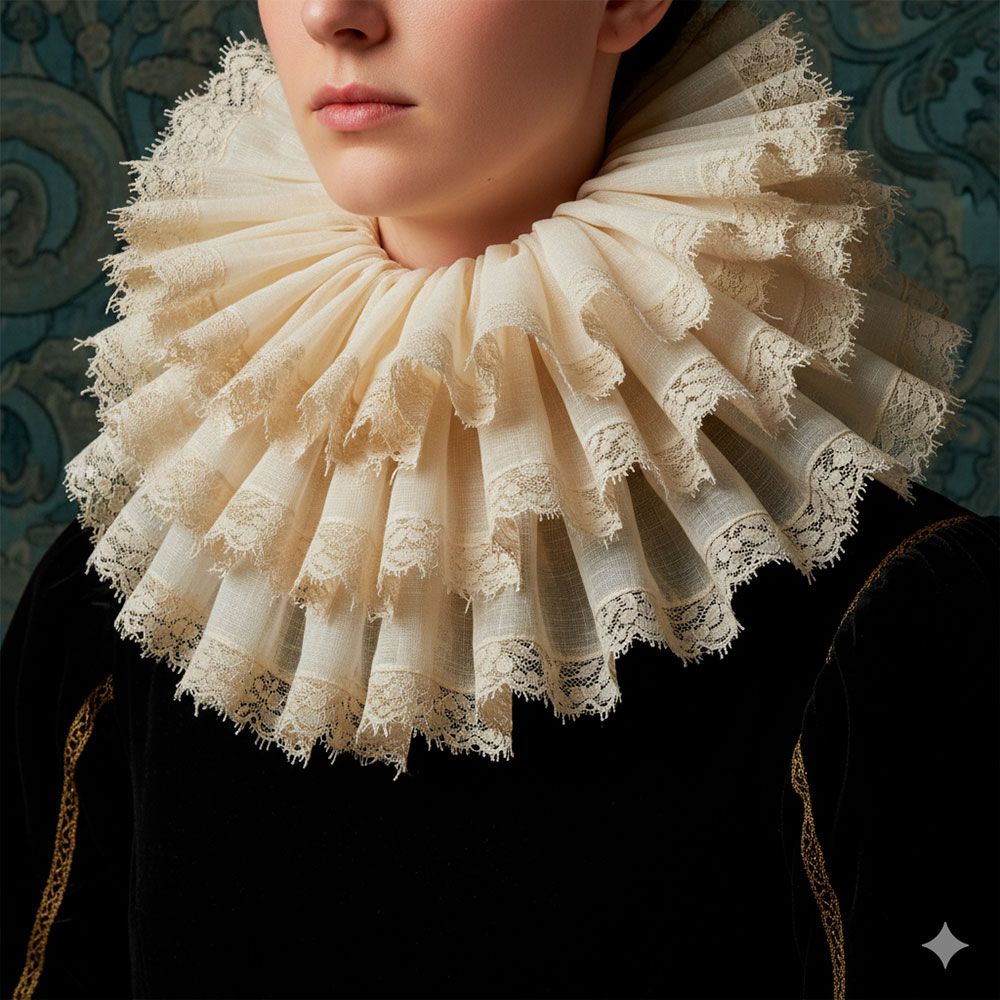
Historical and social context
- Origin and evolution: It arose from small ruffled edges on shirts and women's ruffs in the mid-16th century and grew until it became a separate piece.
- Spread: Originating in Spain, the fashion spread through European courts (England, France, the Low Countries, Italy), where it became an emblem of status.
- Social meaning: The size and perfection of the lechuguilla equated to an indicator of wealth and rank: the larger and more elaborately worked, the greater the ostentation.
- Regulation and replacement: Costly maintenance and moral or sumptuary rules led to regulations; in some courts its use was limited and it eventually gave way to less voluminous collars, such as the valona.
How to recognize it in portraits
- It appears as a ring of flounces or concentric bands around the neck, often contrasting with the face and hairstyle.
- In official portraits it is associated with high-ranking figures: kings, nobles and court ladies.
- Relevant details: the texture of the fabric (lace or linen), the symmetry of the folds and the degree of starching are clear clues for identification.
Presence in art and cultural memory
The lechuguilla occupies a prominent place in the iconography of the Golden Age and the late Renaissance: numerous portraits immortalize it. Through painting and clothing documentation we can trace its evolution, symbolic impact and its gradual decline as fashions changed.
| Aspect | Lechuguilla | Valona |
|---|---|---|
| Form | Rigid hoop, curled and voluminous folds. | Less voluminous collar, with softer, more practical folds. |
| Material | Fine linen, pleated lace; heavy starching. | Lighter linen or lace; less starch. |
| Social function | Symbol of ostentation and high status. | A more sober and manageable alternative. |
| Period | Late 16th century — early 17th century. | Replacement and fashion following the lechuguilla. |
Quick facts
- What is it? A rigid, ruffled collar, separate from the garment.
- Key period: Second half of the 16th century and early 17th century.
- Meaning: A material manifestation of status and courtly fashion.

















